Let the good times roll
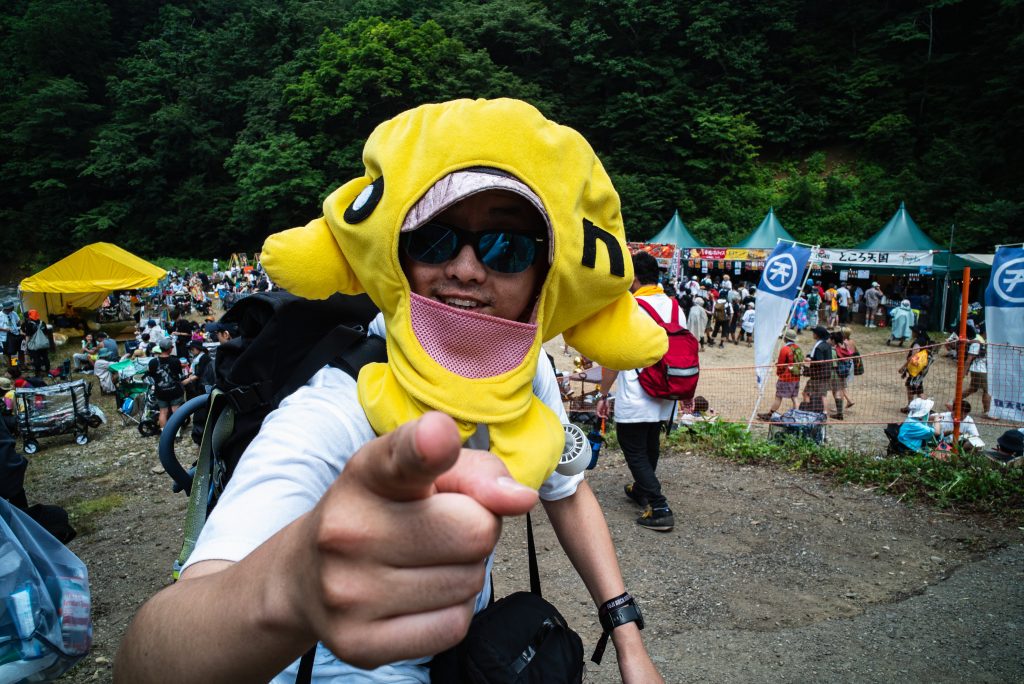
Welcome to the Japan Times live blog of the 2025 Fuji Rock Festival. We’re out and about, checking the sights and sounds. Follow @japantimesfuji for more.

Welcome to the Japan Times live blog of the 2025 Fuji Rock Festival. We’re out and about, checking the sights and sounds. Follow @japantimesfuji for more.
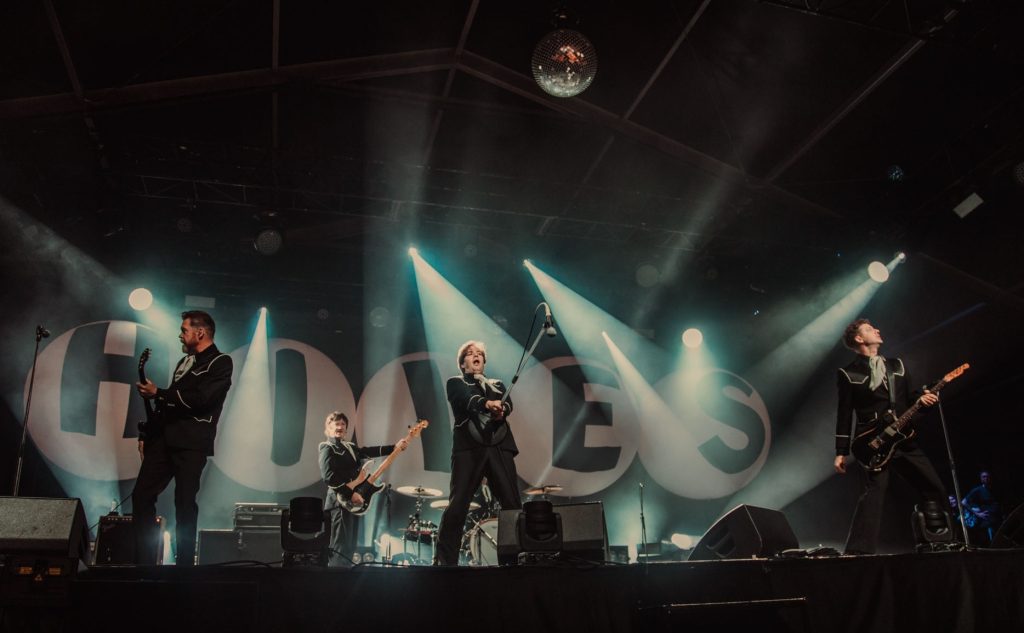
Howlin’ Pelle Almqvist, lead singer and chief comedian of Swedish garage rockers The Hives, told the capacity audience at the Red Marquee that this was the group’s first appearance at Fuji in 19 years, which thus qualifies The Hives as this year’s closest thing to a legacy act, at least among the lineup’s rock contingent.
The group wasted no time in getting the crowd pumped and screaming. They seemed to know all the songs, so Almqvist didn’t even have to prompt them. Pitchman that he is, Howlin’ Pelle kept plugging the band’s upcoming new album, which no one really cared about because it’s all the same crunchy riffs and huge guitar gestures with Almqvist high-kicking to the beat. Not bad for a band that recently celebrated its 30th birthday.
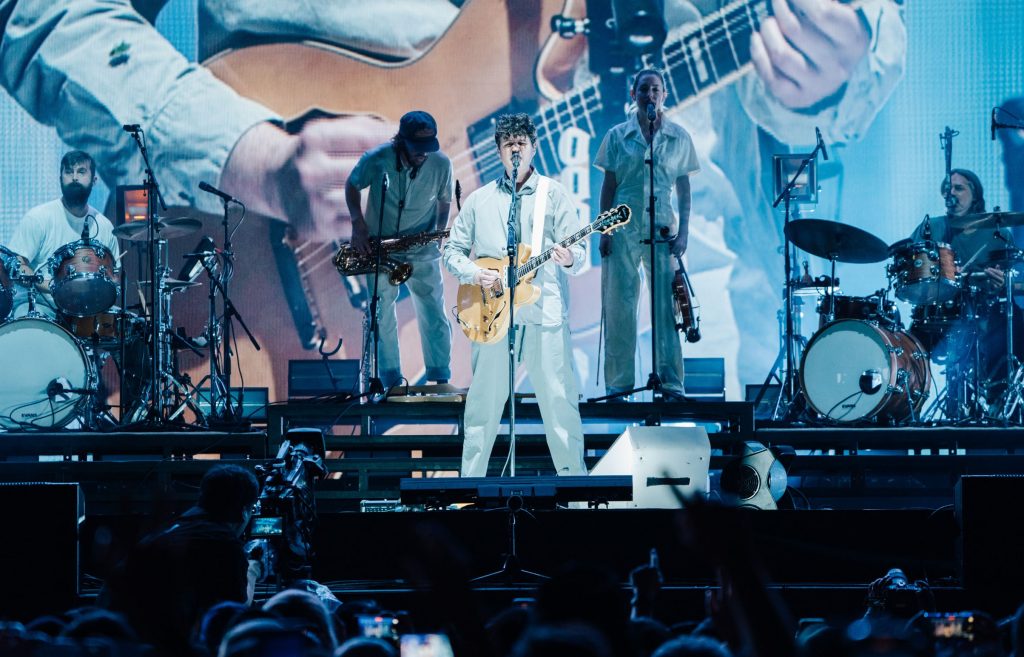
The Green Stage headliner on the last day was Vampire Weekend, who have come a long way since their scrappy indie days. They had grand pianos and extra musicians. They even had a dancer. Ezra Koenig was an affable host, introducing the songs by name and designating which of their five albums they were from. Though it was tasteful to a fault, a lot of people found reasons to dance and a few even sang along to “Oxford Comma,” which by now qualifies as a golden oldie.

The Haim sisters, who headlined the White Stage, may have been the most unabashedly excited act of the weekend. Despite projections on the back screen of variations on the title of their latest album, “I Quit” (“I quit all relationships”), they just wouldn’t. The group’s sunny California sound somehow worked well with the whole anger thing, but in any case they were so riled up that the audience couldn’t quite keep up with them as they switched instruments continuously through the set.
Given that they’re sisters and all sport long brown hair, it was probably difficult to tell who was who from the back, which is where we were standing, but they created such a united roar of rock that it didn’t make any difference. They also wouldn’t stop enthusing about being at Fuji Rock, which seemed to be a dream come true. “You’re awesome,” one of them kept saying, over and over — or maybe it was all three of them.

The sun was back Sunday morning and while clouds were always moving in, rain didn’t materialize. We checked out Mei Semones at the Red Marquee just after noon. Given the hangover state of many of the Fuji diehards, Semones’ jazzy indie pop, with heavy doses of bossa nova, was particularly soothing, though it was her command of Japanese — her impressionistic lyrics are in both English and Japanese, often in the same line — that made the deepest impression on the capacity crowd. Semones’ music is lulling and often soporific, but if all you had to go by was the reaction of the crowd, you’d think she was a rock god.
Later that afternoon on the same stage the Mercury-winning Brit band English Teacher really did try to summon the spirits of rock with a capital R, though being a decidedly album-oriented band they mixed the excitement of postpunk with often contemplative slower songs. It’s hard to say how much the crowd got, but they definitely reacted electrically to their more rocking material.
Another Mercury winner, Little Simz, soon materialized on the Green Stage just as the sun was going down. A resolutely emotional rapper, Simz betrayed more self-consciousness than you average MC, though she kept throwing down challenges that the huge Green Stage crowd rose to with bracing brio. Consequently, she grew more confident with each song and eventually let down her guard, beaming a full-bore smile to an enthusiastic audience she probably didn’t expect. It made an impression that maybe even she didn’t understand: The audience loved her candor and her capability to expose herself for the sake of love. And the audience genuinely loved her.
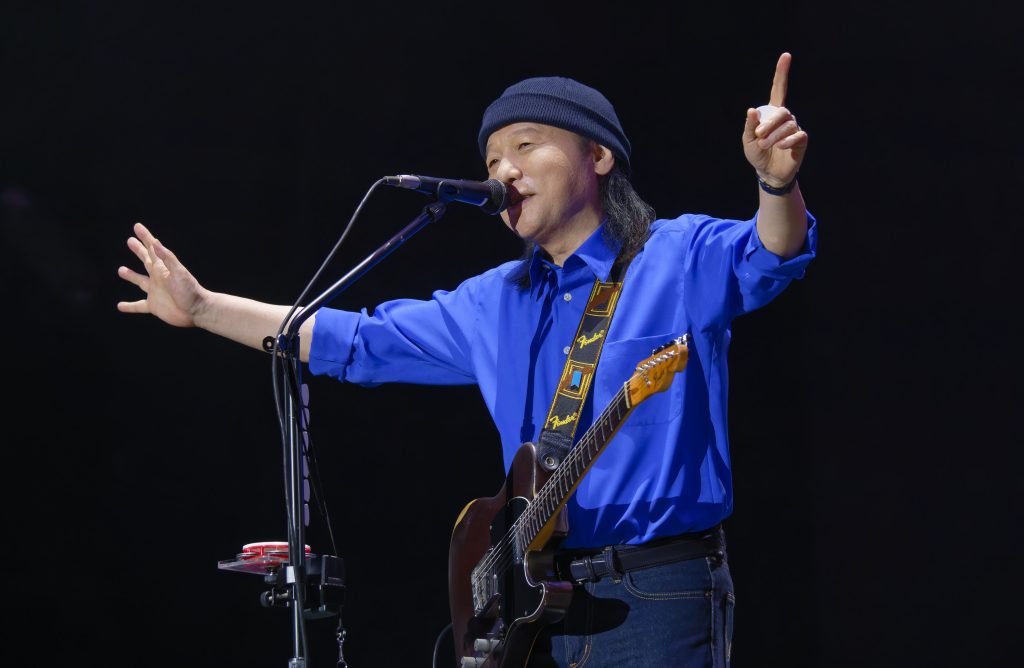
As already noted, one-day tickets for Saturday were sold out, and if any one artist on the day’s roster was responsible it was probably Tatsuro Yamashita, one of the architects of city pop, who rarely plays live any more. The rain had stopped by the time he showed up on the Green Stage at dusk below red-tinged clouds. The crowd was densely packed and rapturous. Yamashita, wearing jeans and a watch cap, looked to be in exceptionally good shape for a septuagenarian, but more importantly his voice was as supple and pliant as it was when he was a youngster.
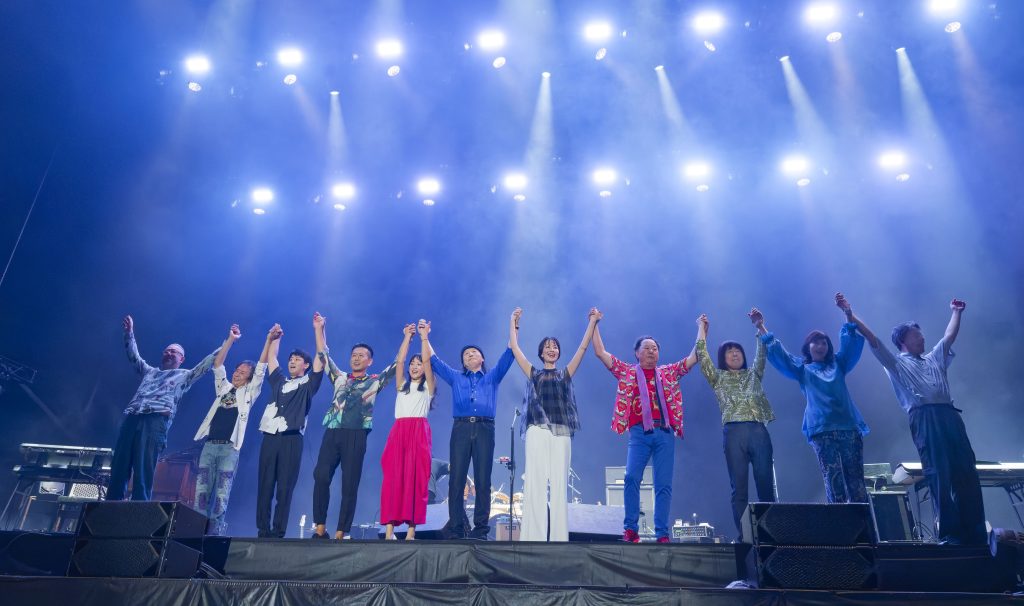
He played his hits and brought out his wife, Mariya Takeuchi, as a duet partner and backup singer, which got a lot of applause since in many ways she’s more famous than he is. Yamashita’s band, many of whose members are as old as he is, were also in fine form and got funky when the song demanded it. The smiles were contagious and irresistible.
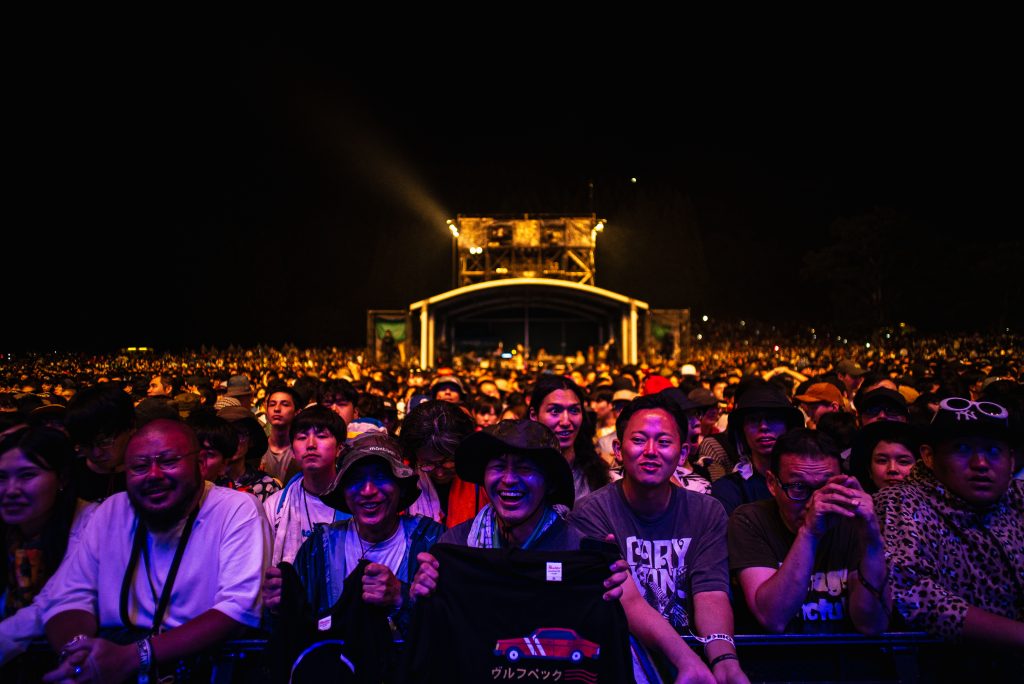
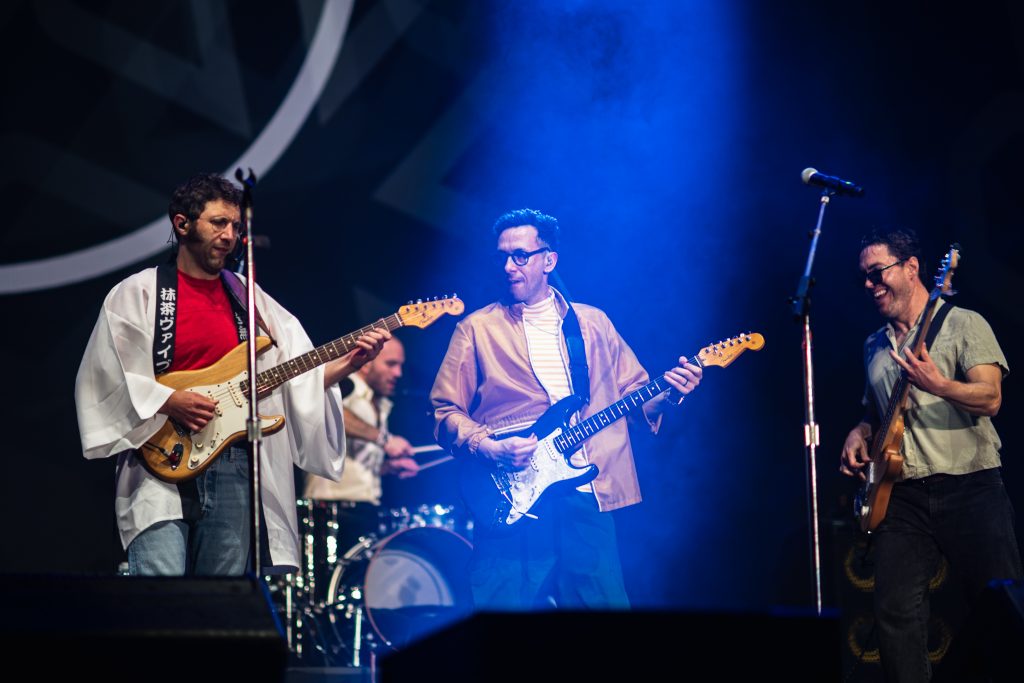
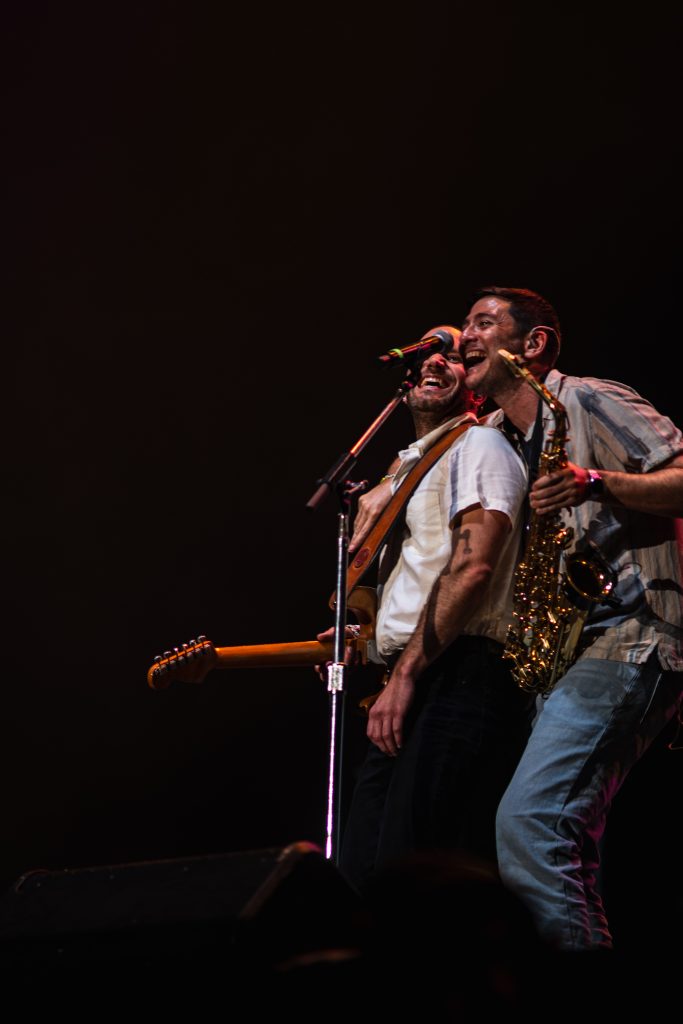
But Yamashita wasn’t the designated headliner. Vulfpeck, an American collective that plays funk almost exclusively, was, even though they don’t have what one would call a following in Japan. Still, people seemed to know what to expect and were dancing from the get-go.

The headliner over at the White Stage was Four Tet, better known by his friends and family as Kieran Hebden. It was a stylish and eclectic set of electronica that mostly stuck to danceable material with plenty of break beats.
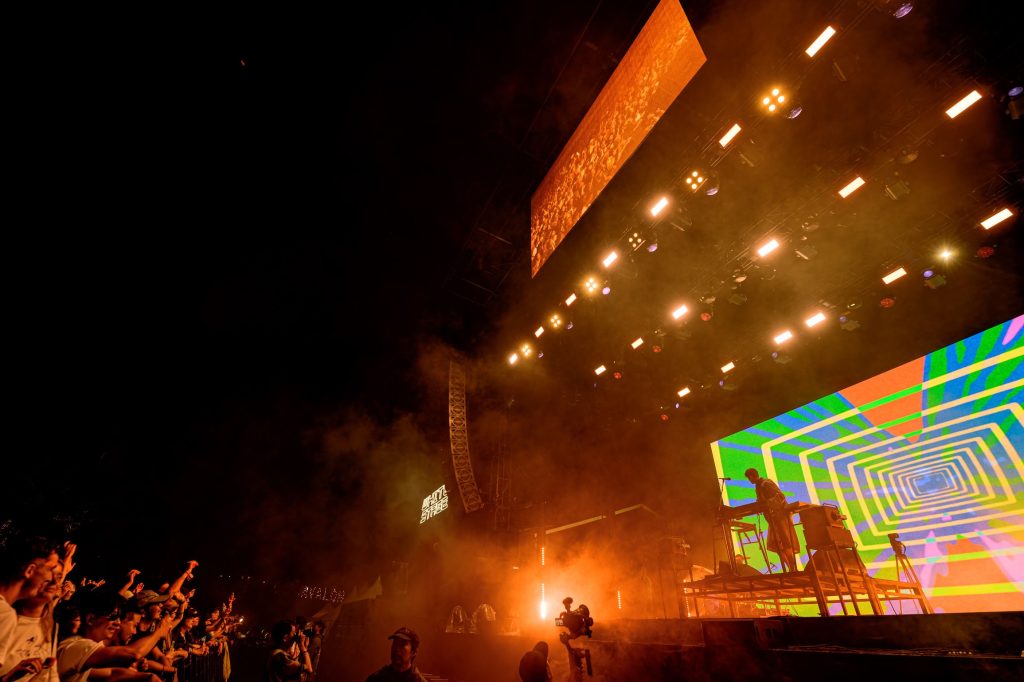
Hebden himself was mostly invisible behind his decks, so in way it could have been anyone up there, but the ease with which he transitioned from one pattern to the next is pretty much his strength as a musician and difficult to copy.
The avant-punk band YHWH Nailgun (pronounced Yahweh Nailgun), played at the Red Marquee at 2:00 pm when it was still hot outside. By the time they finished 45 minutes later, it was still hot outside, but it would start raining soon. Despite their very unconventional take on punk, the audience soaked it up in a head banging way. Lead singer Zack Borzone writhes and convulses in line with the group’s fitful industrial rhythms, screaming incoherent lyrics into space. It was bracing stuff and we admire the folks in the shed who actually tried to dance to it.
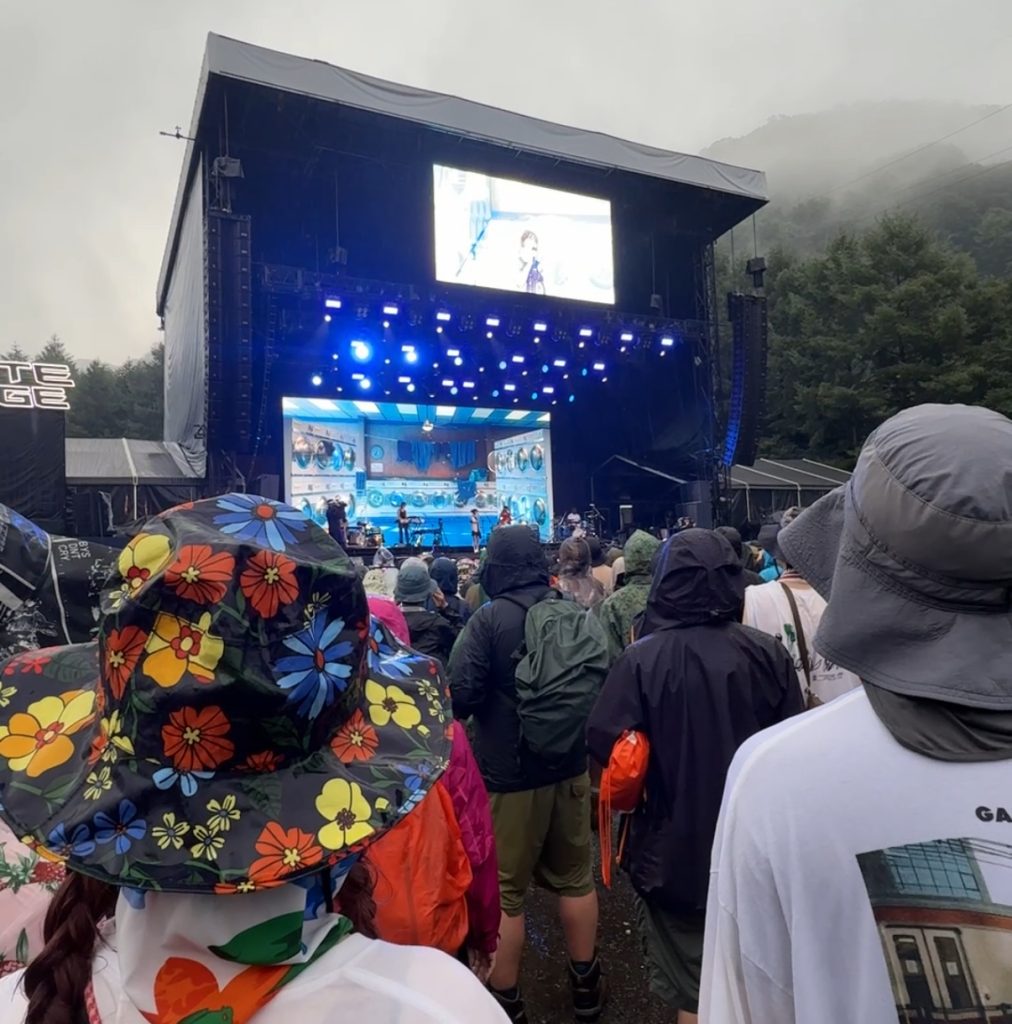
By the time Faye Webster took the White Stage it had already been raining fairly heavily and continued doing so through her set. (The laundromat backdrop was appropriate seeing as we had all really been thoroughly soaked by the downpour.) The sizable crowd was even more subdued due to the precipitation, but Webster’s quiet soft rock doesn’t provoke a big reaction anyway. As expected she brought out Japanese singer-songwriter Mei Ehara, with whom she’s worked before, for a duet.
Mike Hadreas, aka Perfume Genius, ruled the Red Marquee around dusk as the sky outside turned purple. A fitting color considering Hadreas’s dramatic stage presence and the melodramatic tone of his songs, which range from gentle piano ballads to full-on glam rock.

Twisting and writhing in line with the tenor of a song, he seemed almost elastic onstage, and the crowd absolutely adored it, cheering every dying swan routine and impossible arched back swoon. Skinniness was never so sexy.
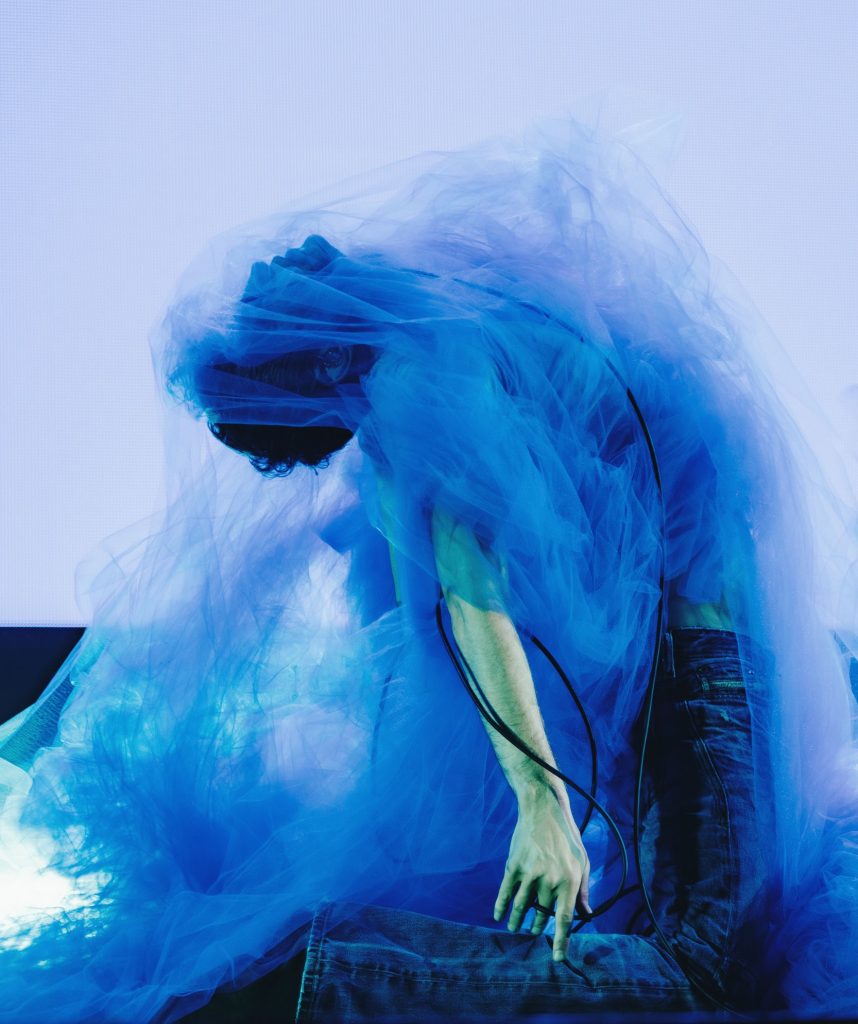
OK Go’s early evening set at the White Stage was well attended by a very polite crowd that was obviously into the American band’s punchy power pop, though it would have been hard to tell if you only heard the show and didn’t see the swaying, bopping bodies.
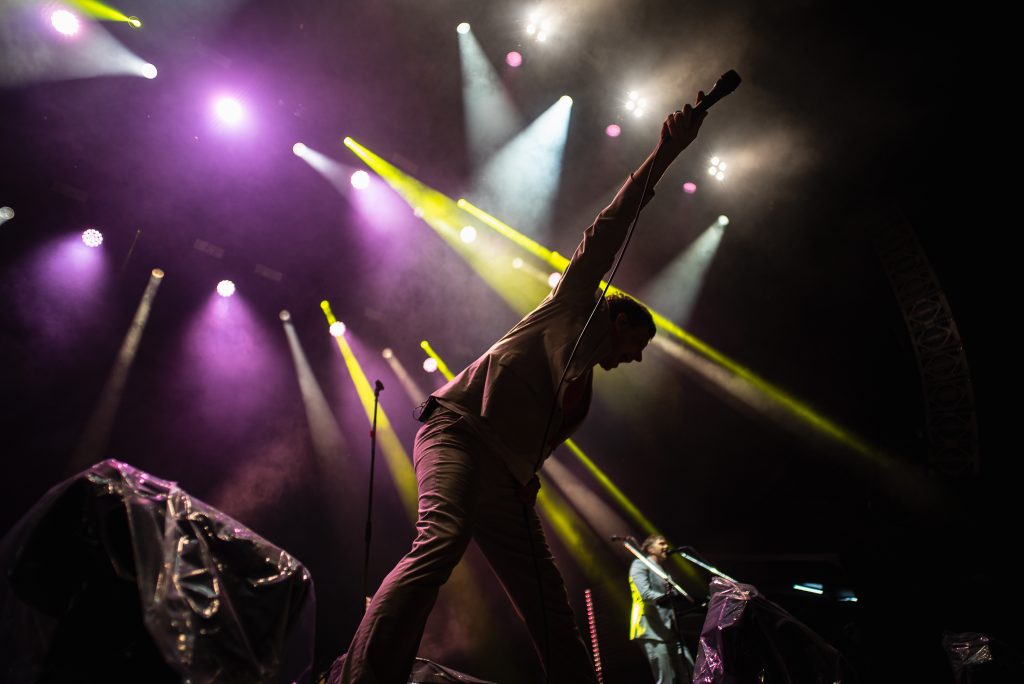
Ably assisted by bassist Tim Nordwind’s fine soprano backing vocals, the group’s aural component was studio perfect. Leader Damian Kulash tried to connect with the audience directly by asking if there were any questions. Some wise guy asked what their favorite Japanese food is and each member answered appropriately, though drummer Dan Konopka was the most honest: “Beer,” he said.
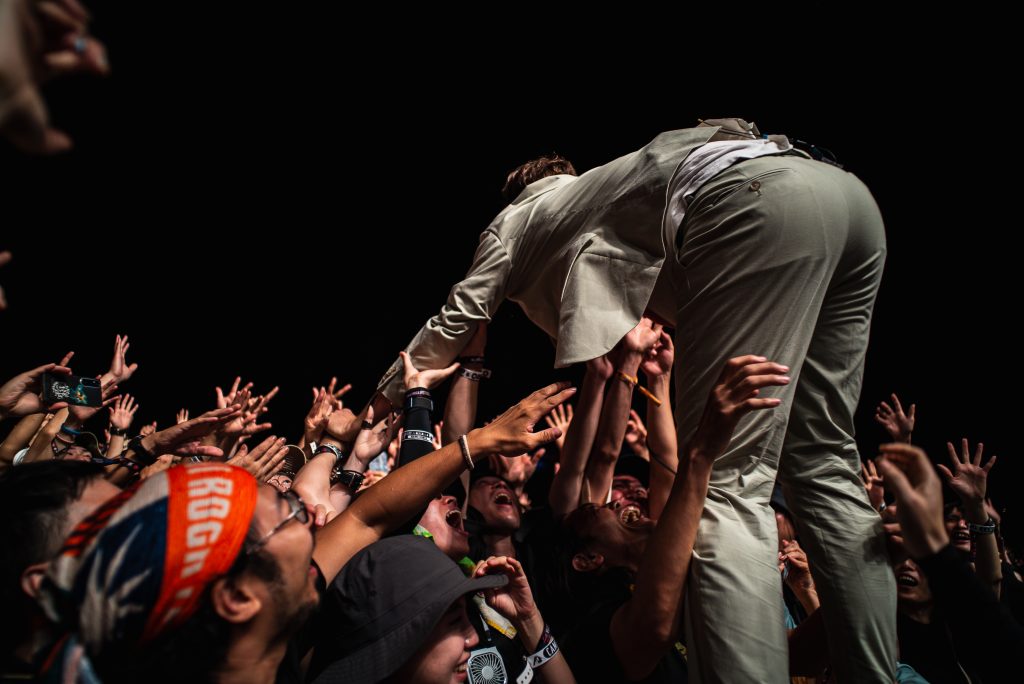
Apparently, there were electrical issues all day at the Green Stage, thus forcing Fred Again’s set to be pushed back by 90 minutes. We caught Ezra Collective’s set at the Field of Heaven. Though ostensibly a jazz group bassist-spokesperson TJ Koleoso insisted that the Field become a big dance hall, and they definitely brought the funk while trying out rock concert moves — getting the entire audience to squat and then jump up on cue, that sort of thing—that everybody was totally cool with. We only caught a bit of Fred Again’s set at the end, but though he’s categorized as a dance artist, Ezra got more bodies moving in our estimation.
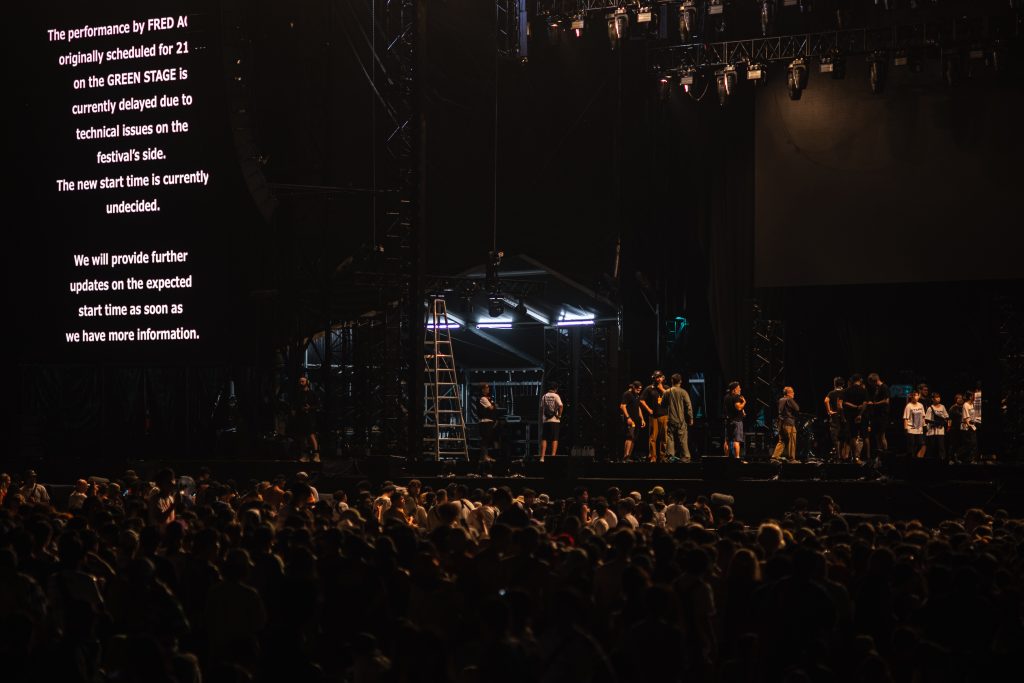
But the highlight of the day may have been Shintaro Sakamoto’s midnight gig at the Red Marquee. The shed was predictably packed and the self-effacing former Yura Yura Teikoku leader eschewed the psych rock his old band was famous for, concentrating solely on his solo material, which leans heavily toward yacht rock. A fantastic guitarist who can move from delicate melodic riffs to sky-high note-bending, he and his very able band just kept going from strength to strength, and all without the usual Japanese stage chit-chat. It was serious pop music, which means everyone left very happy.

At first, it seemed like a lost opportunity to schedule the Argentine pop duo Ca7riel and Paco Amoroso in the morning, but it actually was a stroke of genius. Saturday is traditionally the most crowded day of the festival for obvious reasons, and today is sold out. C&PA thus were charged with getting the crowd in the proper mood to last the rest of the day, and they passed with flying colors, especially pink, which Ca7riel sported in an enormously puffy air-conditioned jacket and slacks combination. Paco was all in black, though the weird shapes coming off his costume made him look like a Takashi Murakami figurine. The fact that they stayed seated for the first half of their hour-long set didn’t discourage the audience from dancing themselves, which they did with total abandon, and all the way up to the tree line.
We assume we have Sony, their label, to thank for the translated lyrics on the jumbotron screens. Lots of good-natured sexual content there, and while the duo’s music zigzags from hip-hop to smooth R&B to raunchy rock and several species of Latin dance music, it’s all wrapped in a sardonic tone. The reason they’re so easy to love is because they make you feel you’re in on their secret joke. And once they stood up and started dancing themselves, Ca7riel’s bounce contrasting fully with Paco’s swish, it was already party. In fact, the problem may be that the crowd would be too exhausted to last the day. Maybe the best opening Saturday set we’ve ever seen at Fuji
The crowd at the White Stage for opener Basque ska-punk Fermin Muguruza was much smaller but quite a bit livelier. We saw our first mosh pit of the day, which is saying something considering how hot it was. Stridently political, Muguruza covered the waterfront so to speak, ranging from Kurdish independence to chants of Free Palestine! to name-dropping important figures of the revolution. Rumor has it that he’s finally retiring, but despite the grandfatherly aspect, he still puts on a fiery show and got the kids, as well as few ojisans, pogoing enough to kick up some dust. Viva la Revolucion!
After a brief light shower on Friday afternoon, the sun came back out with a vengeance. The White State was even hotter after the South African-Australian singer-songwriter Ecco Vandal started her set. She and her two resourceful sidemen delivered a canny blend of metal rap, reggae and pop fizz, and while the crowd was fairly thin they were a game group. The extra space was just right for dancing.

The audience grew considerably for Niger master guitarist Mdou Moctar, who pretty much played the audience as skillfully as he did his instrument. Repetition is a plus with the so-called desert blues, and as his tight, rocking rhythm section kept up a solid wall of beat, Moctar kept shredding and shredding, until it seemed the distant thunder was a reaction to his powerful noise.

“You guys are the best,” he told the audience, meaning Japanese people, whom he genuinely admires. Twice he left the stage to play his savage solos surrounded by ecstatic bodies. There was a lot of heart in that show.
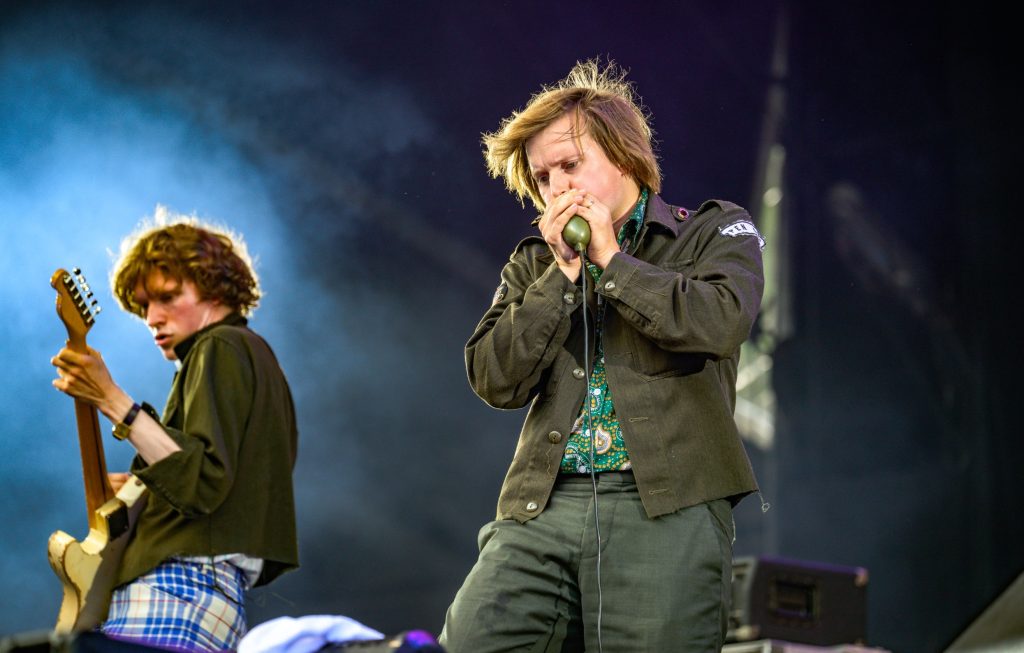
The first day of the festival opened under partly cloudy skies, with a sparse crowd gathered at the Green Stage for Danish blues garage rockers U.S., who also played Fuji last year. They’re becoming a habit, it would seem. They dedicated one song to Fuji Rock founder Masa Hidaka, who they said “is a lover of blues harp.”
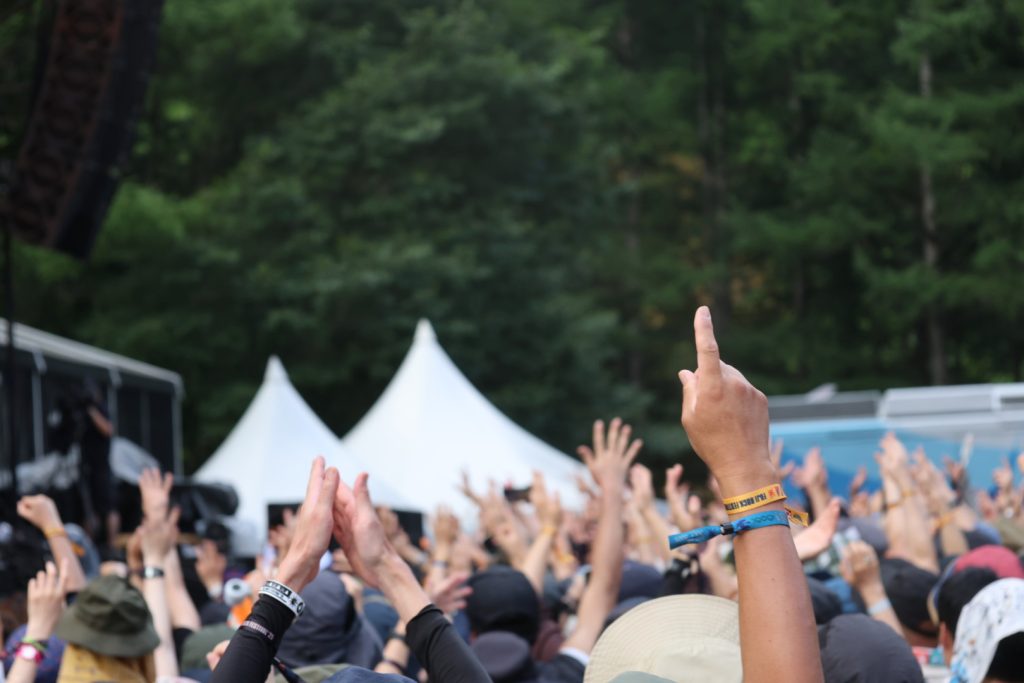
A rather different vibe commanded the White Stage soon afterwards when Otobake Beaver did their comical start-stop hardcore thing before a very large crowd as the clouds rolled in and thunder rumbled. Wearing colorful summer dresses and making sport of the long-haired middle aged guys in the audience, the quartet challenged the rockers to try and dance to their fitful music. Super entertainment for people with lethally short attention spans.
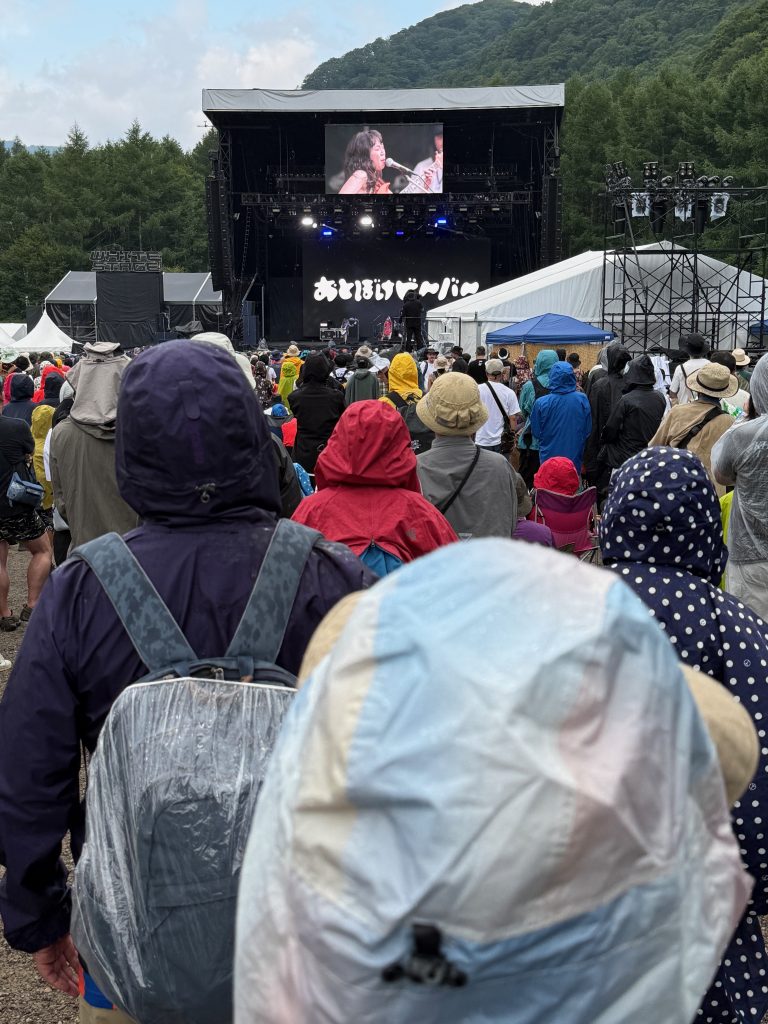
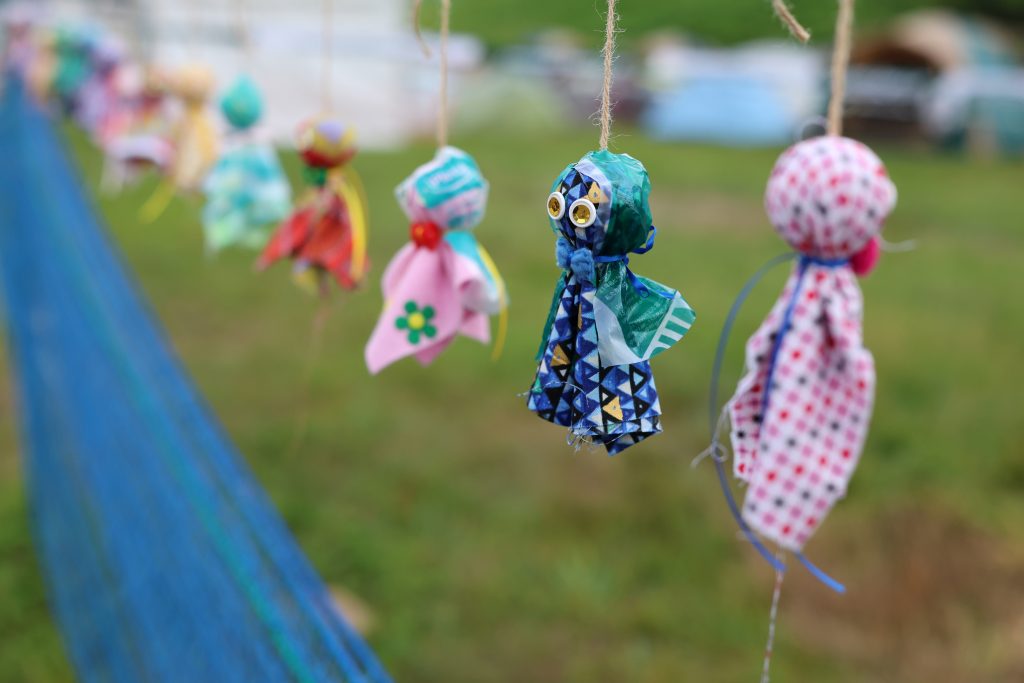
The pre-festival party, which is ostensibly thrown for the residents of Yuzawa, was packed this year. It was almost impossible to move around the Oasis, which is where all the food stalls are. We missed the bon-odori dance but managed to catch the fireworks that officially open the festival. It was a clear, cool night, which was pleasantly unusual, as there always seems to be a bit of rain the night before the festival starts.


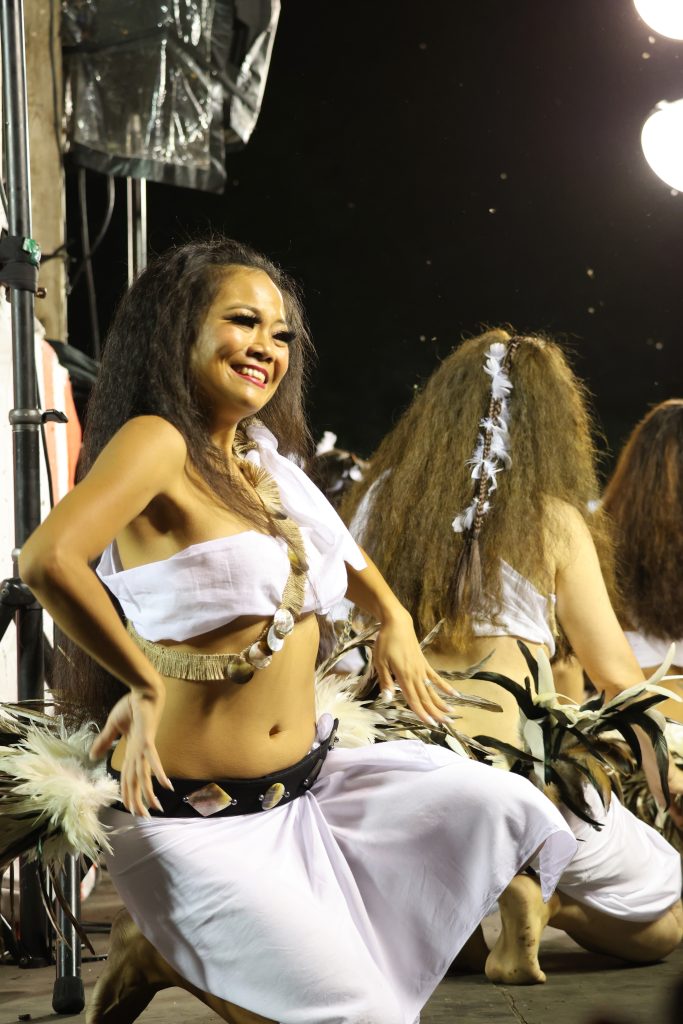
The music was — as usual — great. The pre-fest bands are always guaranteed to get the crowd moving. The Panturas, an Indonesian psych-pop band, opened the musical portion of the evening with a scorching set at the Red Marquee, and later Parlor Greens, an organ-guitar-drums trio that glided handily from Hendrix-style blues to old school soul with a lot of attitude, set the place on fire. It helped that Jimmy James is a human jukebox who could endlessly tease the crowd with classic riffs, from rock to hip hop. We were ably primed for the weekend to come.
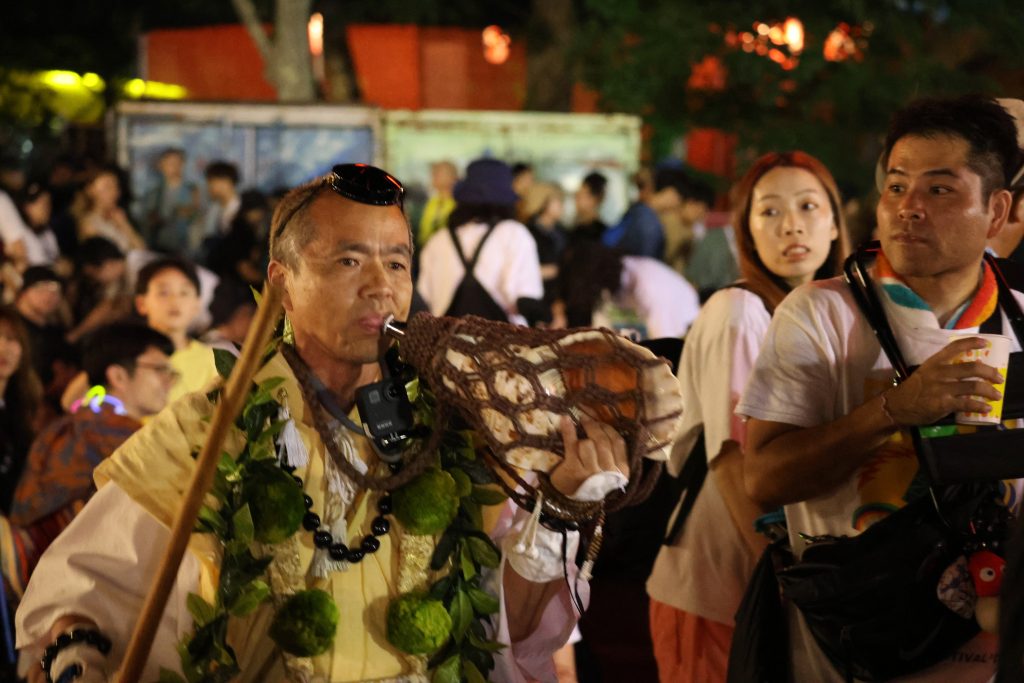
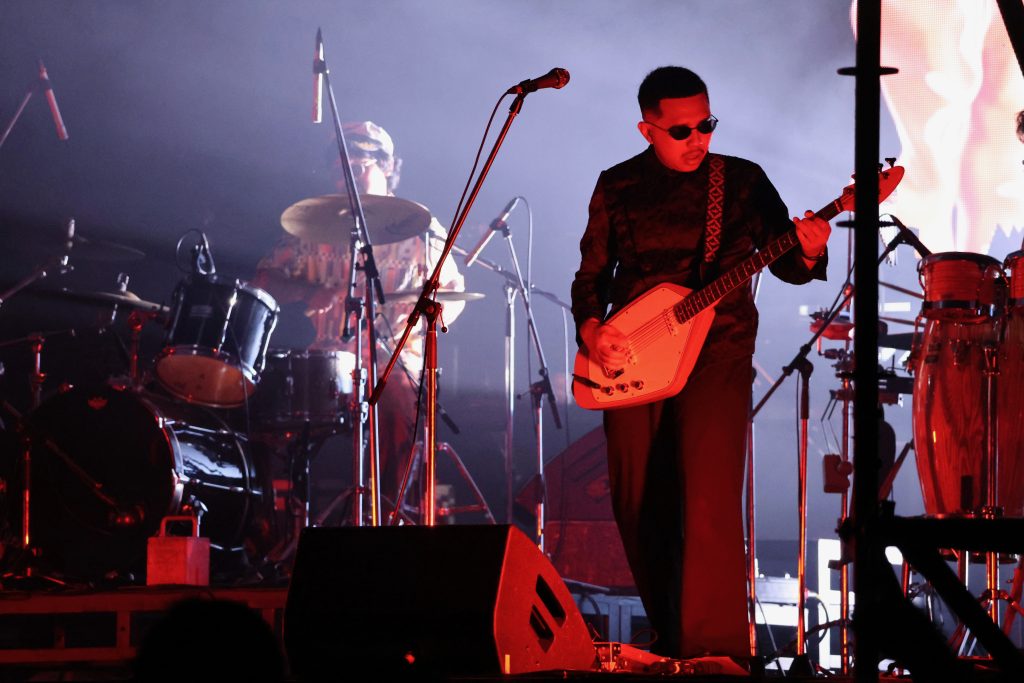
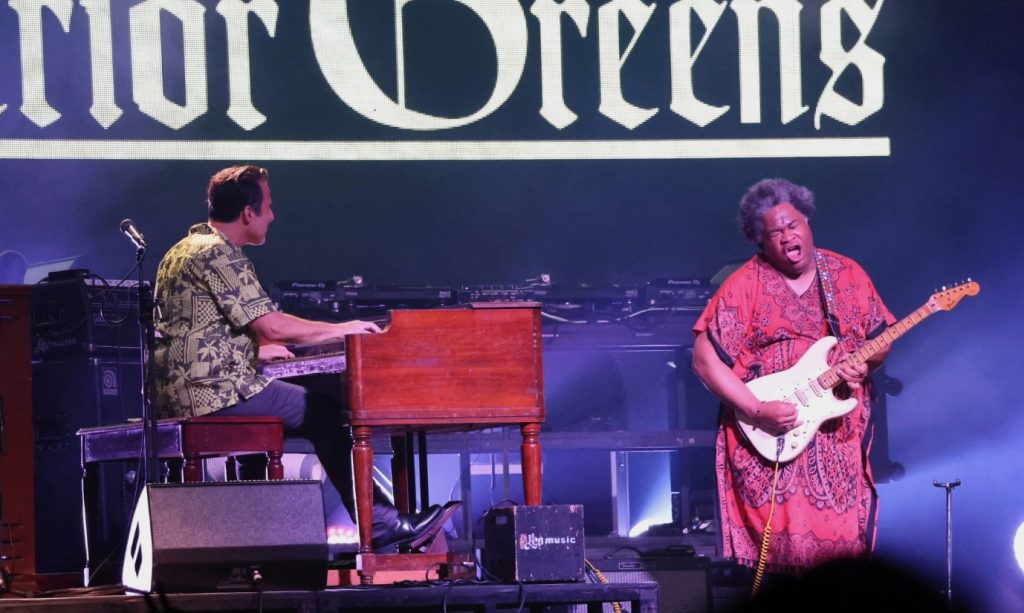
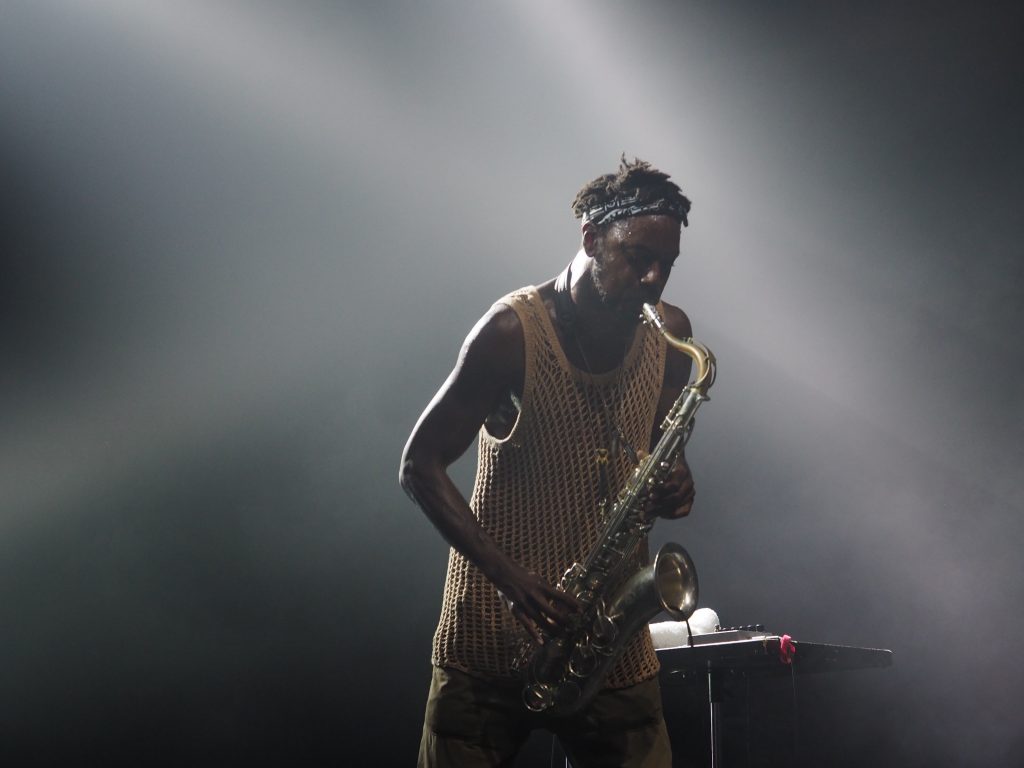
For reasons that remain unexplained, the London experimental trio The Comet Is Coming started their late-night Red Marquee set about 15 minutes earlier than scheduled. Consequently, we arrived in the middle of a song that had already climaxed dramatically. It was a bit of a letdown, since the whole point of the band is the way they build to a chaotic finish.
But that’s slightly misleading, since Comet’s real achievement is how they start at 10 and just keep getting louder and wilder. The band’s focus is the keyboards of Danalogue the Conqueror, who seems to lead the group and has the most extroverted personality. On stage he stood behind his bank of instruments and made the most out of the band’s hip-hoppy grooves.
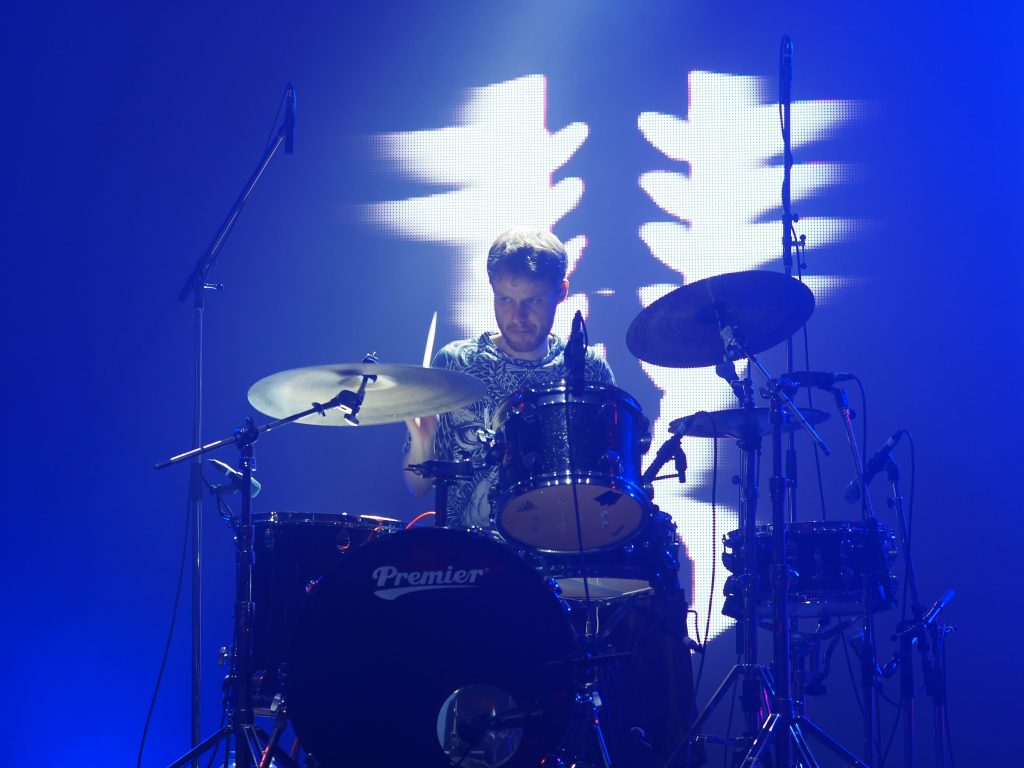


But the band’s secret weapon is saxophonist King Shabaka, whose wailing insistence never lets up, even when the arrangement calls for a bit of quiet. Though often categorized as jazz, the band’s music is more like garage rock taken to the extreme: The idea is to build tension until there’s nothing left to compromise. The audience dug the dynamic, but you could sense that some felt there was more to life than wailing incessantly for an hour.
The rest of us couldn’t get enough, and in that sense The Comet Is Coming is the jazz cognate of Death Grips, another trio that takes its chosen genre — hip hop — to extremes that no one else knew existed. The fact is, club kids like the ones who went crazy as Comet itself get their point probably better than bona fide jazzbos do.
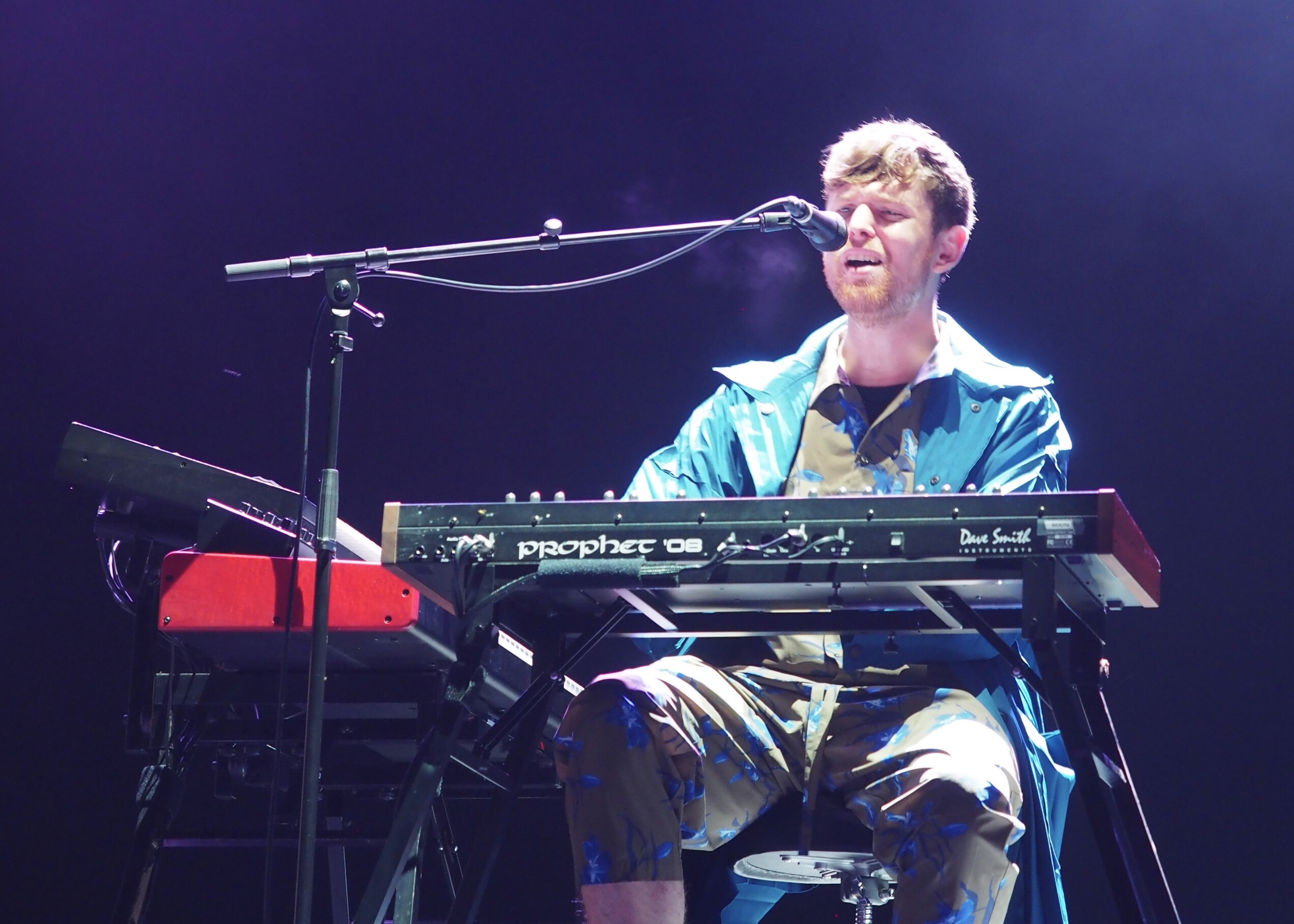
James Blake at the White Stage | Mark Thompson photos
James Blake doesn’t seem like the kind of artist who would headline a stage at a major music festival. His music is subdued, and he doesn’t possess the kind of personality that makes a show dynamic. Still, the White Stage field was packed for his Sunday evening show, and the audience waited patiently and quietly, because that’s the way he approaches his music.
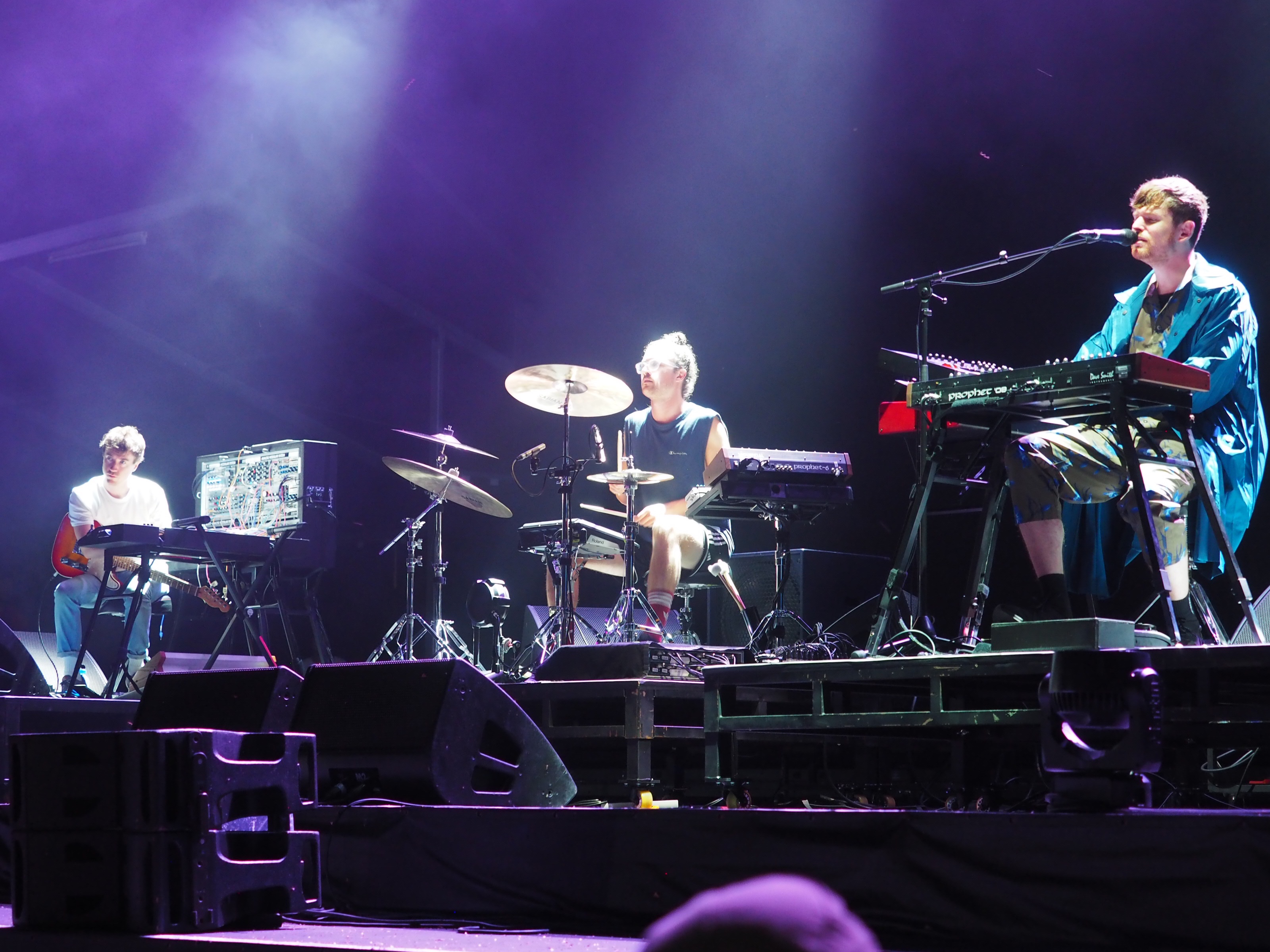
Blake is at heart a soul singer with a close familiarity with the appeal of classic R&B, but he’s also a pianist who likes complex chord structures and elaborate arrangements. His fans appreciate his emotional directness, which comes through in his pure tone, but he likes his electronics, too, and sometimes his use of them is even weirder than Thom Yorke’s. The only other people on stage were a drummer and a utility player who could handle everything from cello to an elaborate bank of dials and buttons.
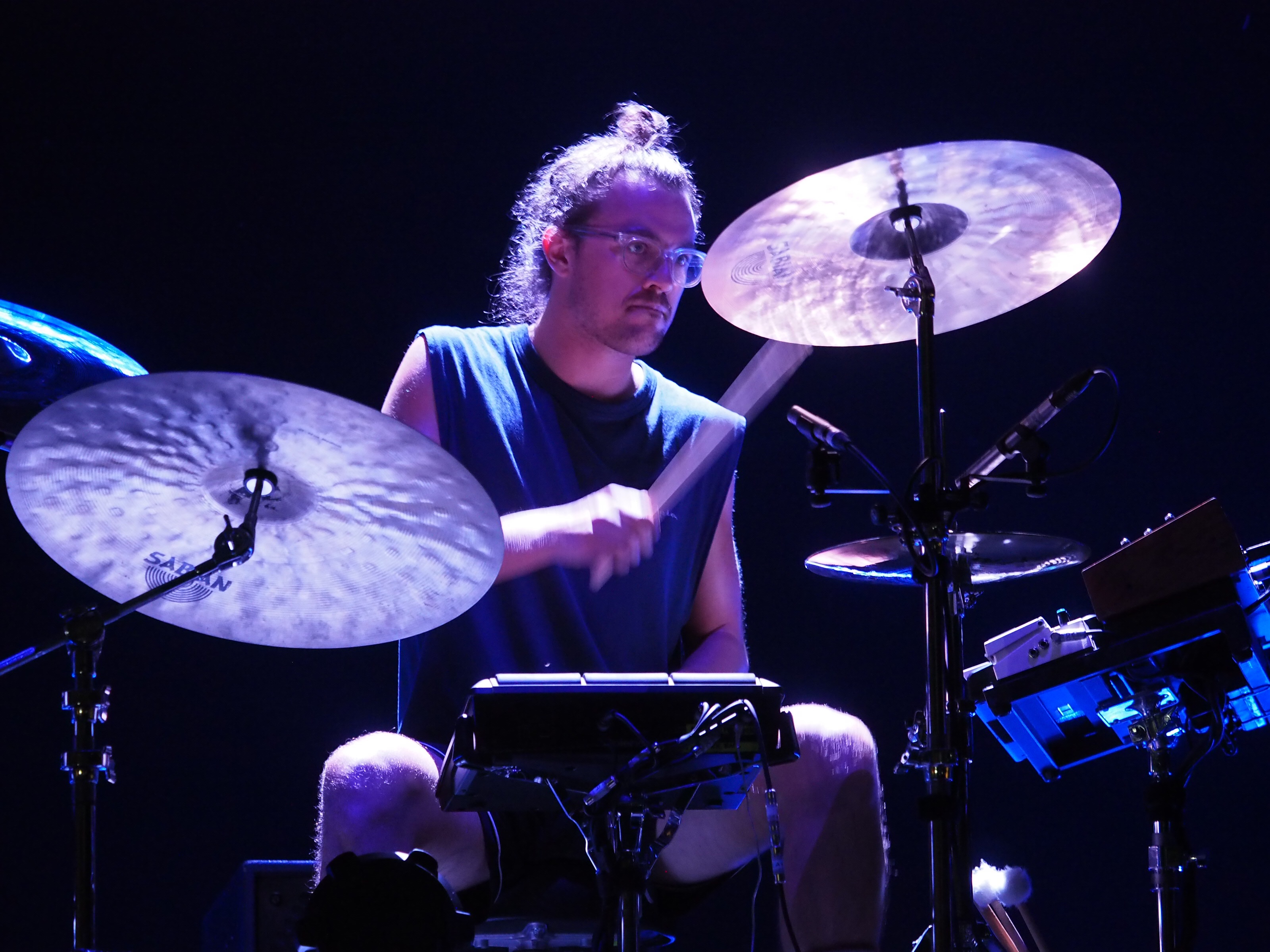
His affection for hip-hop is obvious, even if he lacks the kind of effusiveness required of hip-hop. He’ll never be a rapper, so he hires the best (Andre 3000 in this case) and even loops them for his concerts. And while subdued is the operative word, he can build up a head of steam and even jam when the occasion calls for it.
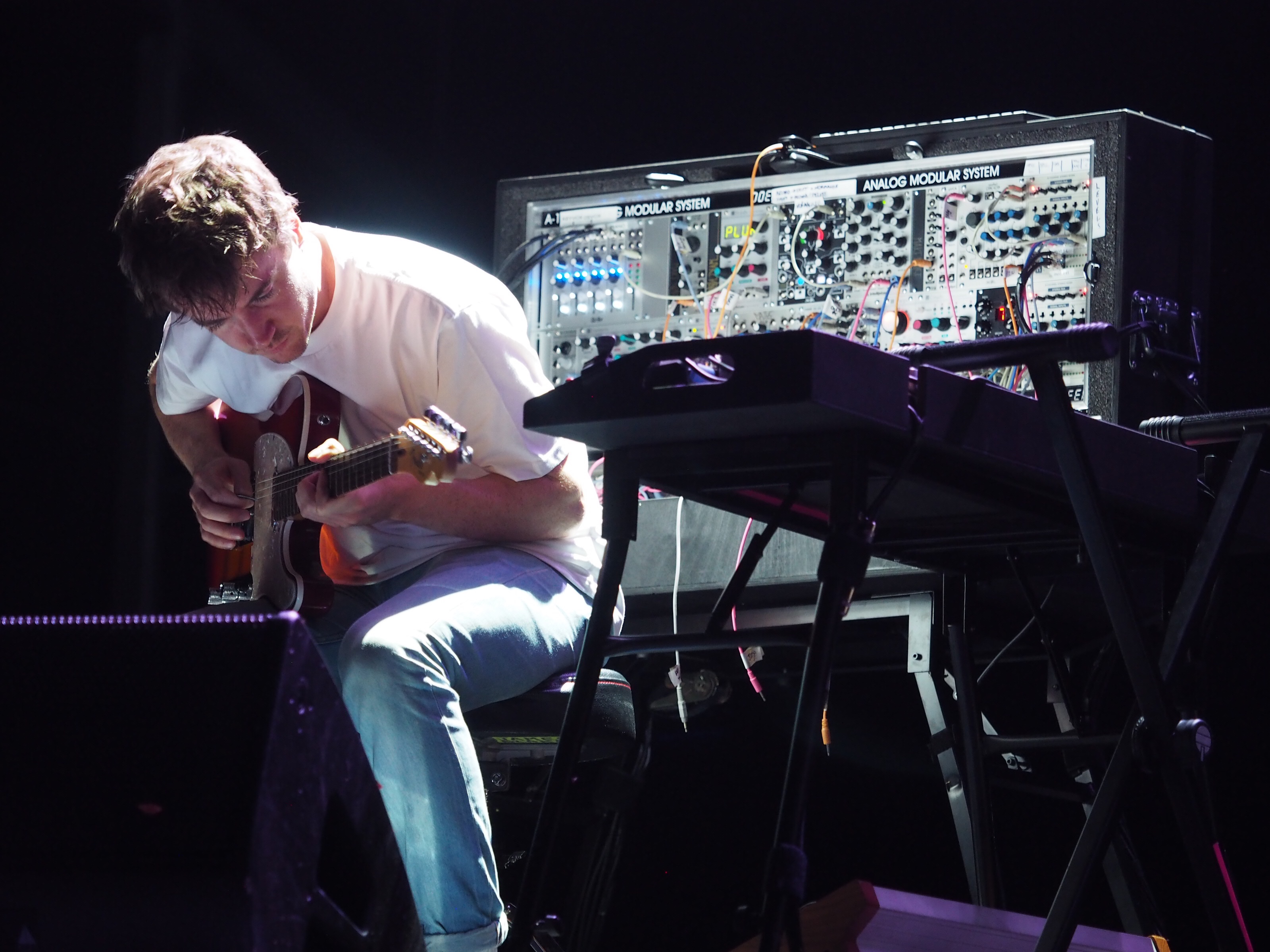
But it’s clear that what the audience wanted was the kind of cathartic emotionalism that made Blake’s name in the first place. He’s in his element when he’s heartbroken and ruminative. It’s an odd job description for a pop star, but you could tell the crowd was never happier than when he could barely express himself.

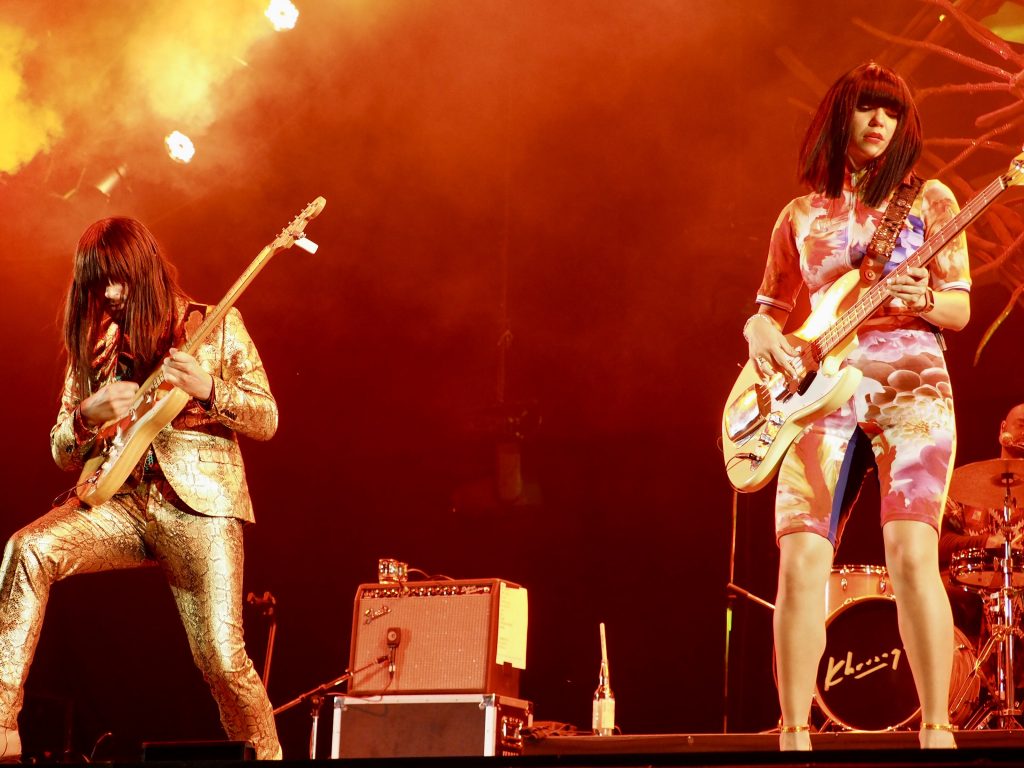
It’s important to remember that the Field of Heaven was originally conceived as a venue for Phish. They headlined all three nights at the inaugural Naeba festival on the Field of Heaven. Since then, Heaven has become associated with something broader: authenticity as characterized by blues, soul, world music, and not just general instrumental chops.
In a sense, Khruangbin, the Houston power trio who takes Asian pop forms and dubs them up into infectious guitar music, brings the Field of Heaven back to its roots. Though not technically a jam band, their reliance on improvisational interpretations of classic pop feels more genuine, and the huge crowd that showed up for their Sunday night gig was proof of that.
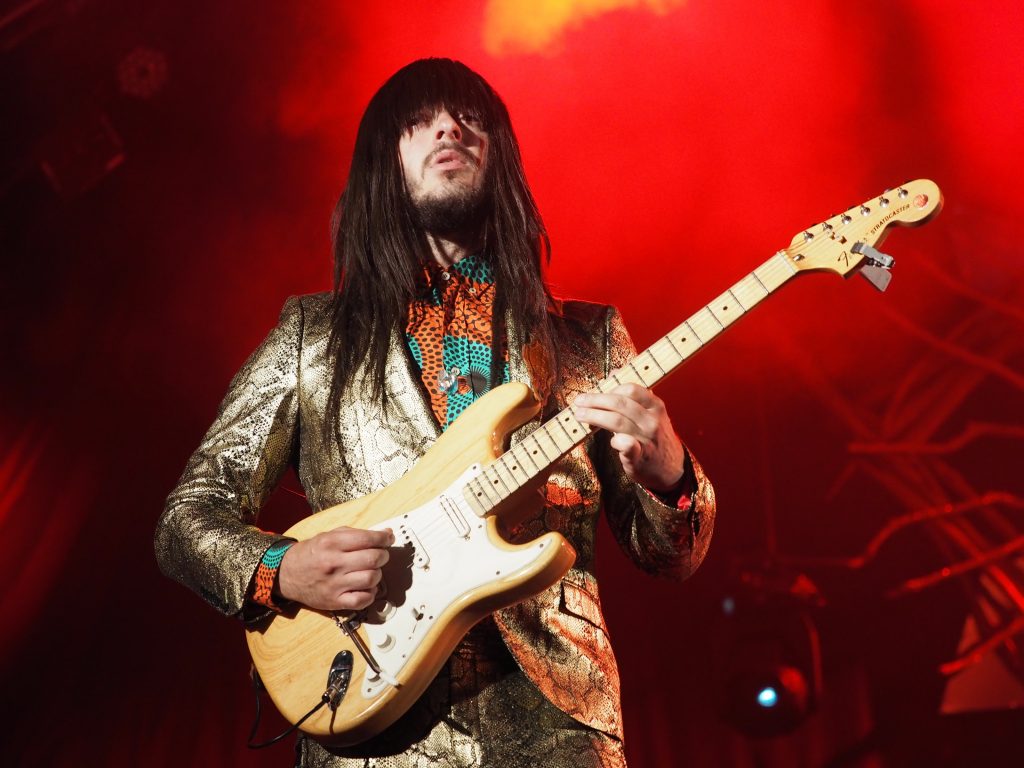
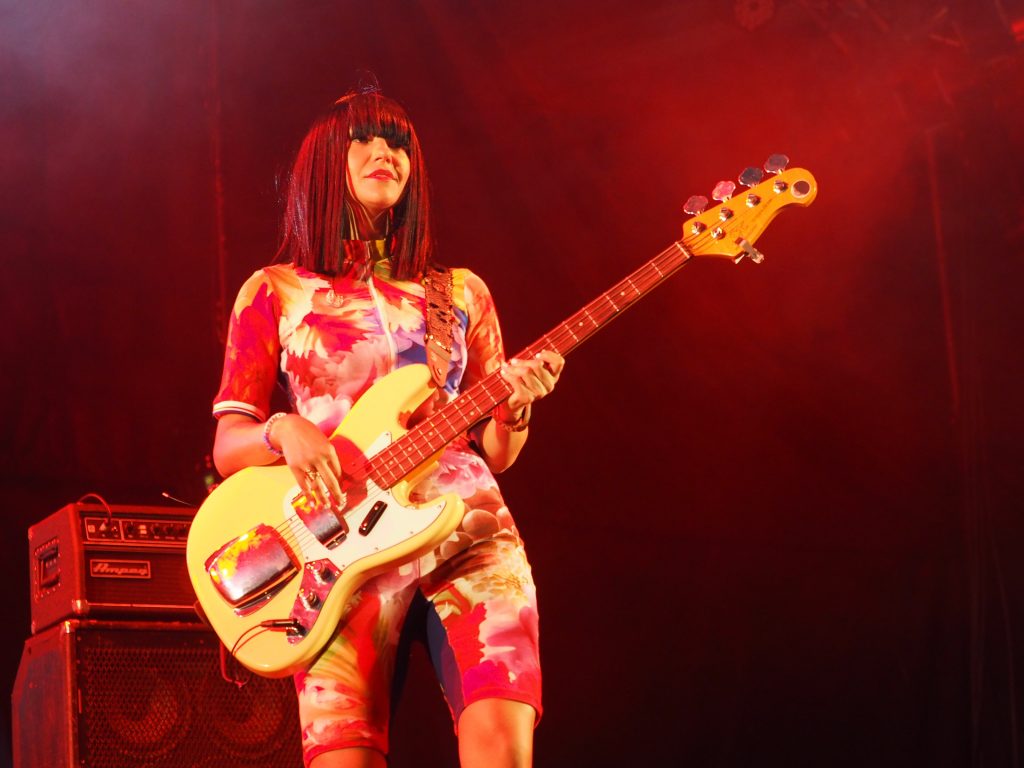
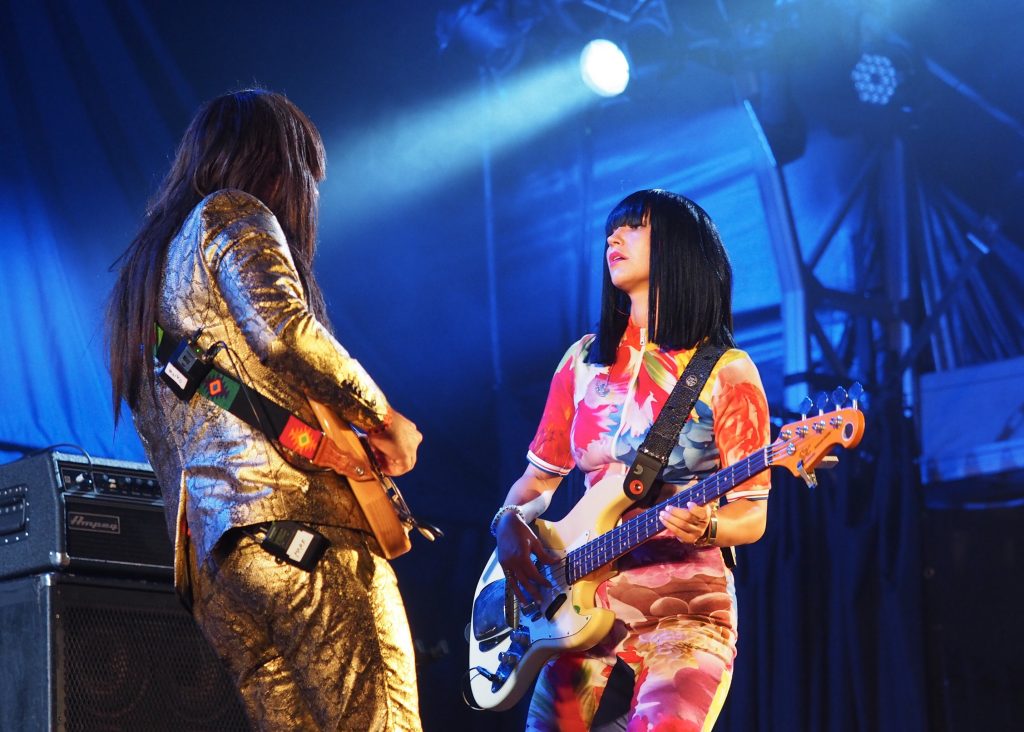
It’s also important to remember that the band is not as serious as they seem. Guitarist Mark Speer and bassist Laura Lee wore what might be charitably referred to as space drag — he dressed top to toe in gold lame with pointed shoulders, she in a kind of white-red Barbarella getup. They also wear those matching wigs, making them kindred spirits with Sia, that other anxious pop artist who appeared this weekend.
As the grooves developed and pulsed the pair would occasionally resort to sexy coordinated moves. At one point, when partaking of what looked like cocktails, they toasted the audience without missing a beat. When Speer finally addressed the crowd, it was as the coolest hippie in the joint. “Hey y’all, we’re really happy that you dig this groovy sound.” OK, well, that’s what it sounded like to me.
The point is that Khruangbin is not chops-oriented. They’d likely be laughed out of the jam band fraternity (though their drummer, Donald Johnson Jr., could probably get a job with any top notch funk or jazz outfit), but they understand the vibe that presides at the Field of Heaven, a place where the Fuji Faithful go to lose themselves in expansive music. This was that place.
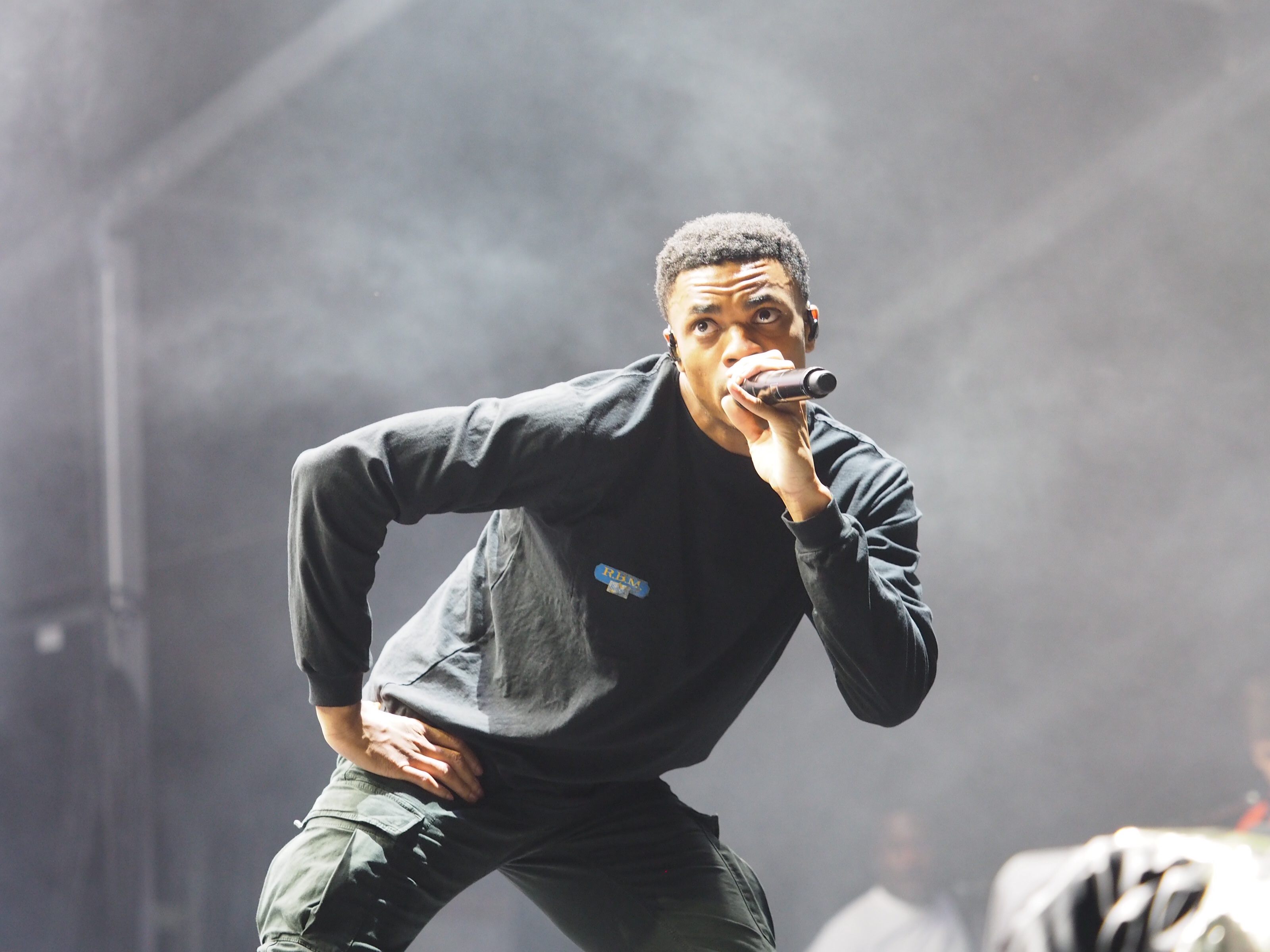
It’s perhaps understandable that Vince Staples, one of the moment’s most vital rap stars, wasn’t sure if he’d ever been to Japan before. “I think it’s my first time here,” he said early into his hour-long set at the White Stage Sunday evening.
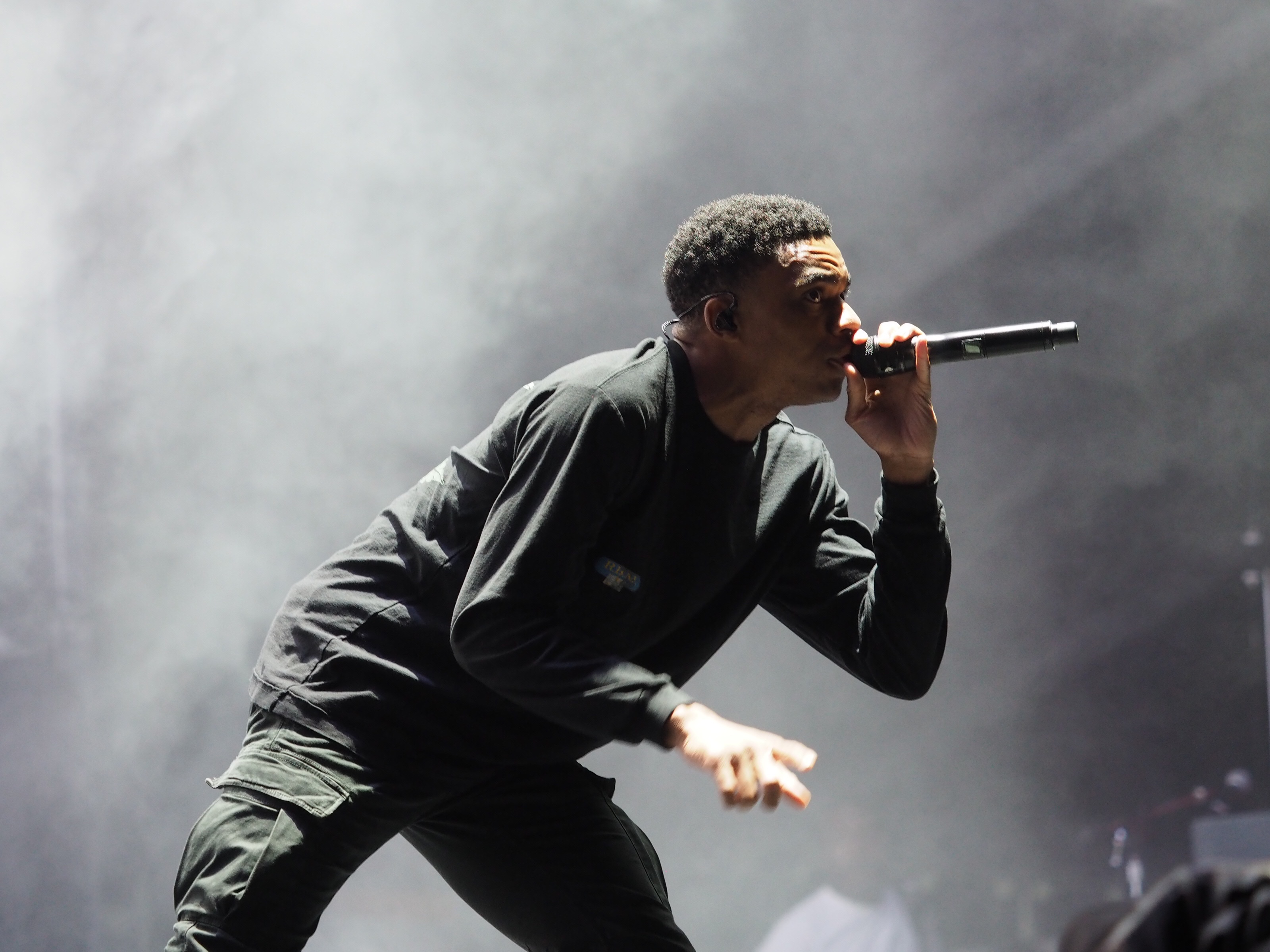
Then again, it could have been some other cognitive dysfunction. He also asked what time it was, and seemed bewildered, more than once, at the size of the audience. Not that he probably had never performed before such a large crowd, but rather that he couldn’t wrap his around the concept of this happening in Japan.
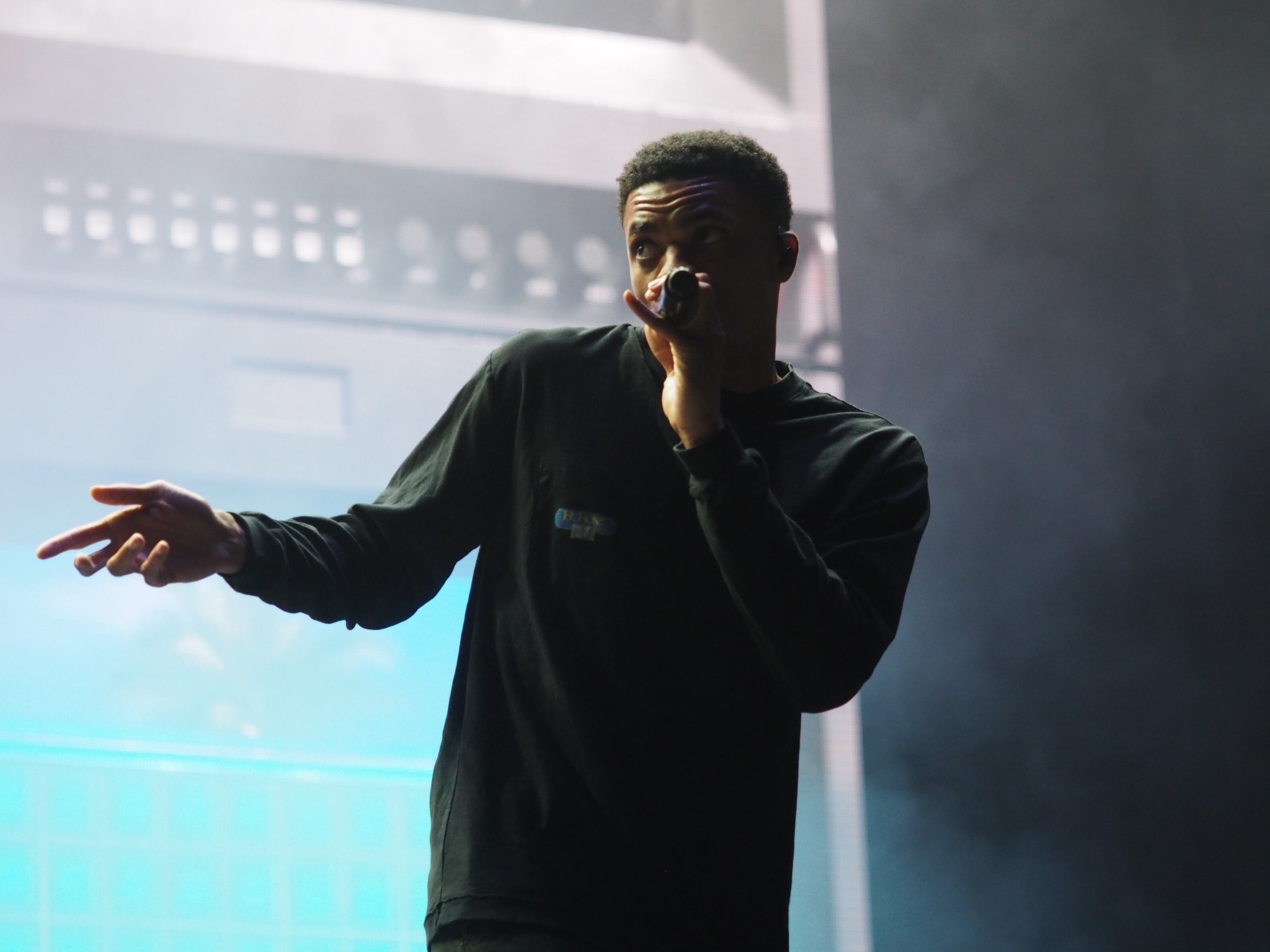
Consequently, the concert, though often intense and certainly fast-paced, had a certain uncertain quality to it. Staples kept asking for the crowd’s approval, which they offered unconditionally, but he never seemed to buy it. “You wanna party?” he said, making good on at least one of his briefs, which is a nostalgia for the kind of hip-hop founded on weekend get-togethers. But Staples is also uneasy with his lot as a party animal, as exemplified by his visual motif.
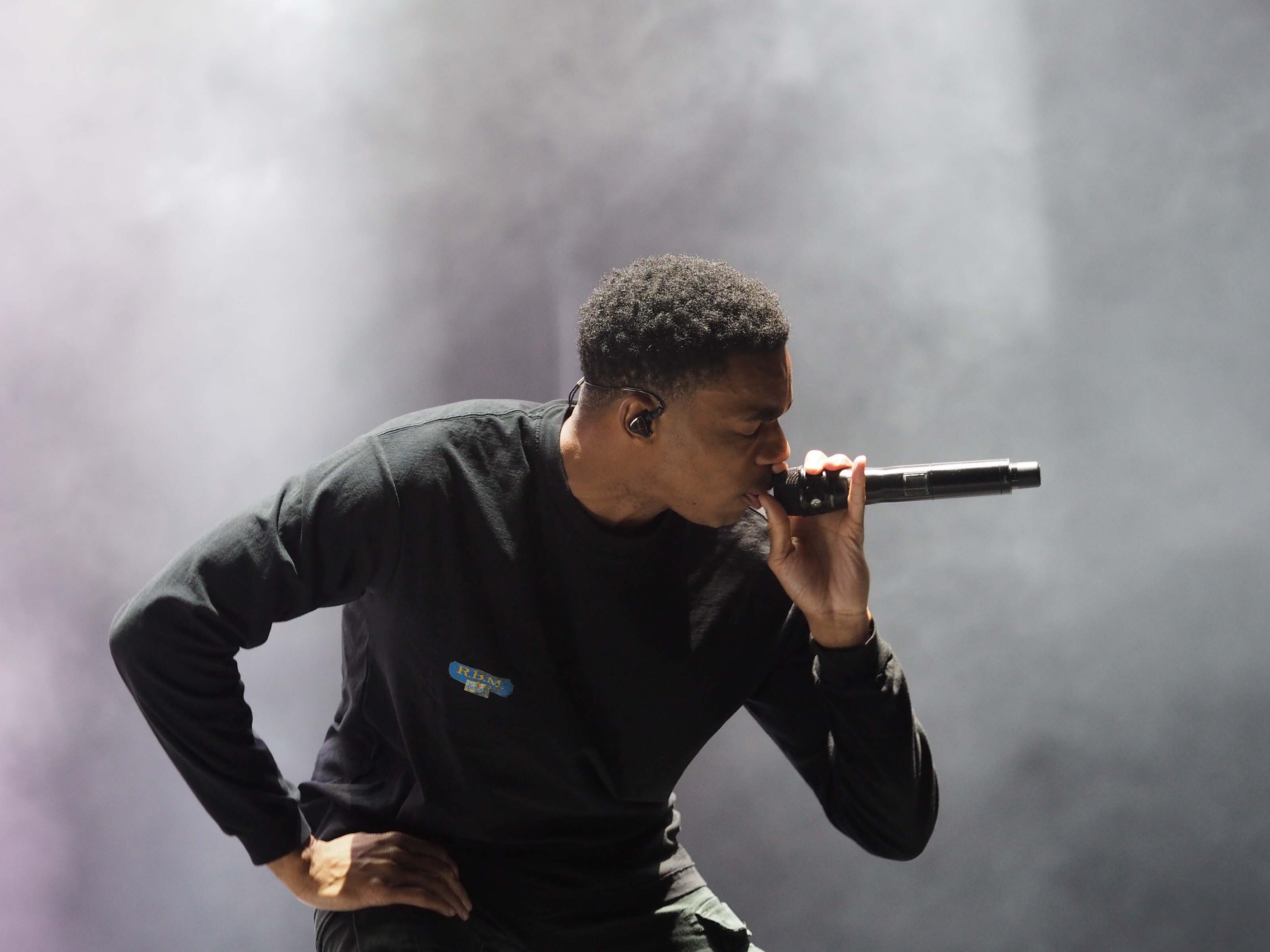
He was the only person on stage — no band or even a DJ — and the background was a grid of TV screens of familiar American TV shows, all of which somehow featured Staples, as it he’d seen himself in them while growing up.
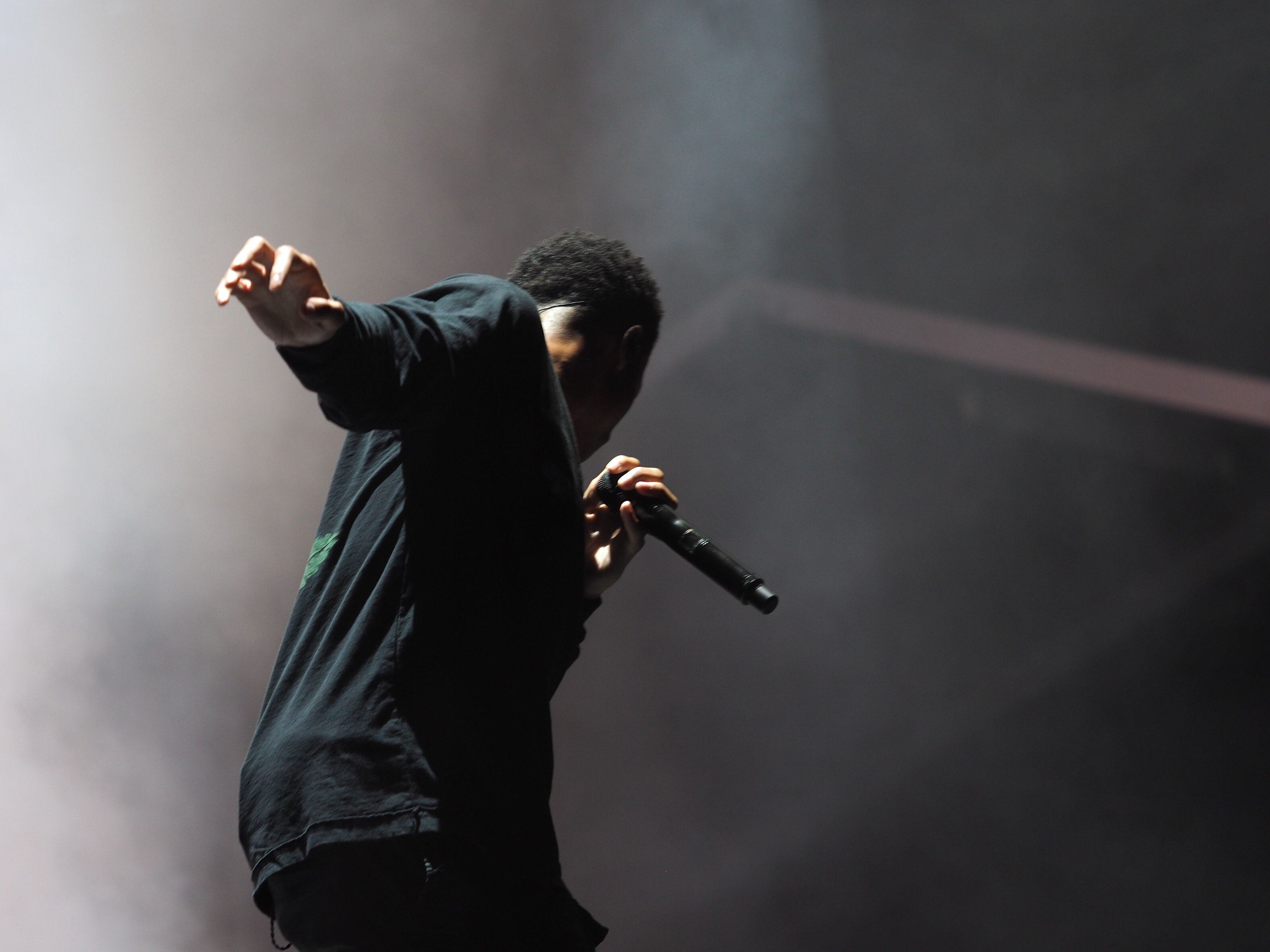
“I love it out here,” he confessed during the confessional “Late Night,” and if was tempting to think he was talking about Fuji’s natural setting, maybe it was just the fact that he was out of his element, preaching to a crowd that wanted to be entertained but had yet to make sense of where he was coming from. Most rappers wouldn’t have bothered, but Staples genuinely seemed to care, and while the crowd dodged and weaved to the potent beats and Staples’ exceptional conversational flow, they couldn’t quite satisfy his desire to connect on a level that maybe he himself didn’t understand. “I hope everybody’s happy today,” he said, apropos of nothing but indicative of everything.

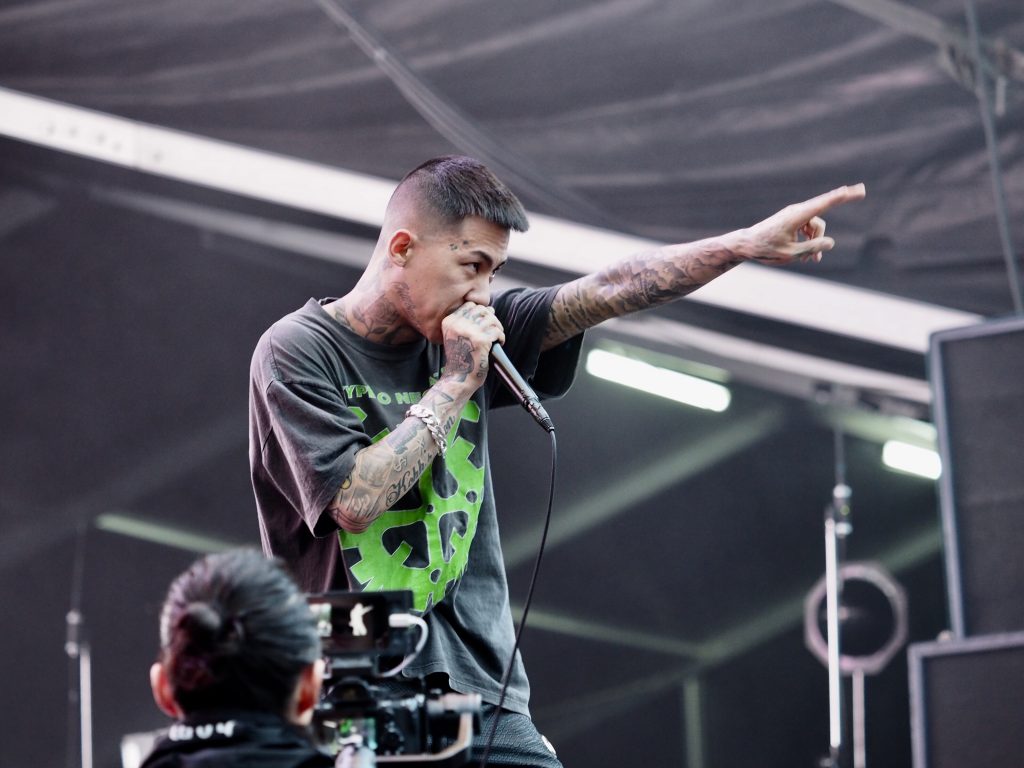
There seems to be a performative style in Japanese popular art that favors over-emoting. Yesterday, the band Kinnan Boyz demonstrated the punk aspect of this idea with an early morning show that was so over the top that the audience seemed clearly put off. I mean, the lead singer was literally foaming at the mouth by the send song.
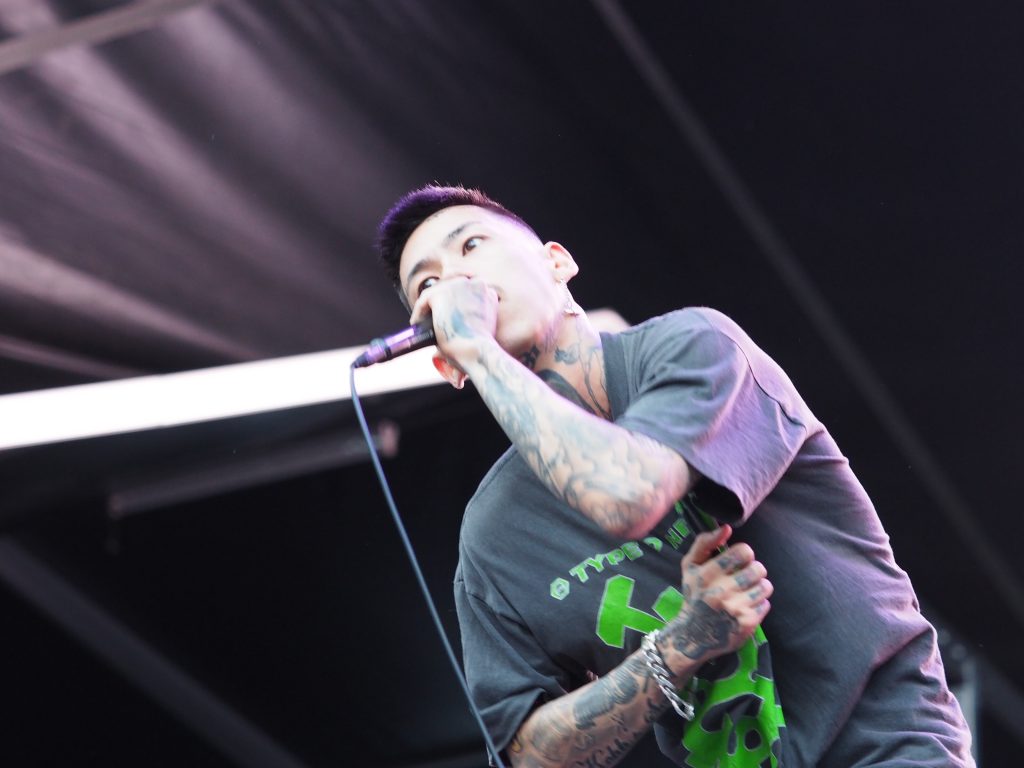
Kohh does pretty much the same thing for Japanese hip hop. As the most formidably honest rapper in Japan, his brief is total emotional engagement. And while his musical style leans toward West Coast minimalism, he has nothing of the West Coast spirit, which is imbued more with anger than resignation, which sounds like Kohh’s default mode. “Leave Me Alone” is his most characterizing song.
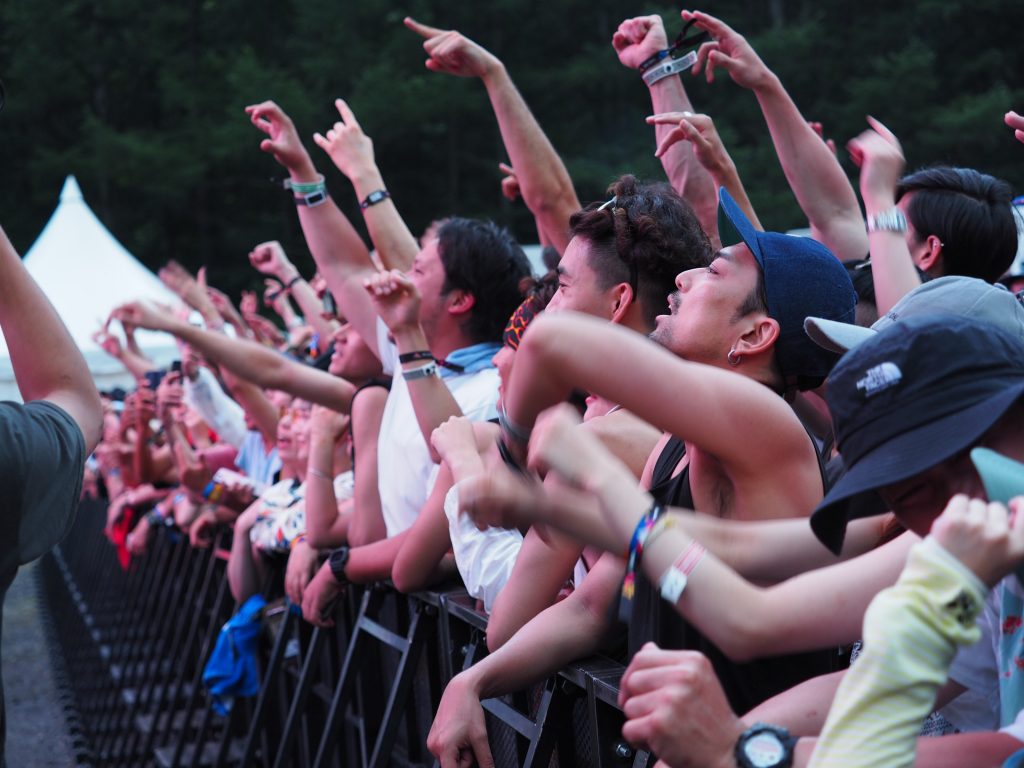
Can Kohh make a difference? On the back of his T-shirt was the logo, Blood Sweat and Gears, a reference to drugs in British slang, and one that he seemed to understand fully, mentioning at one point that it’s something we should talk about. Interestingly, the video feed picked up someone in the crowd holding up a T-shirt supporting Pierre Taki, the electronica artist arrested for drug possession. Would Kohh, if he had been in the same circumstance, have apologized and bowed before authority if he were also caught with drugs?
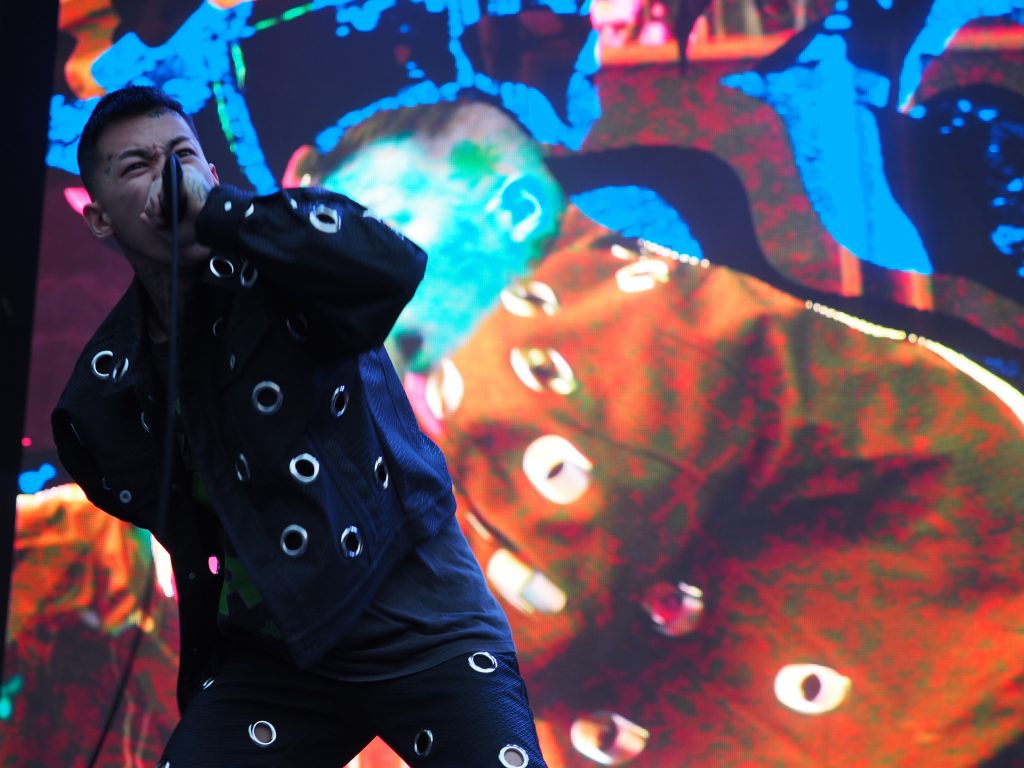
It’s a plausible question if you consider how seriously Kohh’s music takes his engagement with being out of the loop, which in Japan is especially fraught. Musically, Kohh is getting more into R&B and even singing in the T-Pain style. From where I stood, the audience seemed ambivalent, but maybe I just wasn’t close enough. Kohh may still be too far ahead of them.
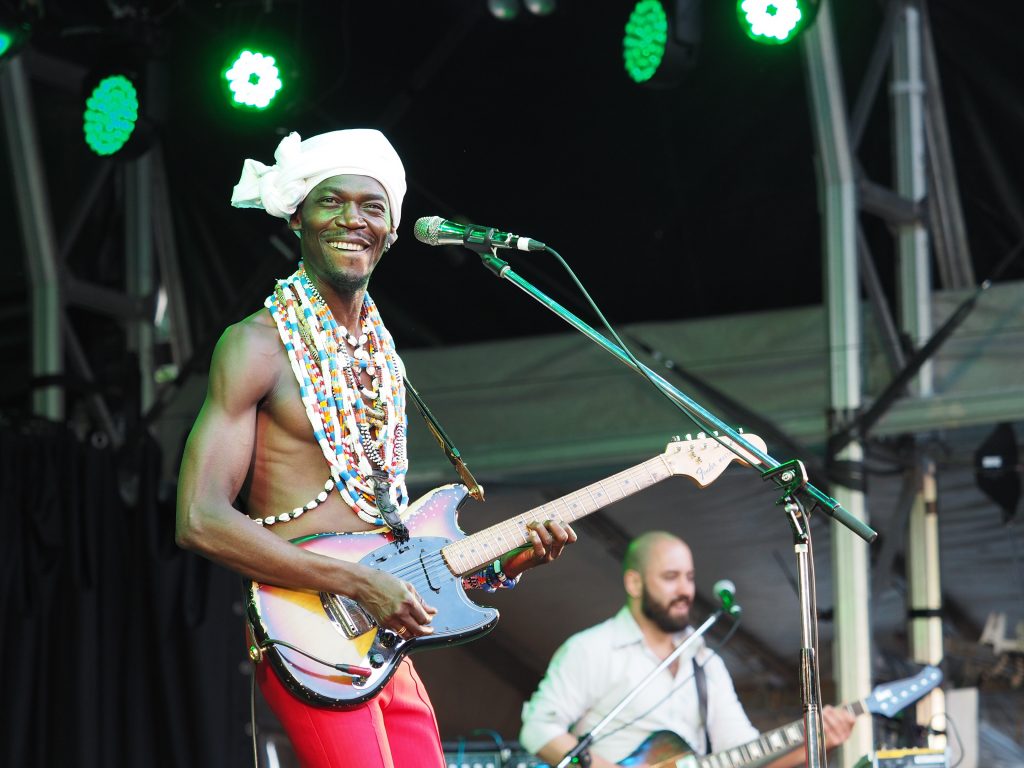
James Brown is generally credited with inventing funk, but, of course, his main inspiration was an African aesthetic that had little hold on his everyday life. It was just there in his heritage as an African-American. Benin music a long time ago incorporated JB’s funk into its ritual style, essentially revivifying funk twice removed. Of the bands who have championed this style, none is more internationally pervasive than Vaudou Game.
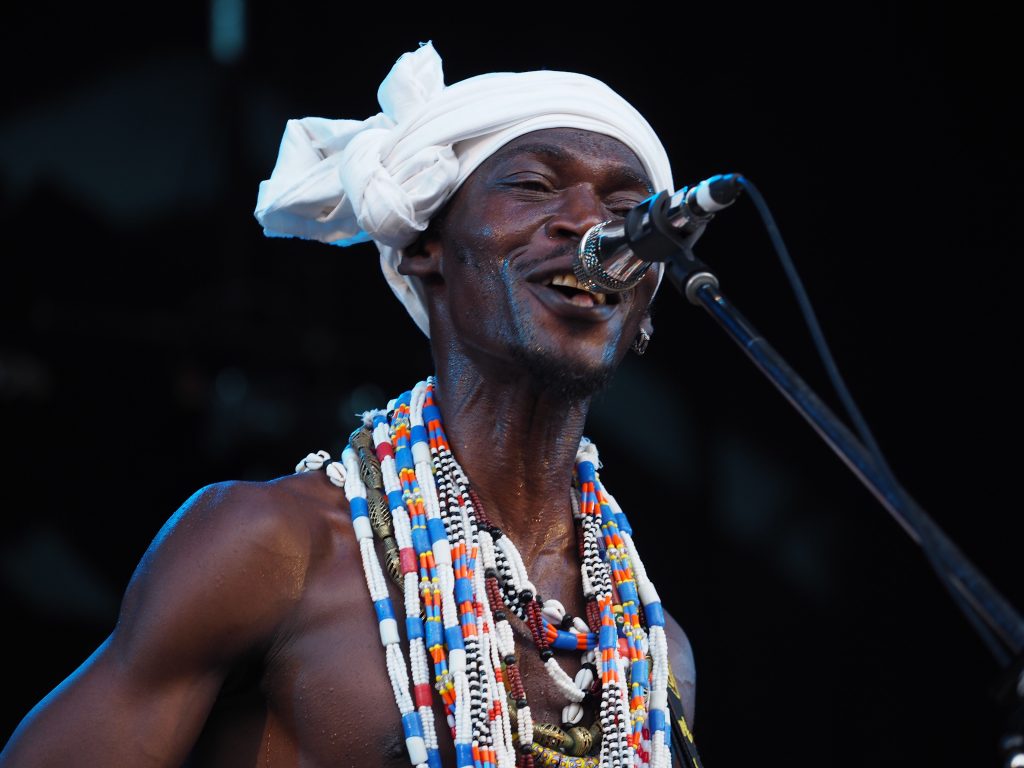
Led by the charismatic and very tall Peter Solo, the band is smaller than its huge sound might indicate, and while it uses Brown’s various funk ideas in its music, the basic feeling is African rhythms and melodies. Holding forth at the Field of Heaven on Sunday, Solo was a true master of ceremonies, bringing the assembled masses into the fold of his music while at the same time proselytizing for his specific world view.

“You can feel the nature here,” he said, gesturing toward the forest that surrounds the venue. “This nature is better than the houses and money you treasure.” Though English is probably his third language, and the audience’s stopgap foreign language of obligation, the sentiment came through, though it took Solo a good twenty minutes to deliver his thesis, time that might have been better spent boogieing.
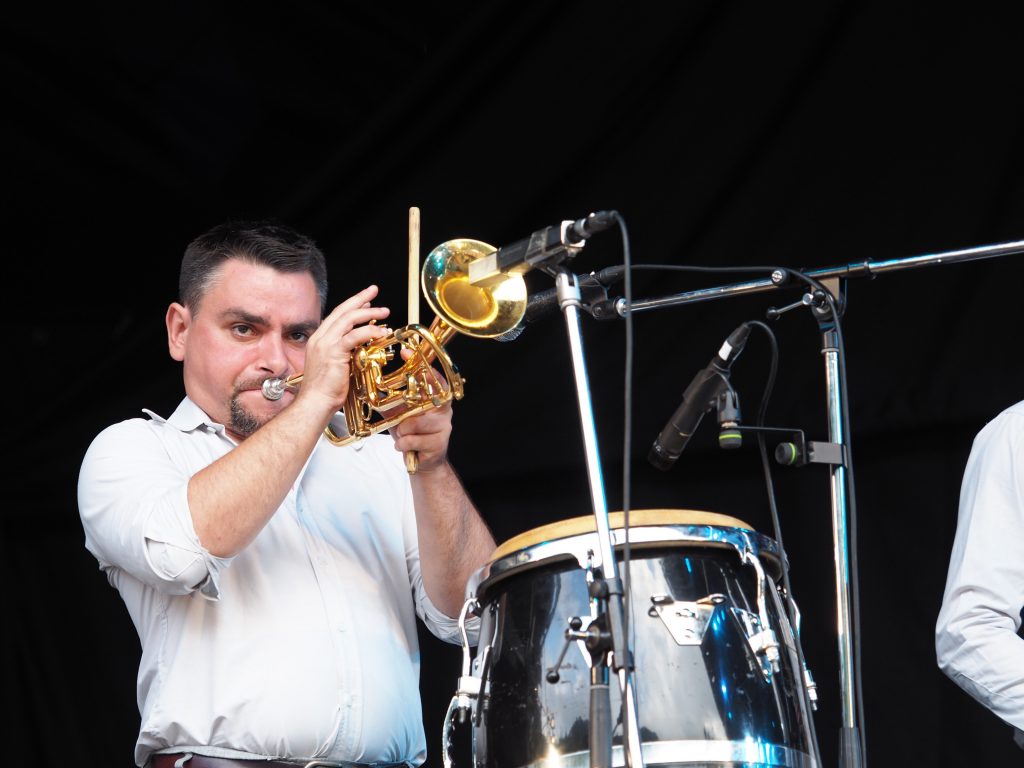
But boogie they did, and the the crowd fell into the grooves — more subtle and less doctrinaire than Brown’s — with an effortless ease. What came through was a clear love of the Fuji ideal on the part of Solo and his multi-racial ensemble and a return of love from people who had already absorbed that ideal. It was a perfect symbiosis of intent and desire.
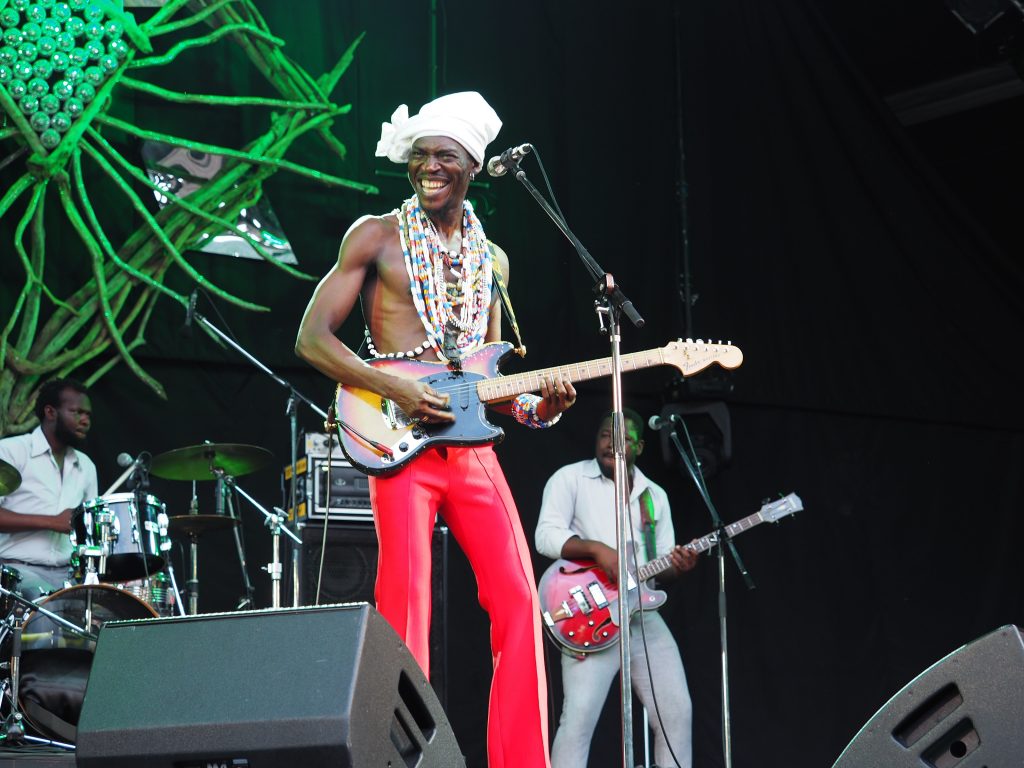
Materially speaking, Solo’s sartorially choices and his natural showman impulses meant the concert moved immediately to the get-down mode. In one song, it seems as if everyone on stage was playing “the one” on cowbell (or the Beninese equivalent. The crowd went wild and the band honored their enthusiasm with not one, but two encores. “Let me ask them if they’re happy,” said Solo, not indicating whether he was discussing the crowd or his band. No matter, we were all ecstatic.
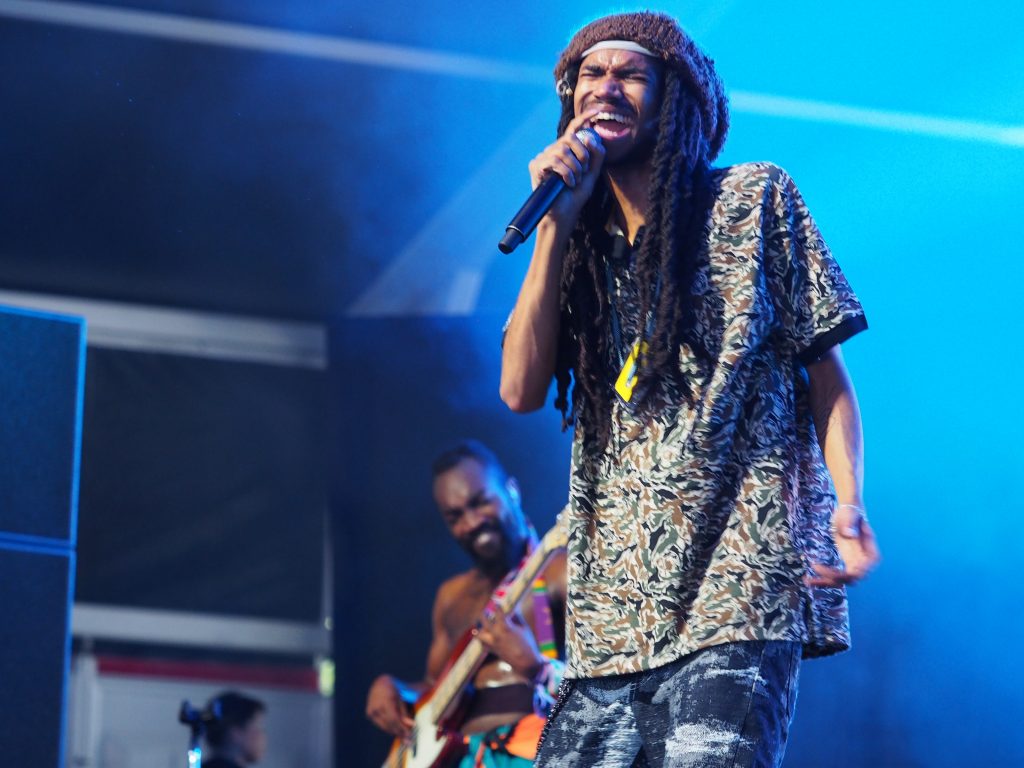
The modern R&B outfit Phony PPL get no favors from their self-deprecating moniker. Formed in 2009, they have over the years garnered praise from a number of critics but haven’t been able to transmute that into commercial success. Basically a Brooklyn bunch of high school pals, the group eschews hard core hip-hop for the kind of uplifting soul music that crossed over in the mid to late 70s: Donny Hathaway, Roberta Flack, that sort of thing.
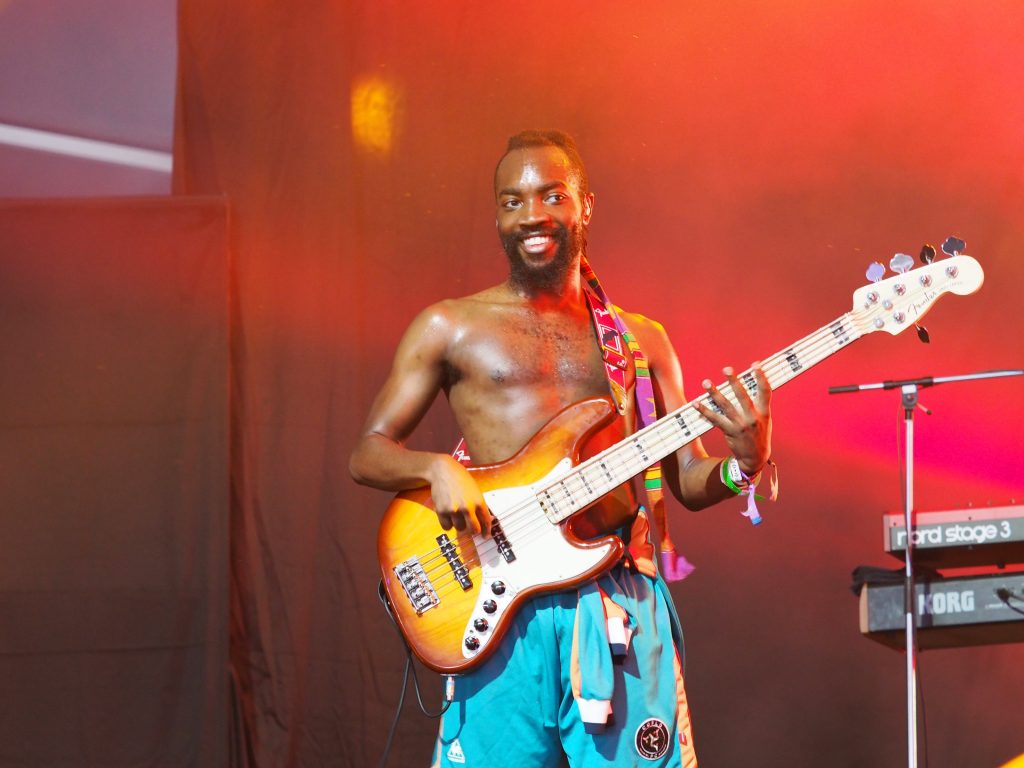
Lead singer Elbie Three clearly is affected by ten years of neglect from the general public and seemed genuinely surprised that the fairly large Japanese contingent that greeted their Japan debut at the Red Marquee on Sunday afternoon was there to party. After their first song received a huge ovation, he said, “You really like that for real?” The resounding response was unequivocal.
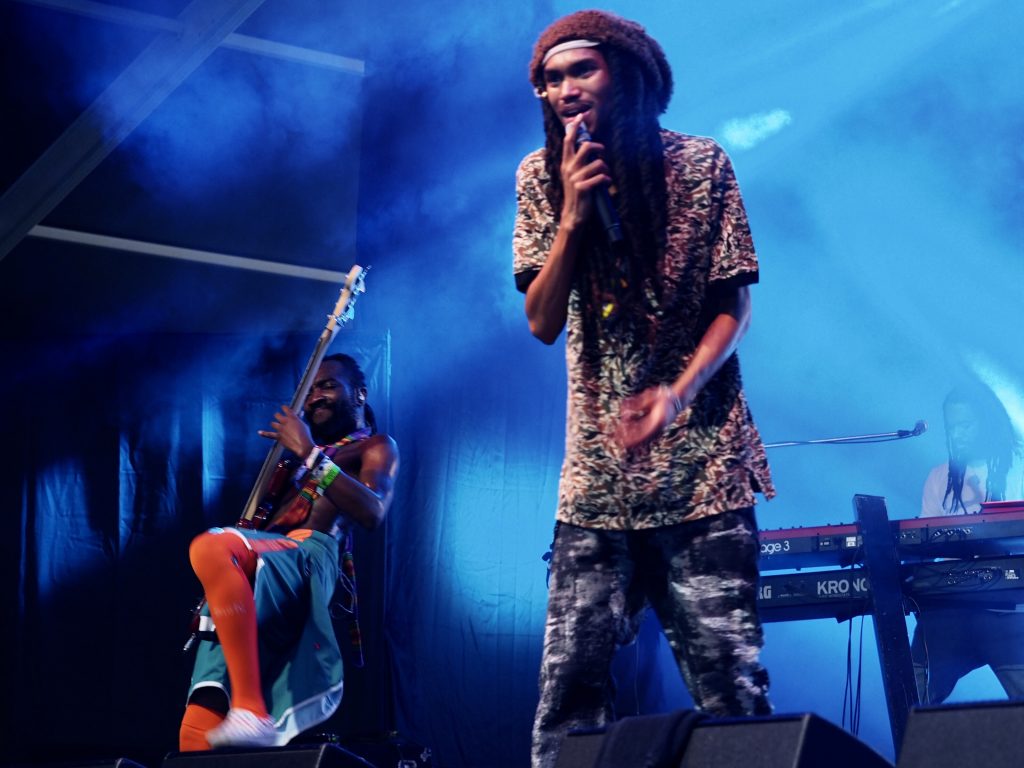
Such enthusiasm only emboldened the front man, who continued with a motormouth MC act that didn’t go over the heads of the assembled if only because they’d probably been here before: most African-American pop acts adhere to a certain pattern of entertainment signifiers.
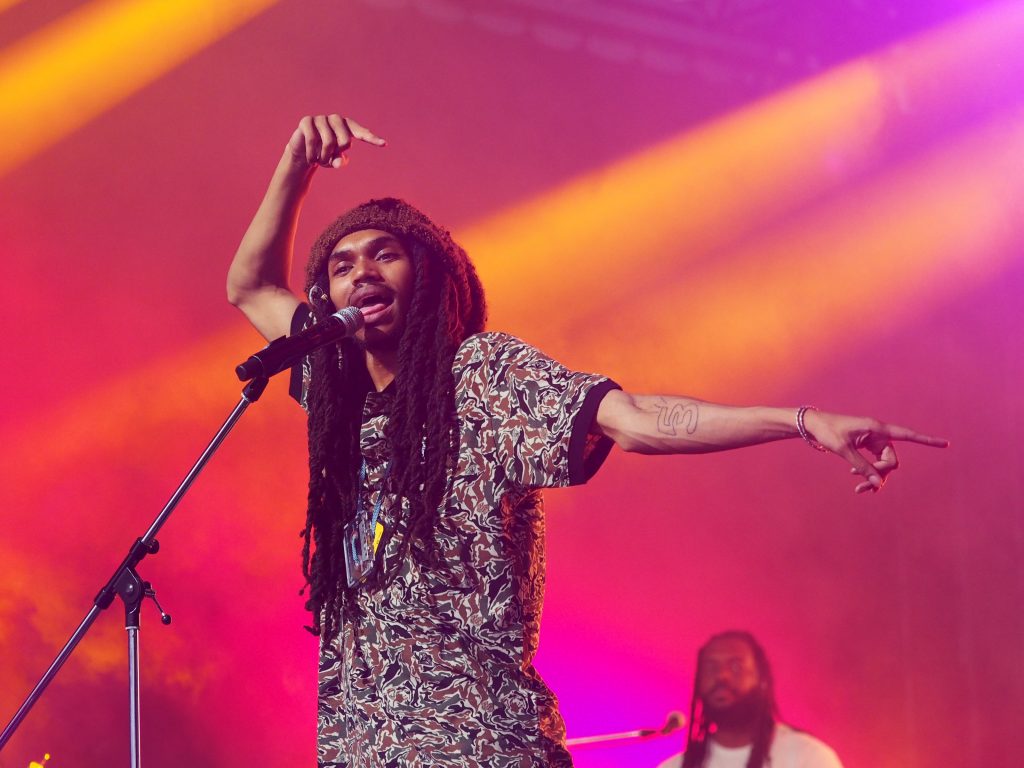
At one point Elbie asked for all the “fellas” to raise their hands, and then for all the “ladies” to do the same. The crowd knew exactly what to do from practice, though they probably didn’t know why they were being asked to do so. The accompanying song was a smash anyway.

The requisite drum and bass breaks elicited huge ovations on their own, which only prodded the band on to new heights of performative abandon and Ellie to new heights of host-level hyperbole. “Y’all ready to move?” he called, and the crowd knew how to react.

To his credit, Elbie played to the “people in the back,” understanding that they were the ones he had to convert if he was going to sell records, which was probably the main subtext of the whole show. “Don’t forget to check out our new album, ‘Mosaic’,” he said at least 50 times.
If people were paying, I would say they definitely got their money’s worth, but they weren’t in the strictest sense. In terms of promotion, I hope that Phony PPL got what they expected, but in the end all they can really hope for is a really great memory. They faced a sincere audience and I think came away better for it, but not necessarily more materially successful.
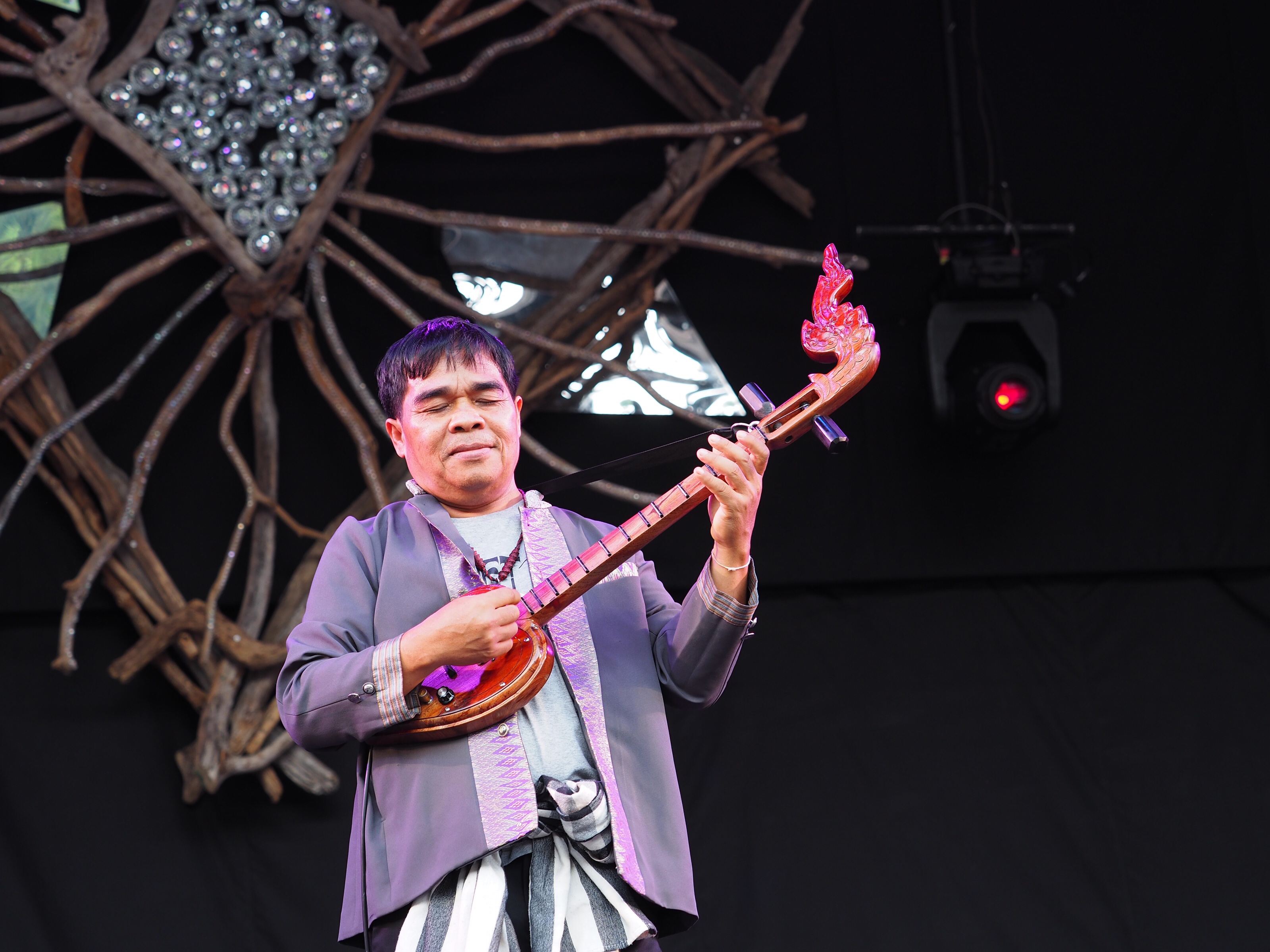
There’s something a bit grand about this group’s name, considering there are only five members, and after watching their performance under a blazing hot sun at the Field of Heaven on Sunday, you get the impression that they have a lot of fun with expectations. After all, they are essentially three traditional Thai instrumentalists backed by a rhythm section that is seriously into funk.
The allocation of parts seems fairly simple. The electrified Thai lute, the pin, is the lead instrument and does pretty much what a guitar normally does, while the pipes fill in for synths, keyboards, and strings. The guy on the finger cymbals isn’t going to take the drummer’s job away, but he wasn’t chopped liver, either.
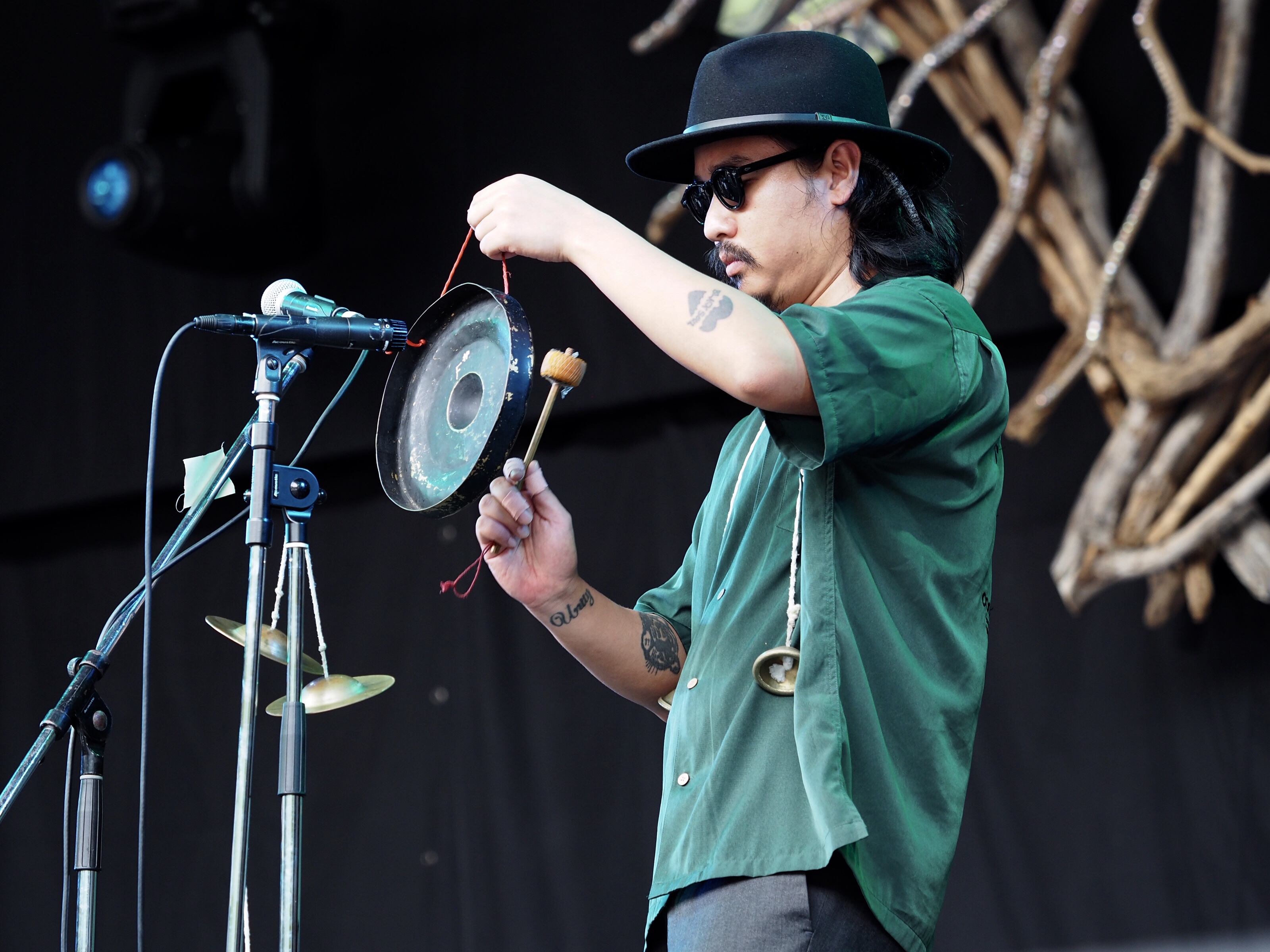
But it was the rhythm section, especially the bass player, Piyanart Jotikasthira, who not only formed the melodic bedrock but also provided English language explanations of the songs. He would say the title of the song in Thai and then translate it into English (“This is called ‘Tricky Little Deer’,” though I wonder if it was actually titled “Tricky Little Dear”?) One of the most dramatic songs they played was called “Chasing the Cow,” which he said was a song about farmers. Never realized farm life was that exciting.
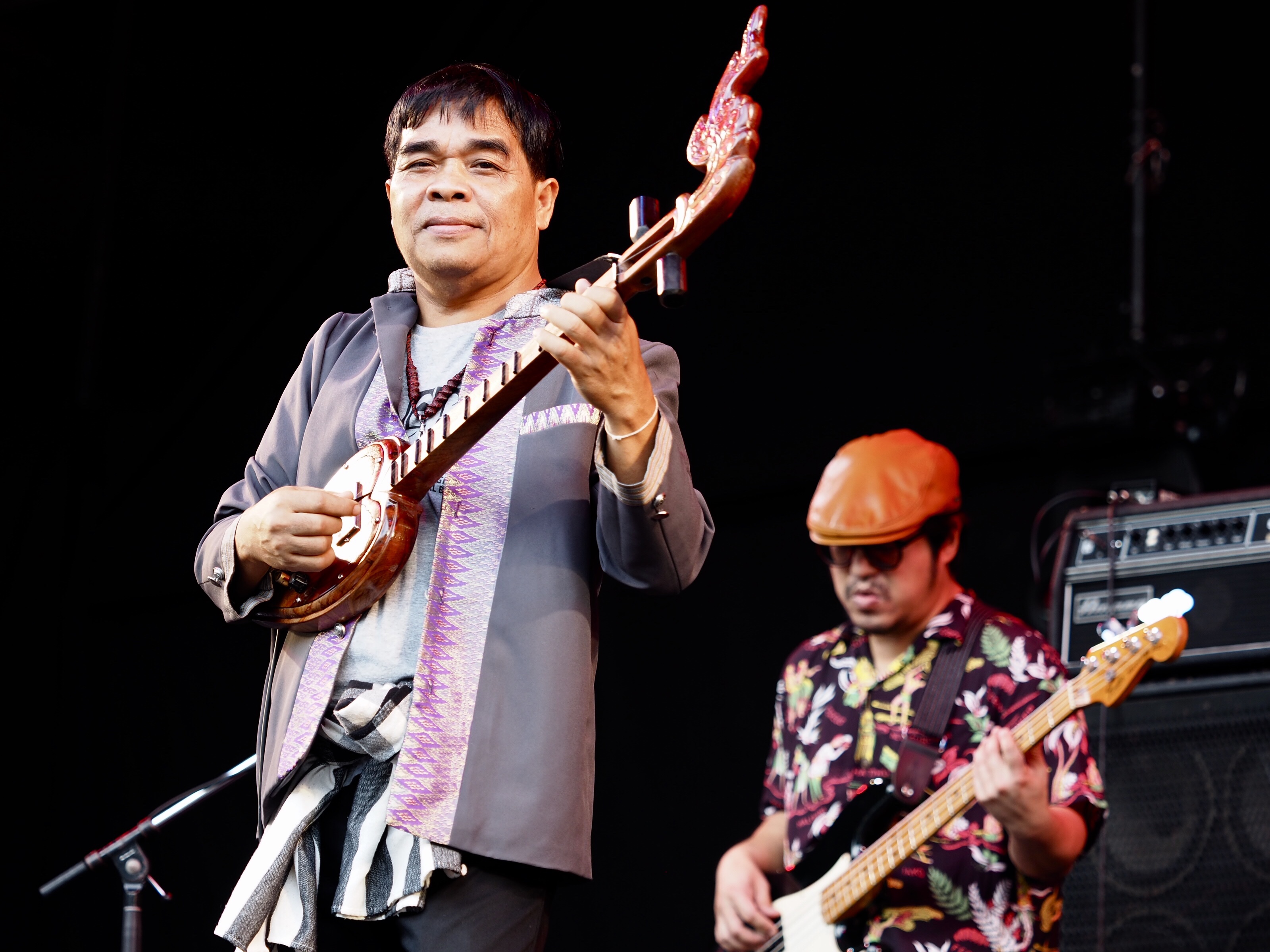
But it was the funk that got the crowd moving. When they started, there was only a handful of people in front of the stage, but by mid-point the whole field was rocking and grooving.
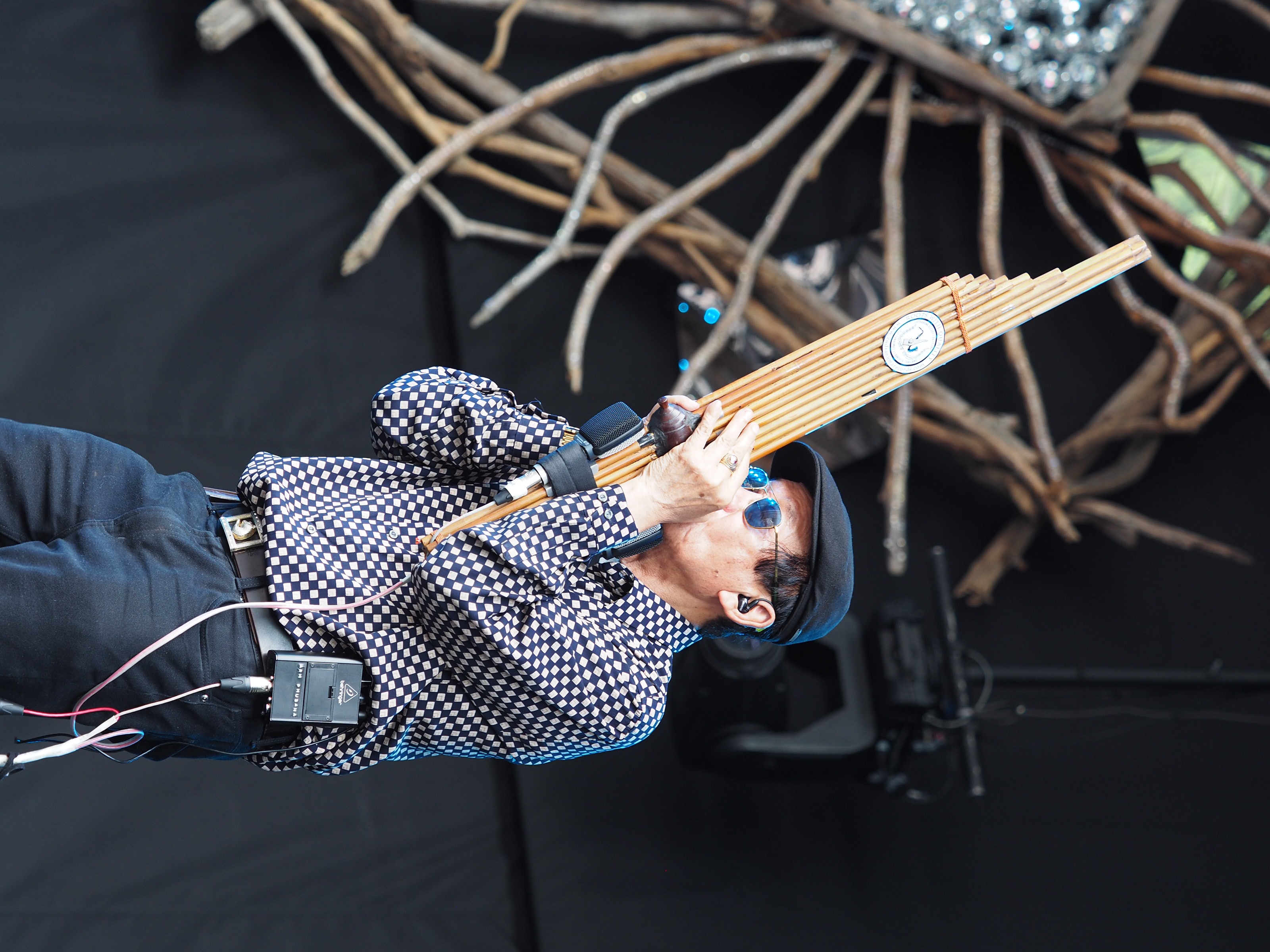
The lute player, Pinpech Thipprasert, has got to be both the Jerry Garcia and Ray Parker Jr. of his particular instrument, because there were passages when he was wailing, and that immovable back beat just kept pounding and pounding. The pipes would often add counterpoint on the off beats, like the organ fills in the old JBs. You come for the exotic, slightly misleading name, and you stay to get down.
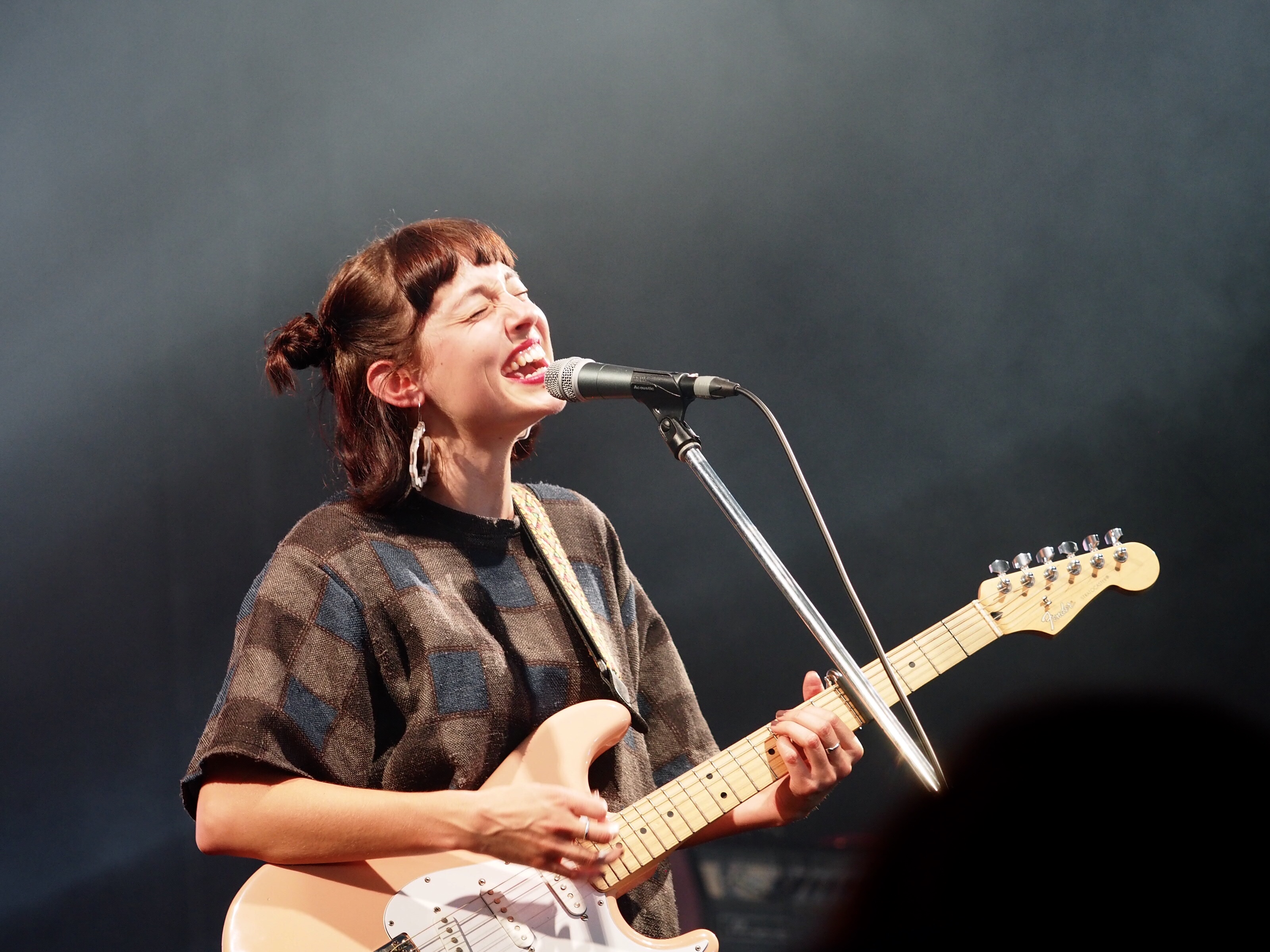
It was a cinch that Australian singer-songwriter Stella Donnelly was going to win the hearts of the Fuji Faithful as soon as she walked on the stage. Diminutive but wearing a big smile and even bigger earrings, she exuded the kind of sincere confidence of an ingenue who knows not only what she’s worth but how to make it worth it to others.
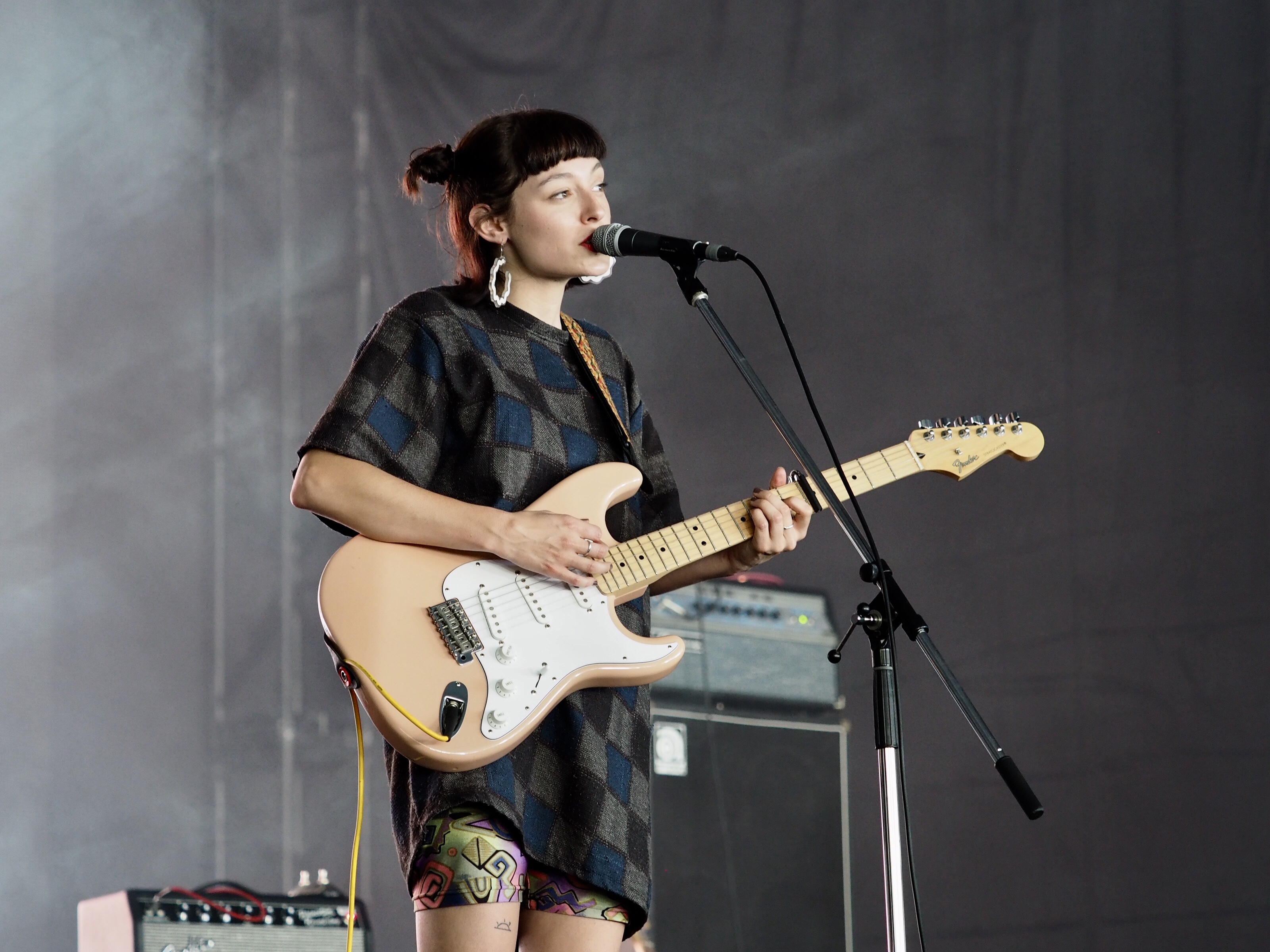
She wisely did her first four songs solo, just her and her electric guitar, which she played with a knowing simplicity that indicated real chops even if she wasn’t going to show them off. But it was mainly the voice that made everyone fall in love with her: big but not brassy, pure but not mannered, high but not girlish like other indie singers of her ilk. It was a full instrument that cut through the Red Marquee like a knife.

It also put paid to her subject matter, which is mostly about what jerks most people are, and by most people, I mean men. Though English songs tend to go over the heads of the Japanese audience if they haven’t studied them beforehand, Donnelly’s “You Owe Me,” about an asshole boss who “jerks off to CCTV” seemed to make a deep impression. Hasn’t everyone had such a boss? In any case, the song sparked an ovation that was obviously not just a reaction to the limpid melody and Donnelly’s delivery.
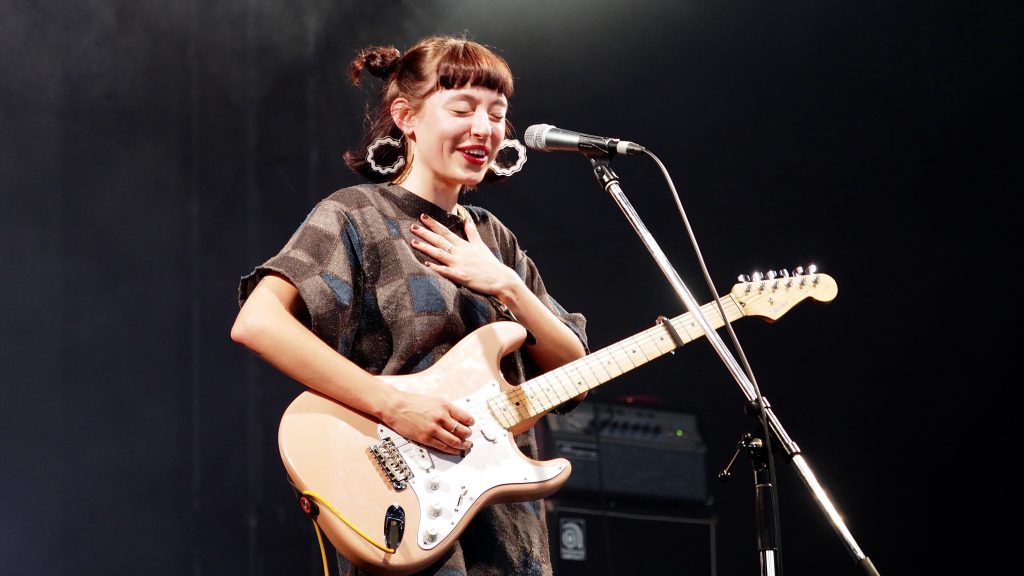
After getting the crowd to say hello to Donnelly’s dad back in Australia, watching presumably on YouTube, she brought out her band, which she described as “old friends,” meaning they’ve known each other as human beings longer than they have as musicians, and the camaraderie showed. At one point, she and her utility man, Jack, did some “dance moves” (though at first I thought she said “dad moves,” which, considering the pokey quality of the movements, wasn’t far off) to the song “Die,” which isn’t an imperative, but used in the sense of “I don’t want to…” In any case, it was a very upbeat and fun song, hence the lockstep choreography, which had more to do with school calisthenics than with Janet Jackson. Unfortunately, the shed was packed, so there was no room for the audience to hop along, though many tried their best, cracking Donnelly up at one point. Not many new artists get to appreciate the whole spectrum of Japanese audience participation during their very first show in the country. She obviously felt blessed.

The crowd at the opening act on the Green Stage Sunday was smaller than usual, most likely owing to the probability that campers were still mopping up their tents and hotel stayers were hair-drying their sodden shoes. They really missed something. The Inner Mongolian big band, Hanggai, put on quite a show under mostly cloudy skies.
Dressed in a smattering of traditional clothing but mostly looking like your average California slacker rock outfit, the huge group brought along its 7-member horn section, which didn’t always have a lot to do instrumentally, but their collective background voices gave the group its main selling point: irresistible choruses that made the hairs on the back of your neck stand up. Front Man Iichi, sporting the coolest sunglasses at the festival, reportedly started out his music career in a punk band, and there was something of the snotty showman in his stage demeanor, goosing the crowd’s early morning desire to get this party started while demonstrating same by going through can after can of samples from Japan’s finest corporate breweries. “Kampai” seemed to be the only Japanese he knew, but he knew it well.
Though at least two members did some throat singing, and Iichi has said in interviews that his mission is to bring the traditional music of Mongolia to the city (the band is based in Beijing), for the most part the songs were a hodgepodge of traditional tropes and pop skills. One song, built around some sinuous trumpet lines, was a full-blooded blues, and one galloping horse song started out in bluegrass mode, complete with Chinese banjo and the Mongolian version of the erhu taking the fiddle parts. Pretty soon the song had taken on a life of its own and just kept getting faster and faster. “Ghost Riders in the Sky” on the Gobi Desert.
The party purport was further promoted by the introductions. A non-Asian woman, the only member of the horn section in traditional dress, introduced the section in English using the kind of lingo you’d hear in a Vegas lounge act, except she concluded her stint by offering, “I hope you dance your ass off.” I’m sure she wasn’t disappointed.
How come nobody told us about this tropical storm? Though the Fuji Faithful know to expect some rain over the weekend, The relentless deluge that started dropping water bombs on the festival in the late afternoon was exceptional in both its intensity and duration.
There are few places to seek shelter from the elements at the festival, and, naturally, they were all stuffed with soggy punters: the Red Marquee and the Blue DJ tent at the west end; the Orange Court eating areas at the east end. Stuck out on the east end when it really started coming down, we decided to forego George Porter Jr. and American Football and hid out at the Cafe de Paris, where a DJ was spinning deep classic rock and folk-country album cuts. When he put on “I Shall Be Released” we wondered if we’d ever get out of the makeshift cafe, whose floor boards were erupting with geysers even inside the tent. At least they had alcohol.
Rather than risk another drenching we skipped over the puddles to a little makeshift eatery near the back entrance to our hotel, a place called Don’s Cafe (Don is apparently a dog; you can buy T-shirts and coasters with his panting mug), which was packed. The only food they had left at that hour was soup and pickles, but they really hit the spot. Don’s also had entertainment: a very bad Japanese comedian riffing in English; a very good Japanese country band featuring shakuhachi and a repertoire that included a Japanese-language version of Talking Heads’ “Heaven”; and a sui generis female singer sporting a white wig and accompanied by a single guitarist (very good) and some old guy shouting encouragement and adding percussion. There was even a little boy who seemed familiar with the act. She sang as if this was her big chance at stardom, here on the margins of Fuji Rock at Don’t Cafe with the rain pouring down outside. Sounds like something from a movie.
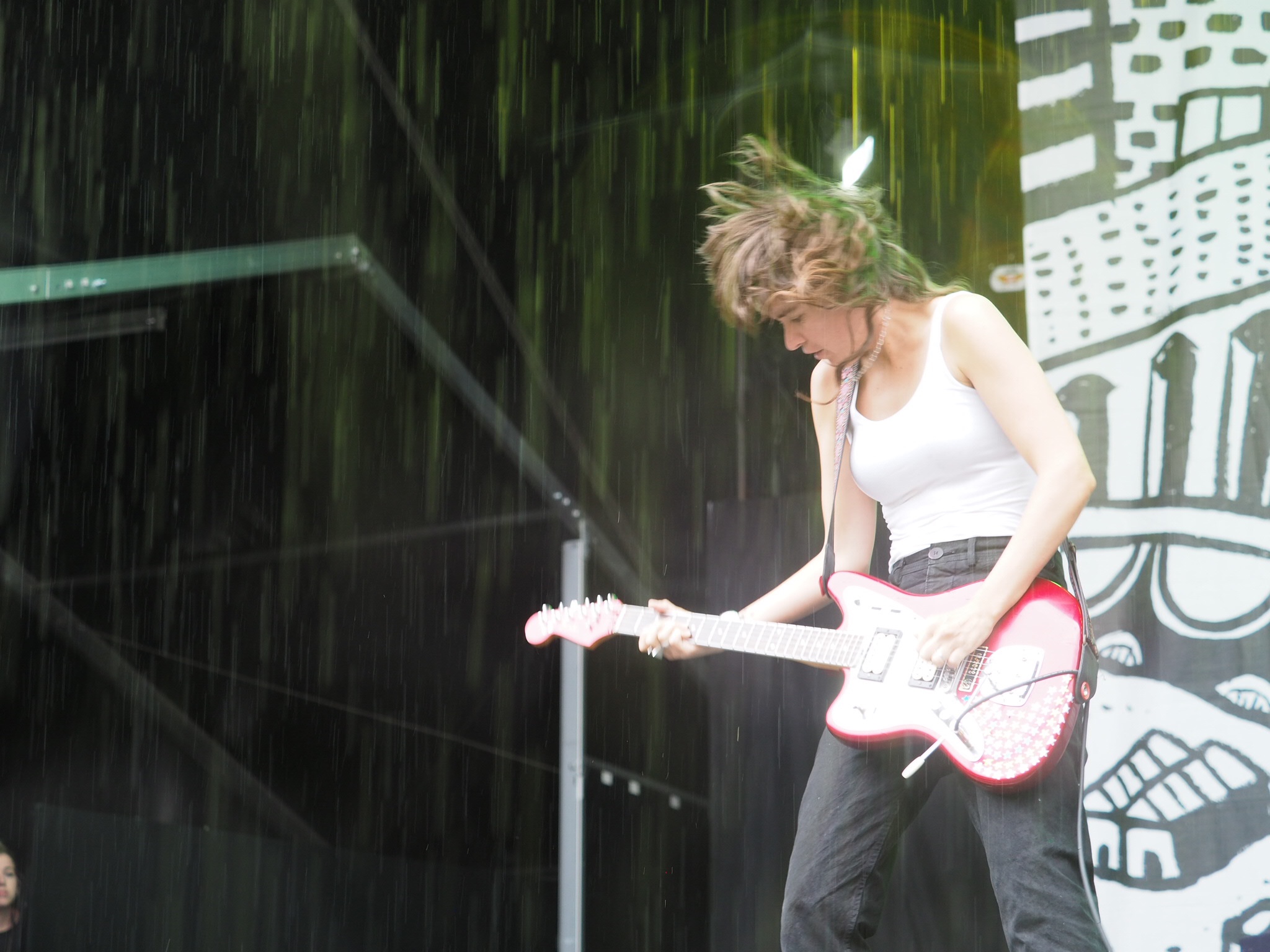
Courtney Barnett at the White Stage | Mark Thompson photos
A good part of Courtney Barnett’s success, especially in Japan where she’s managed to generate a dedicated cult, is her seemingly unforced honesty, a quality that is manifest in the Australian rocker’s songs, which sound like a person you really want to know talking in plain language. The fact that she can marry this artistic sensibility to kickass guitar rock without making it sound ironic or contrary only makes her that much more unusual, even in the rarefied world of indie rock.
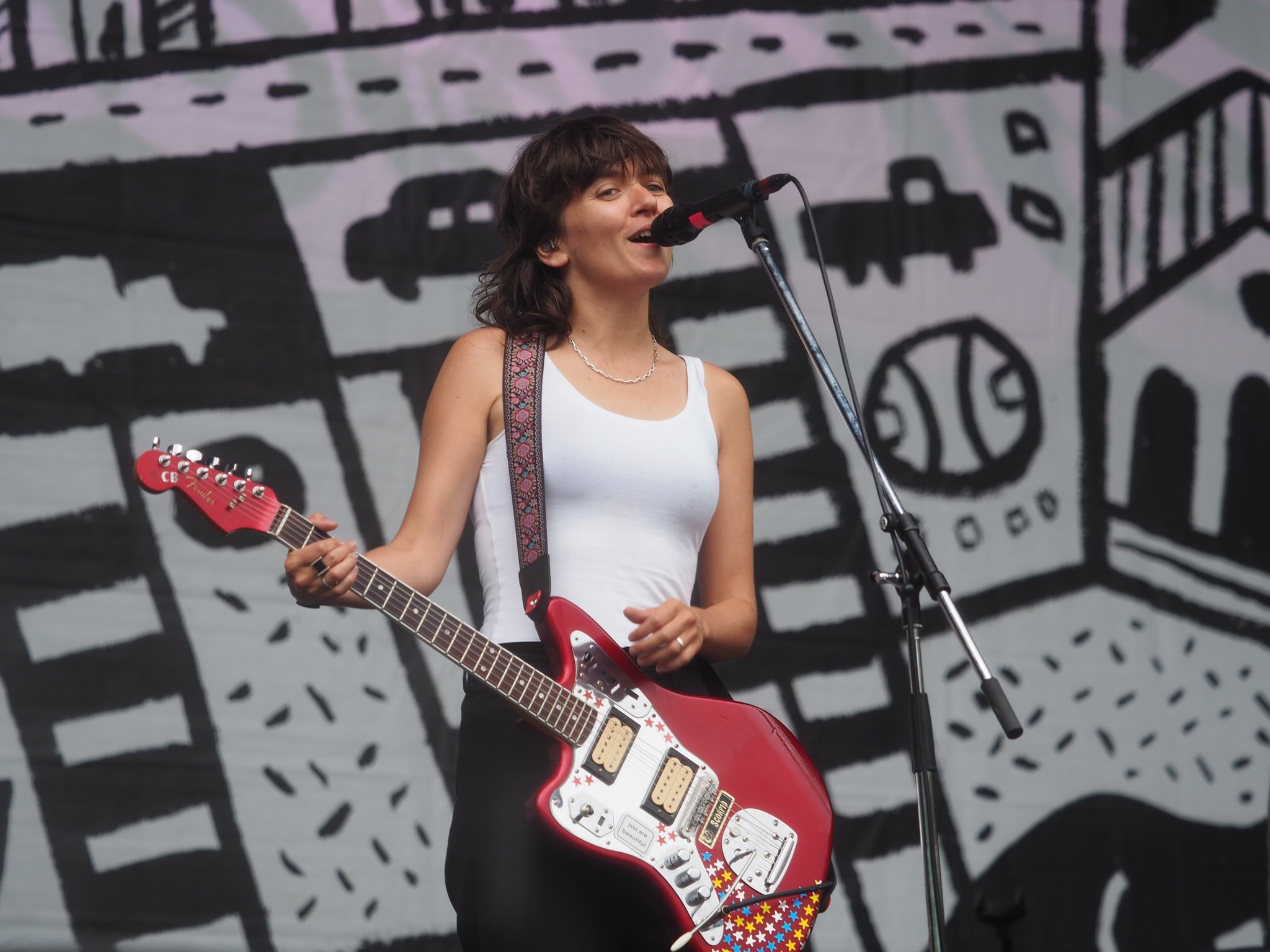
She had a lot to contend with during her afternoon set at the White Stage, for the most part an audience whose exuberance was literally dampened by one of those downpours that soaks you to the bone in less than a minute. There was actually a river running through the north side of the White Stage field. She voiced her appreciation for us standing there just to hear her play, and then she ripped the place up.

Another saving grace was that she looked great. Gone are the baggy T-shirts and homemade haircut. She looked rock star ready in her pure white tank top and tight black jeans, and when she tore through one her patented pick-and-strum (no pick!) solos the crowd got back a little of its mojo.
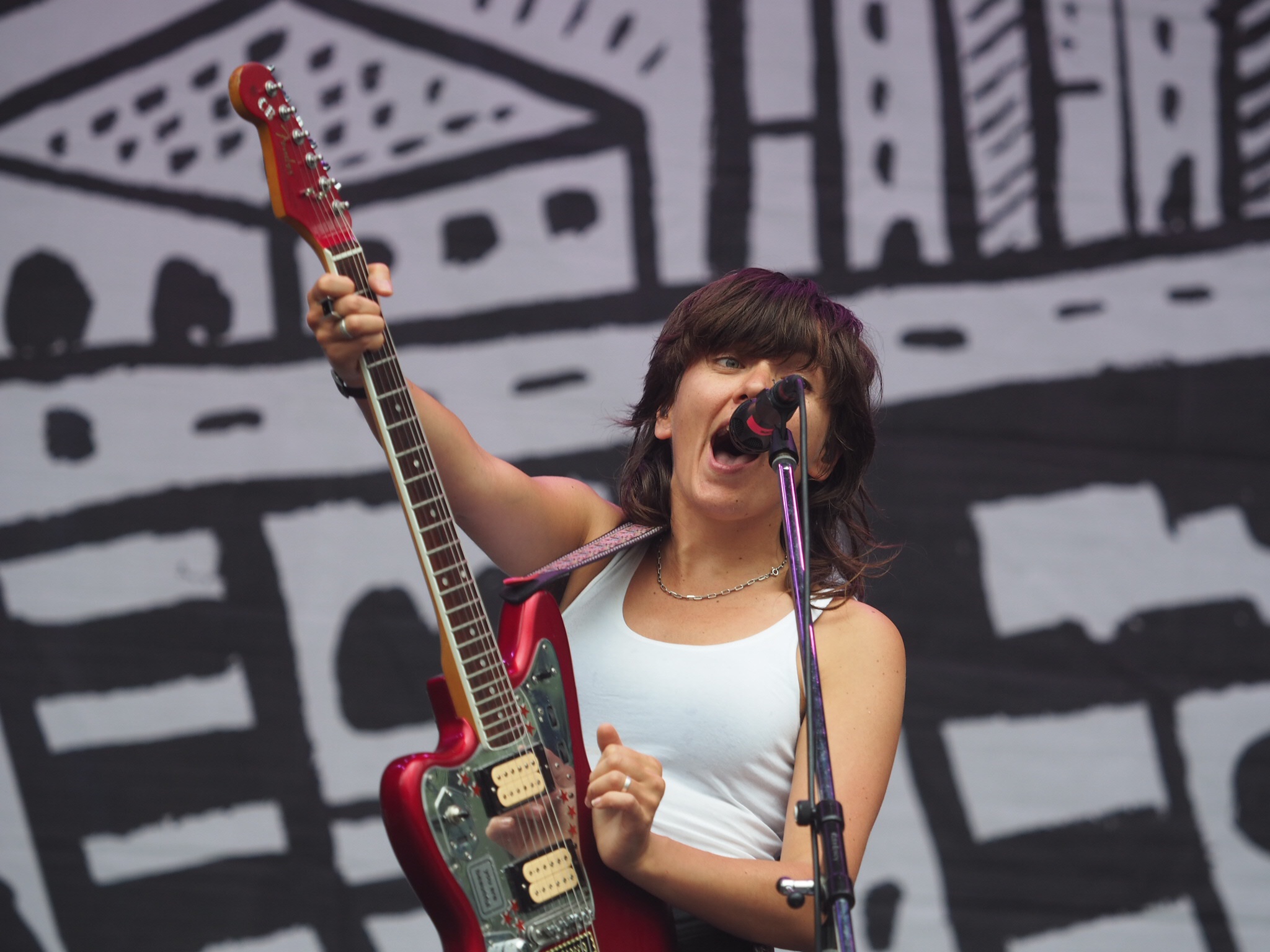
“You know this is the best festival in the world,” she said near the end of her set. “Thanks so much for making it possible for me to come.” Gratuitous pleasantries in most artists’ mouths, but Barnett makes her living telling it like it is.
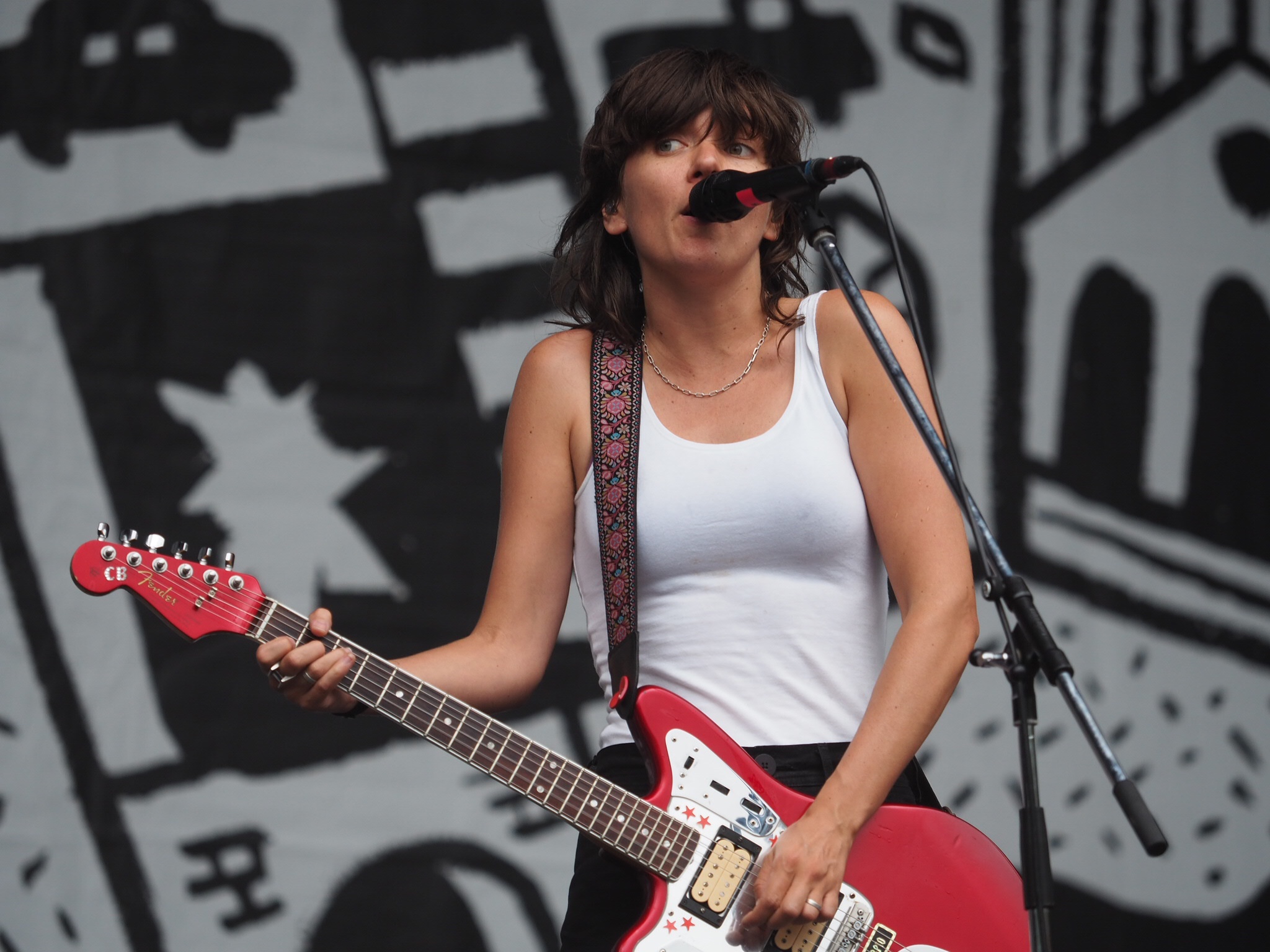
She even played a new song called “Everybody Hates You,” proving that honesty cuts both ways. When she started her last song, the rain stopped, as if the weather decided it would give her, and her fans, a break.
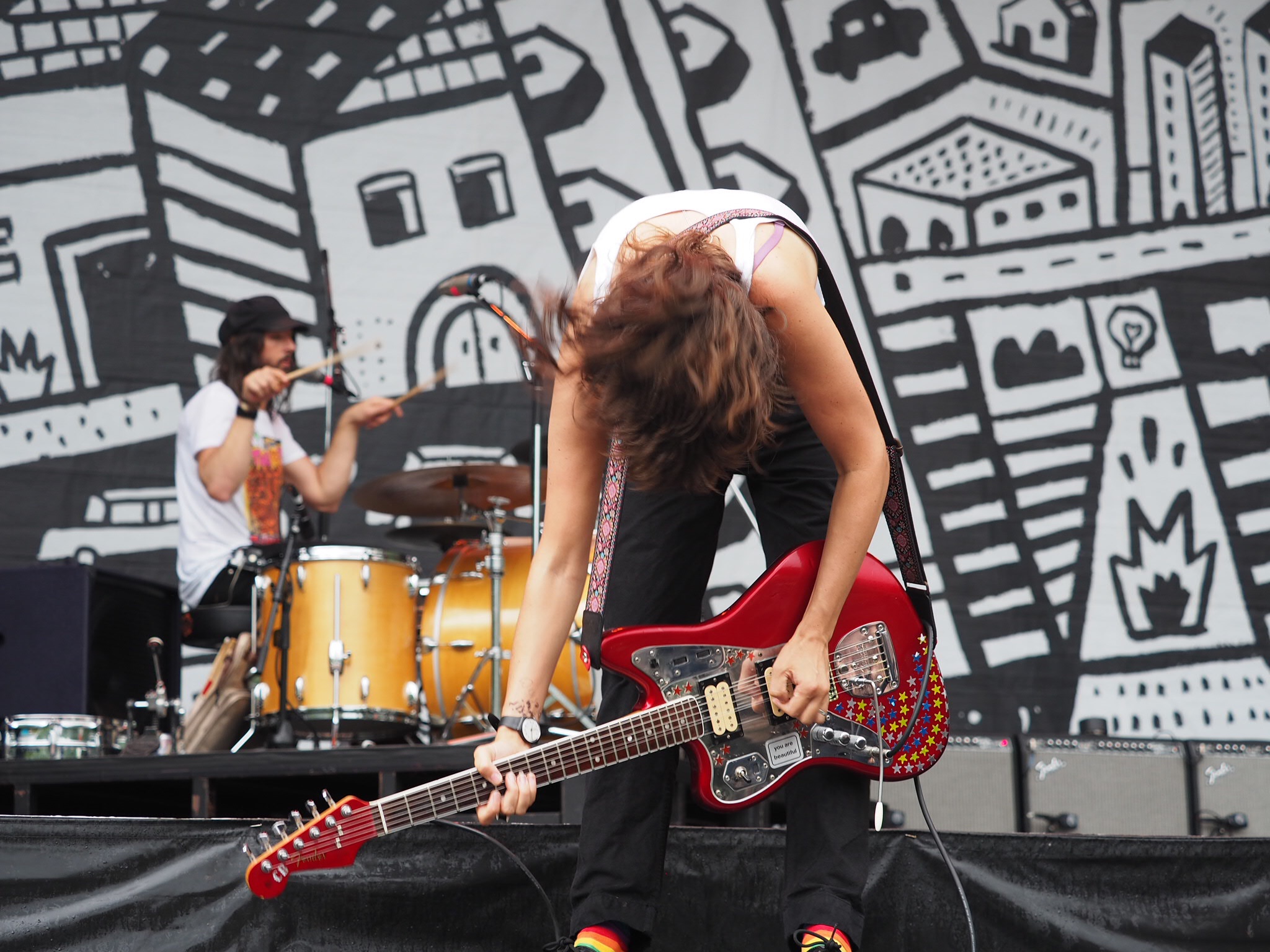
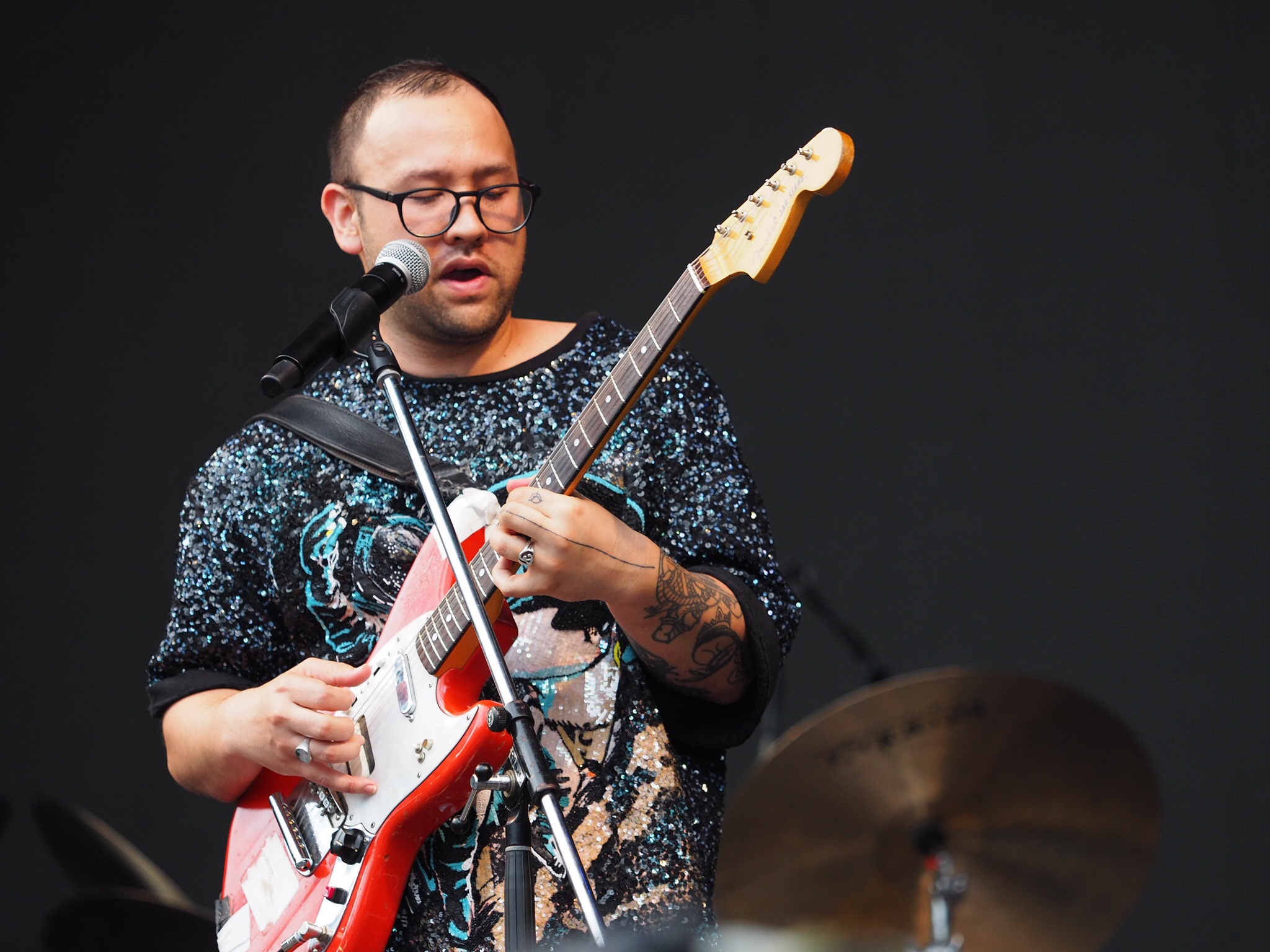
Unknown Mortal Orchestra | Mark Thompson photos
Ruban Nielson, the leader of New Zealand’s-by-way-of-Portland band Unknown Mortal Orchestra, doesn’t seem to know what he wants to be: a guitar god, a slick R&B vocalist, or a fusion bandleader. He demonstrated all three skills within the first four minutes of taking the White Stage on Saturday afternoon before a very appreciative audience, though they didn’t quite know what to think when he almost immediately jumped off the stage with his guitar and continued playing a solo while five security guys and a roadie followed him as he went deep into the audience. Guitar god? Check.
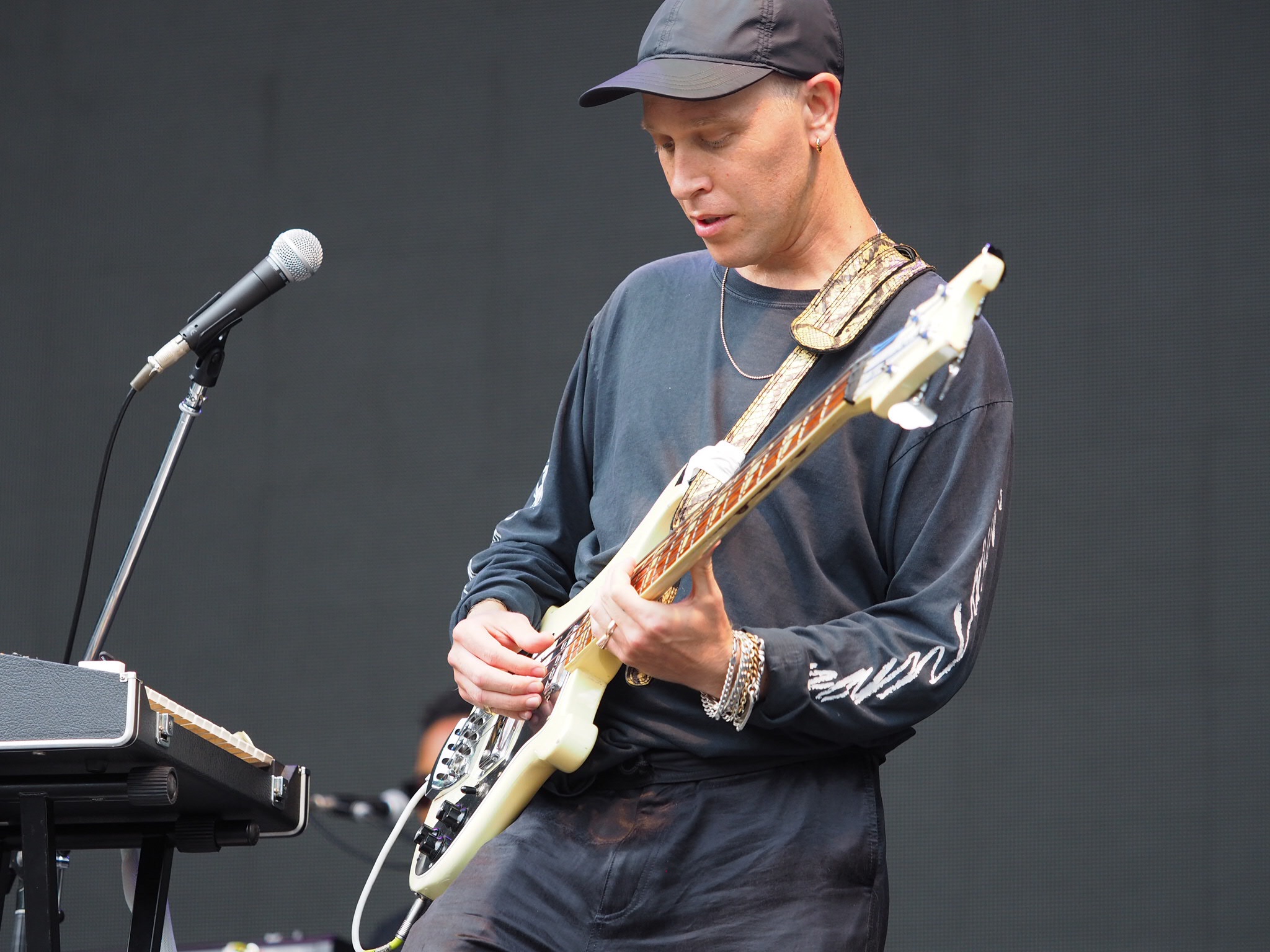
Several songs later he did the same thing but without a guitar. All he had was the mic, as he kept singing a sweet love song. Sex-you-up R&B lover man? Check.

Then, a song or two later he conducted the whole band as they chugged into an improvisational freakout that ended with a manic sax solo by his father, Chris. Fusion pretensions? Check.
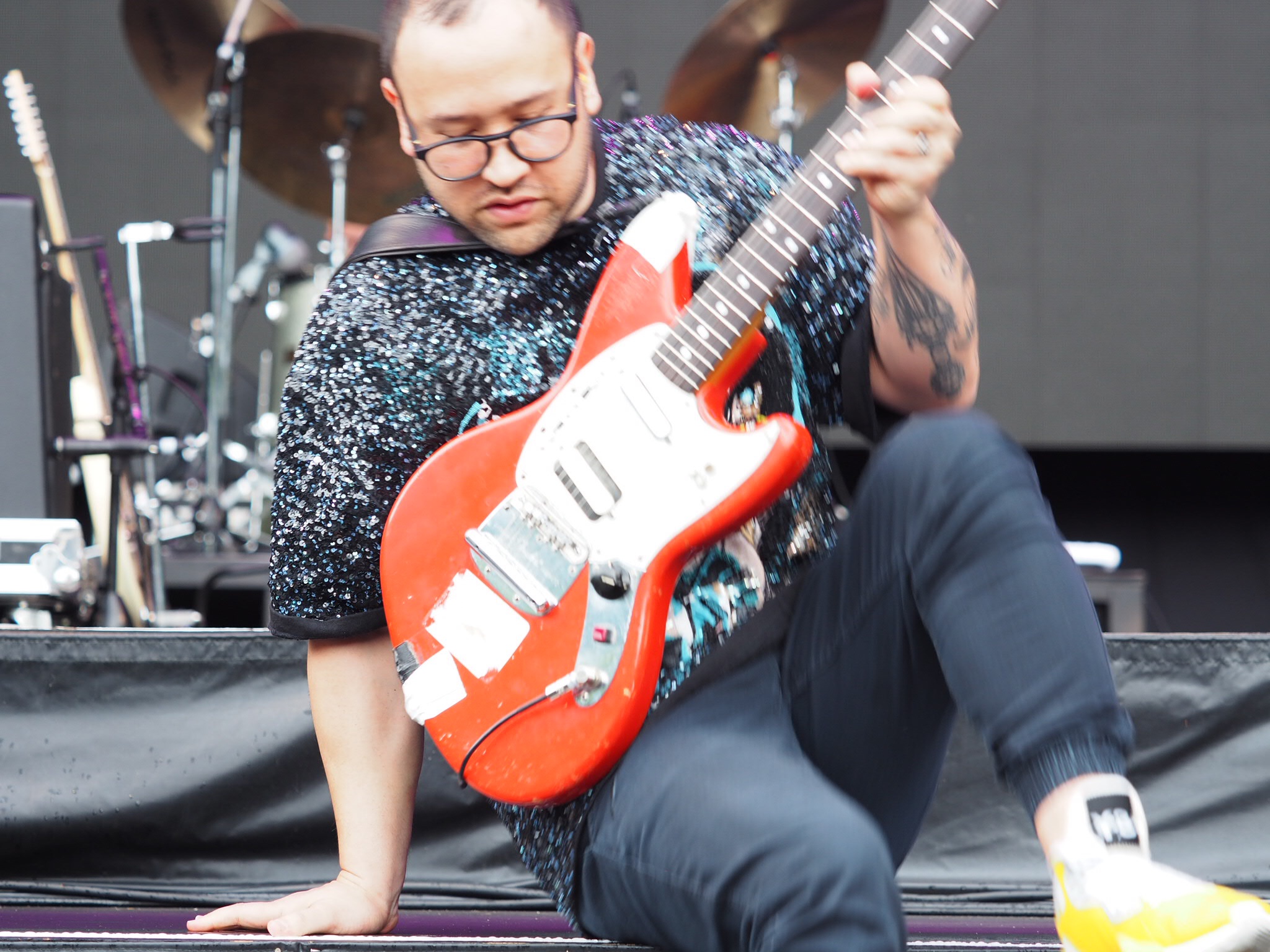
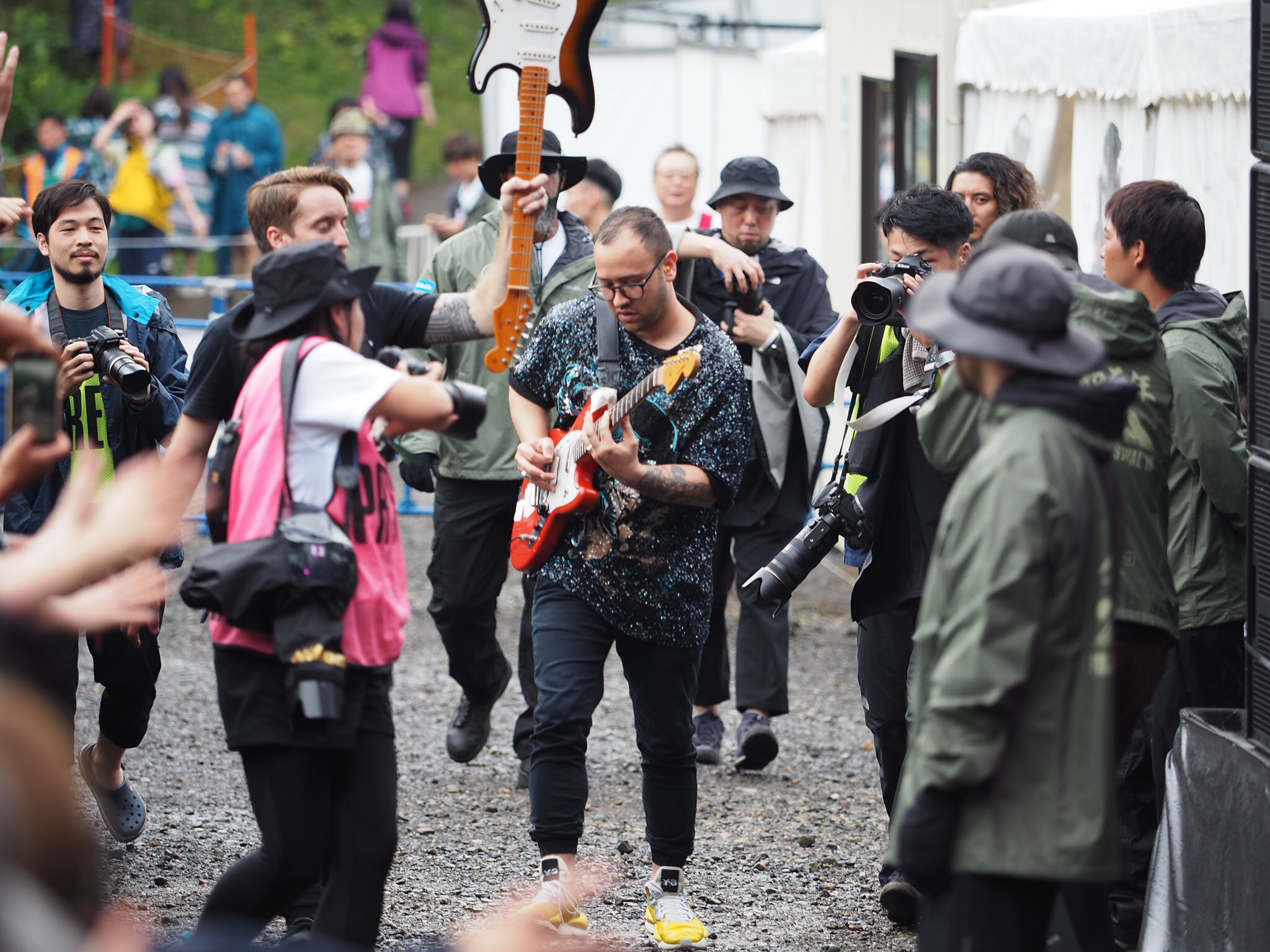
The band they reminded more than any was probably Steely Dan, not so much in terms of sound but rather ambition. The tricky time and key signatures should indicate pretensions of a less laudable sort, but UMO pulls them off so seamlessly you don’t register them as “difficult,” and there’s a Top 40 vibe to Nielsen’s songwriting that makes you wonder if he would have been a star if he’d come up in the ’70s instead of the ’90s or ’00s. As it is he’s just another indie mensch who tends to get misclassified.
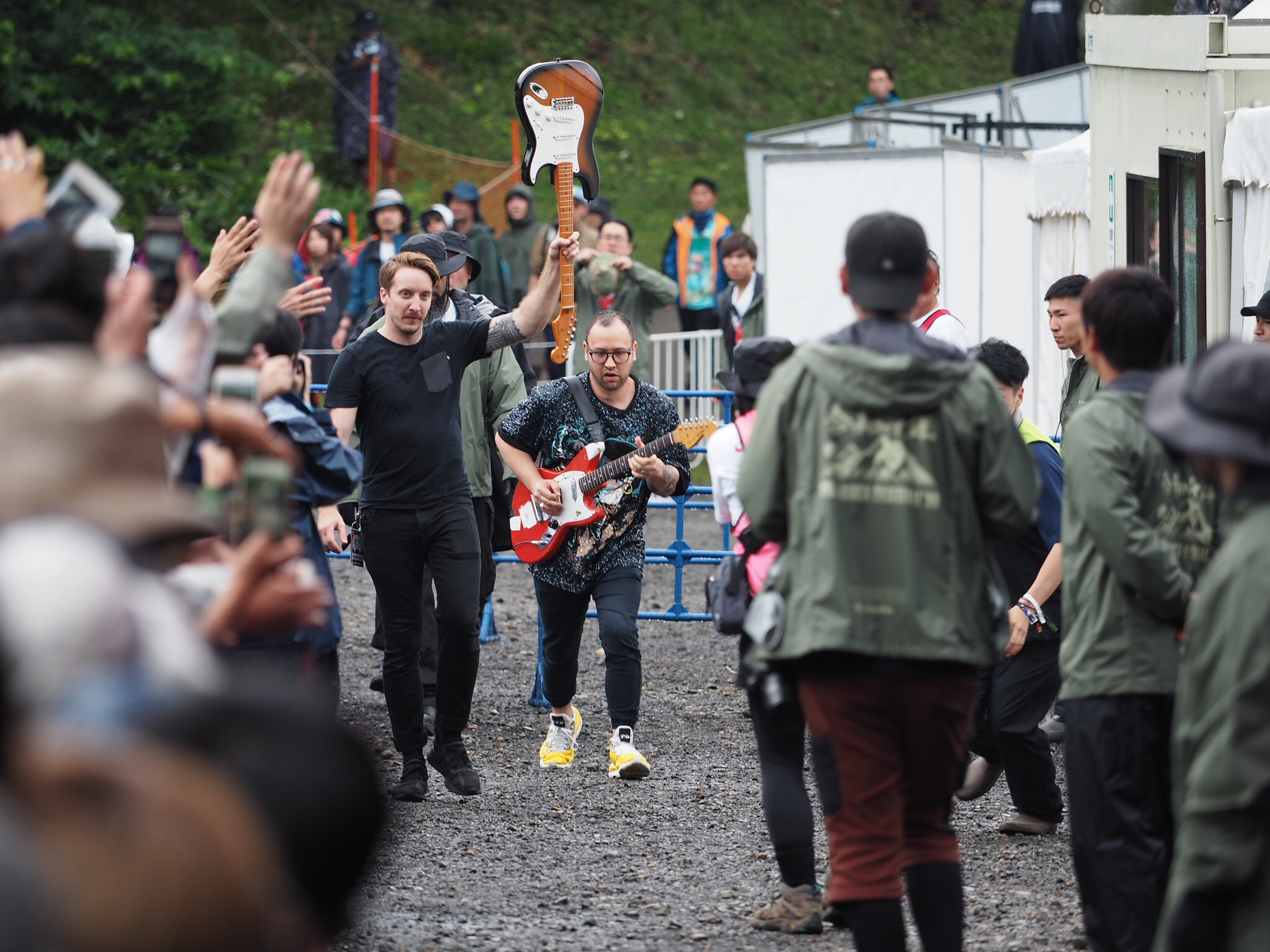
And if it’s any consolation to him, I did see one white dude mouthing the words to “So Good At Being In Trouble,” so obviously Nielsen’s reach is longer than I thought. And when he tried an Elvis move that weirdly turned into a JB move you know he yearns for the kind of pop popularity he thinks he deserves. I think he deserves it, too.
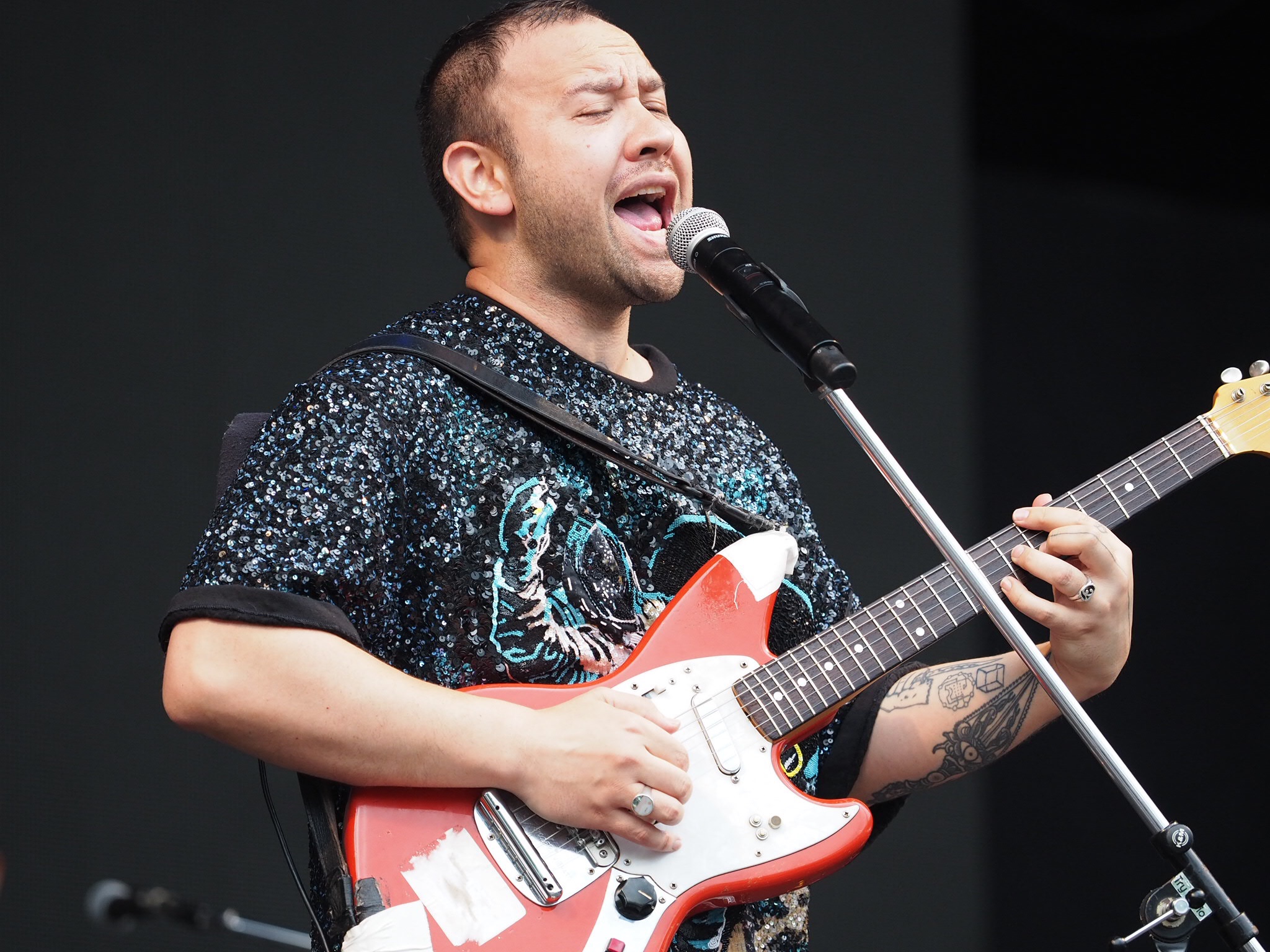

Melina Mae Duterte is a real SoCal kid, and writes like one. As Jay Som she revives the sunny West Coast sound we tend to associate with laid back guys like Ned Doheny, though in her case the songs service a much more personal, circumscribed world. She calls herself a bedroom singer-songwriter because that’s literally where she produces music, and even with a full band in tow at the Red Marquee on Saturday afternoon, she looked and sounded like a lone soul: dressed ultra casually in camo cargo pants, a loose-fitting khaki T-shirt and floppy white hat, she could have been a wannabe army reserve slacker.
Her music would have been perfect in an open air setting with the sun shining, but it was raining again, and while the shed preserved the illusion of fair weather, it put a damper on the sunny feelings. The crowd dug the groove — this is just the kind of ’70s style music Japanese kids seem to like, and while the volume and hardness of attack came and went, the melodic impact never wavered. A few people were even dancing, though Jay Som doesn’t play what you would normally call dance music. More like sway music. And every so often there was nice soaring guitar line to add that requisite rock rush. It must get real crowded in that bedroom sometime.
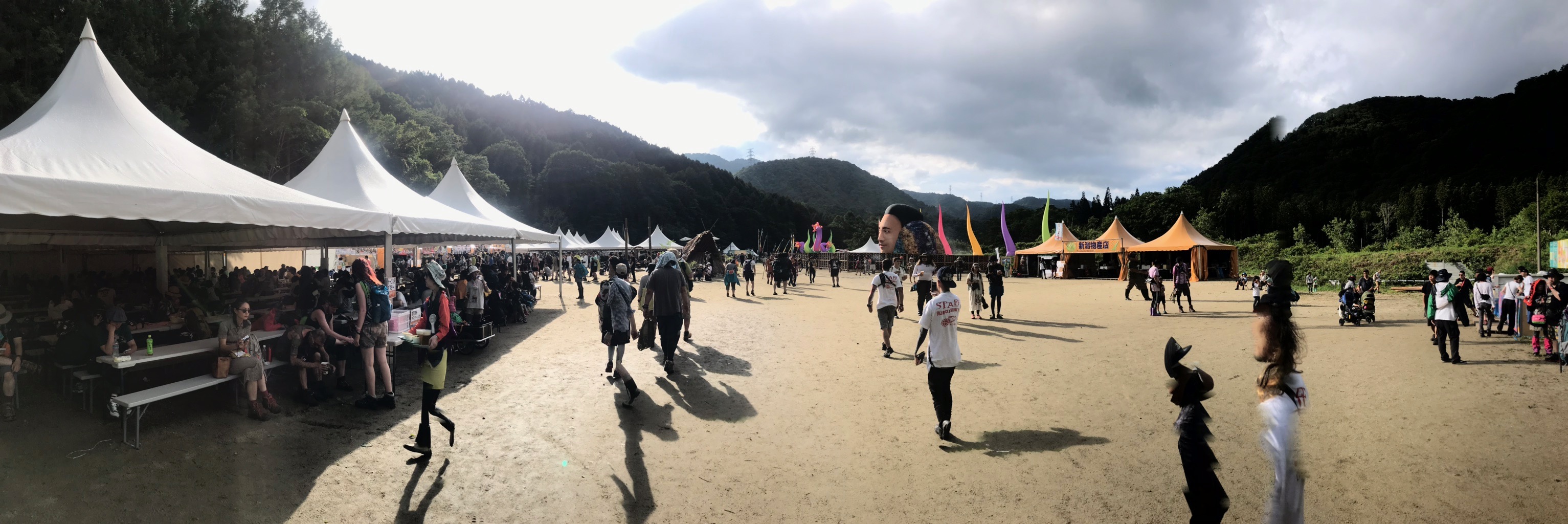



Saturday morning opened in much the same way Friday morning did: cloudy and breezy, occasionally windy, in fact. By the time Tempalay began their 11:30 a.m. set at the Red Marquee a huge crowd had set up camp in and around the shed, making it rather difficult to find even a good standing spot from which to watch the group, though, in truth, what you ended up watching was the band in silhouette against a screen of clever and often disturbing videos. The music was anything but disturbing, though maybe it was meant to be.
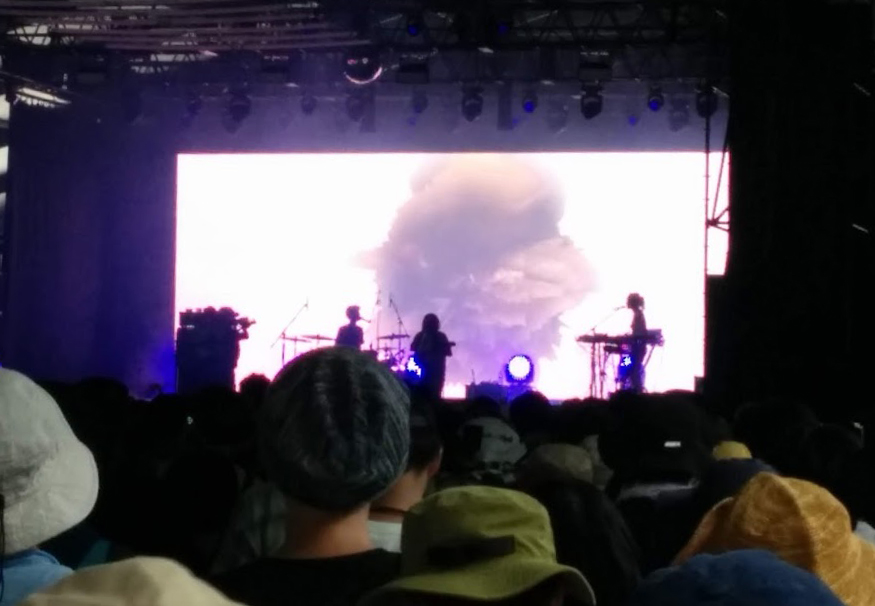
Tempalay’s raucous R&B has a jerry-rigged quality that makes you wonder if the song they’re playing is going to fall apart at any moment. The mind-frying “Sonic Wave” is cued to nursery rhyme couplets that bleed over into rap, while the purposely sloppy guitar lines challenge the assumption that this is some kind of earnest jam. At one point, in fact, things did fall apart and the band had to take a break to deal with an unexplained technical issue, thus giving them an opportunity to joke with the audience about the administration of Fuji Rock and their own very small part in making it a wonderful festival — or something like that. (They emerged from the Rookie A Go Go Stage in 2015)
Which is to say, Tempalay works to subvert logic. vocalist-guitarist Ryoto Ohara’s playful falsetto is the only really emotional tool in their sonic armory, most of which is aimed squarely at the funny bone. In interviews the band says they want to make the audience at least a little uncomfortable, and I’m not sure they succeeded on Saturday morning. Nobody left during the set, and after it was over, smiles were all you saw.
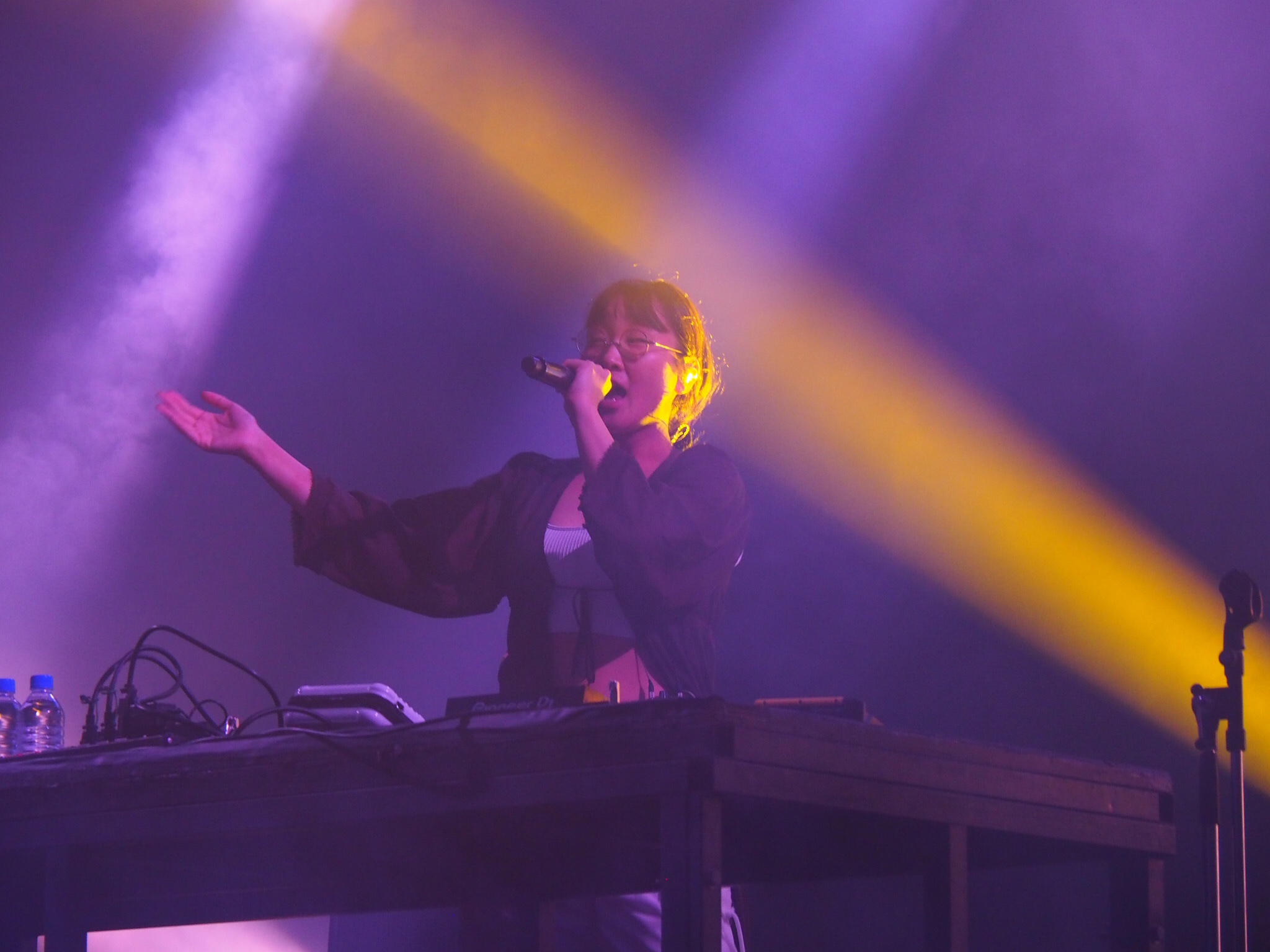
Kathy Yaeji Lee, who goes by her given Korean name as an artist, was clearly happy to be at the Red Marquee a bit after midnight. It was her first show in Japan and despite the almost narcotic quality of her brand of house music, she exuded excitement, prowling the stage and sing-speaking, sometimes even whispering, her personal stories about being a Korean-American woman in the 21st century.
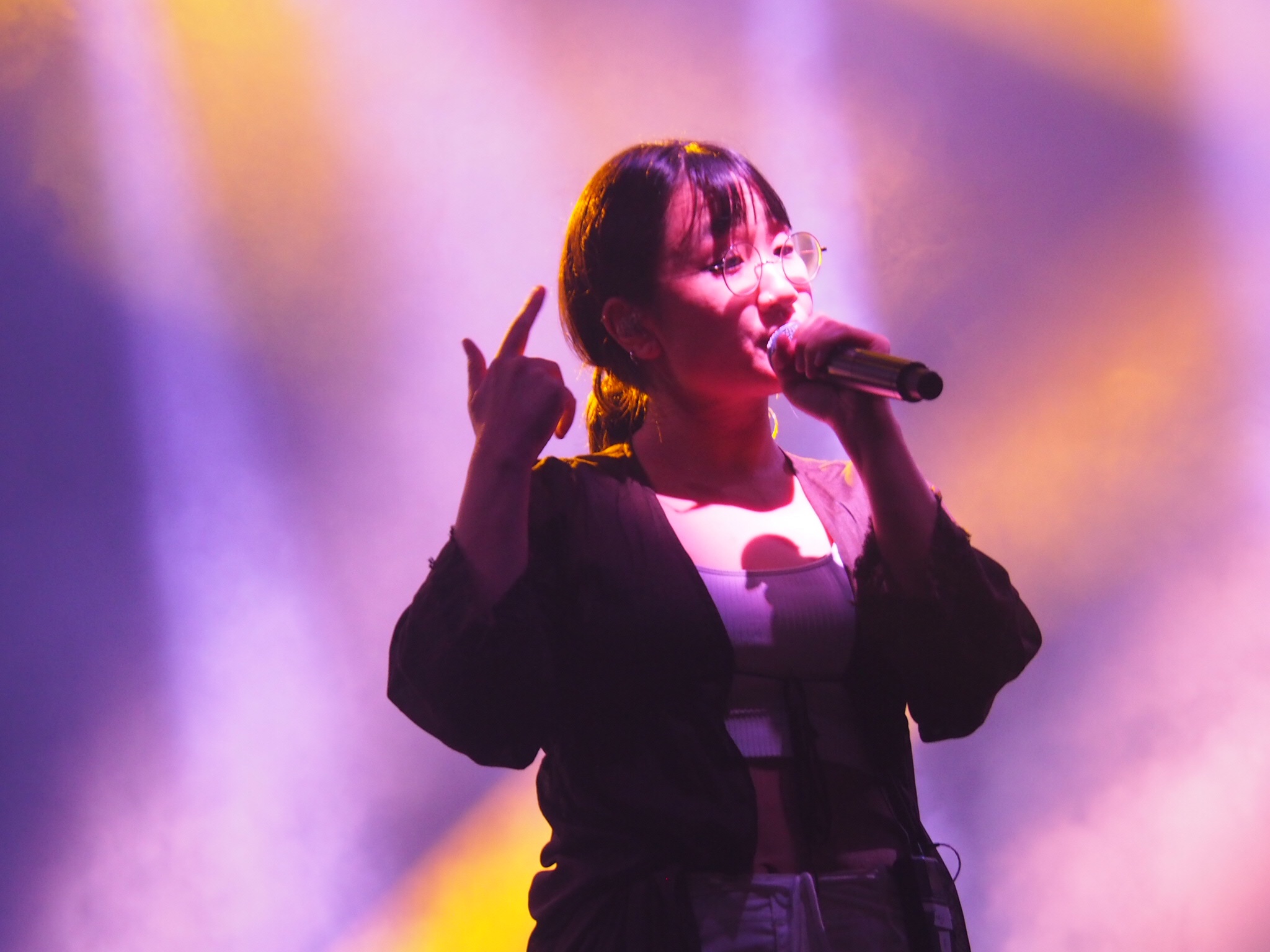
Since it was raining, the venue was probably more crowded than it would have been otherwise, and the hushed quality of the audience’s attention was almost creepy, as if they’d been hypnotized. And there is only so much Yaeji can do with her unusual sound unless she breaks into dance mode, which she approached but never to the extent that people were going to start moving with any kind of exertion. She successfully brought you into her dream, the effects of which lasted longer than I would have expected. Or maybe I was just sleepy.
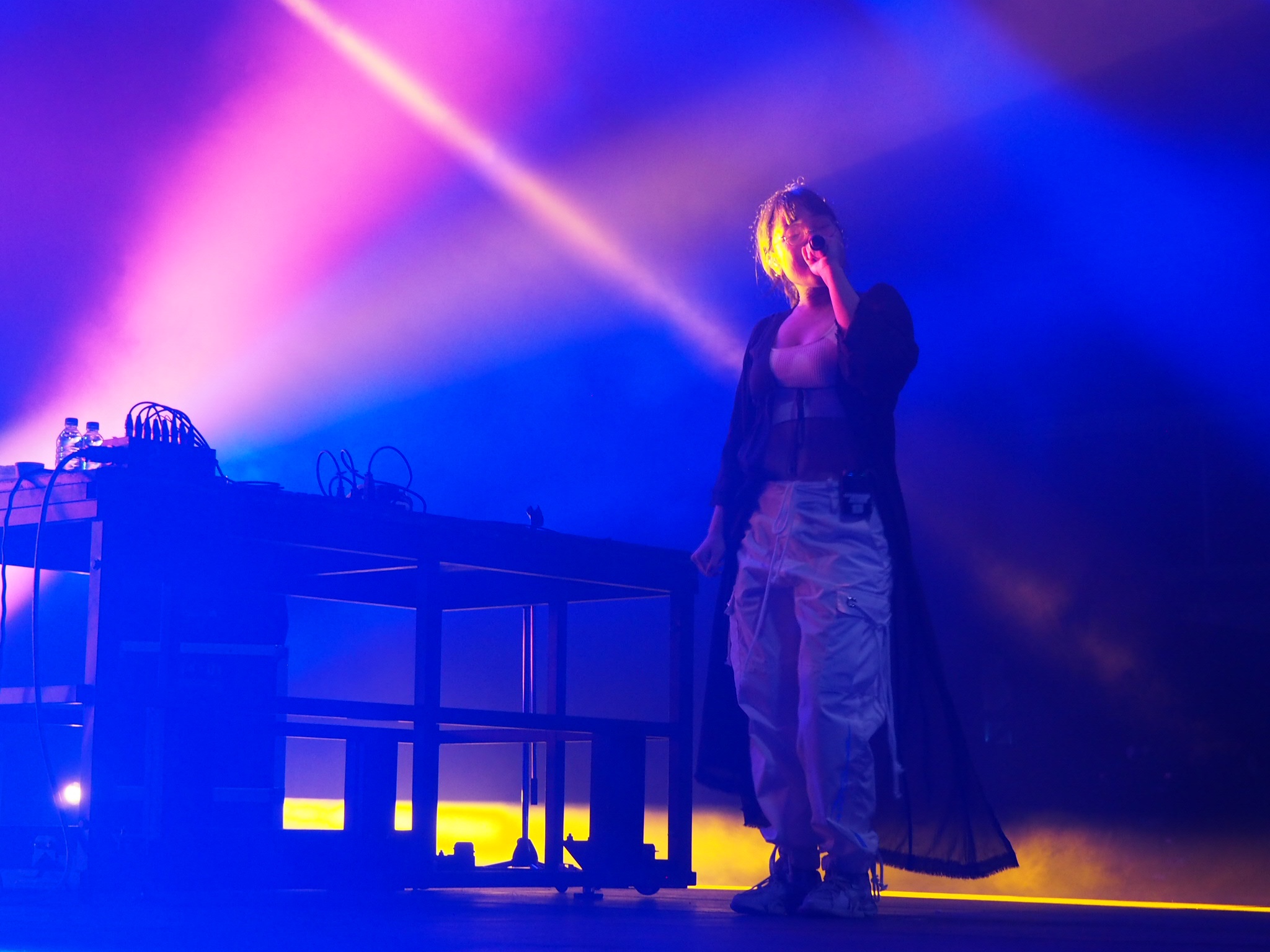
As the skies started to really open up, Fuji Rock fixture Gaz Mayall stepped behind the turntables and just happened to have the perfect song. HOW did he KNOW it would actually RAIN? Uncanny.

As the leader of Radiohead, arguably the most influential rock group of the last 20 years, Thom Yorke has both invited expectations and confounded them. His headlining set at the White Stage on Friday seemed to prove this. It seemed odd that his set was sparsely attended at first, though after the Chemical Brothers finished their own set over at the Green Stage, the audience swelled appreciably. And yet, no one displayed a particular compelling interest in what Yorke was doing. They were fascinated, but also perplexed.

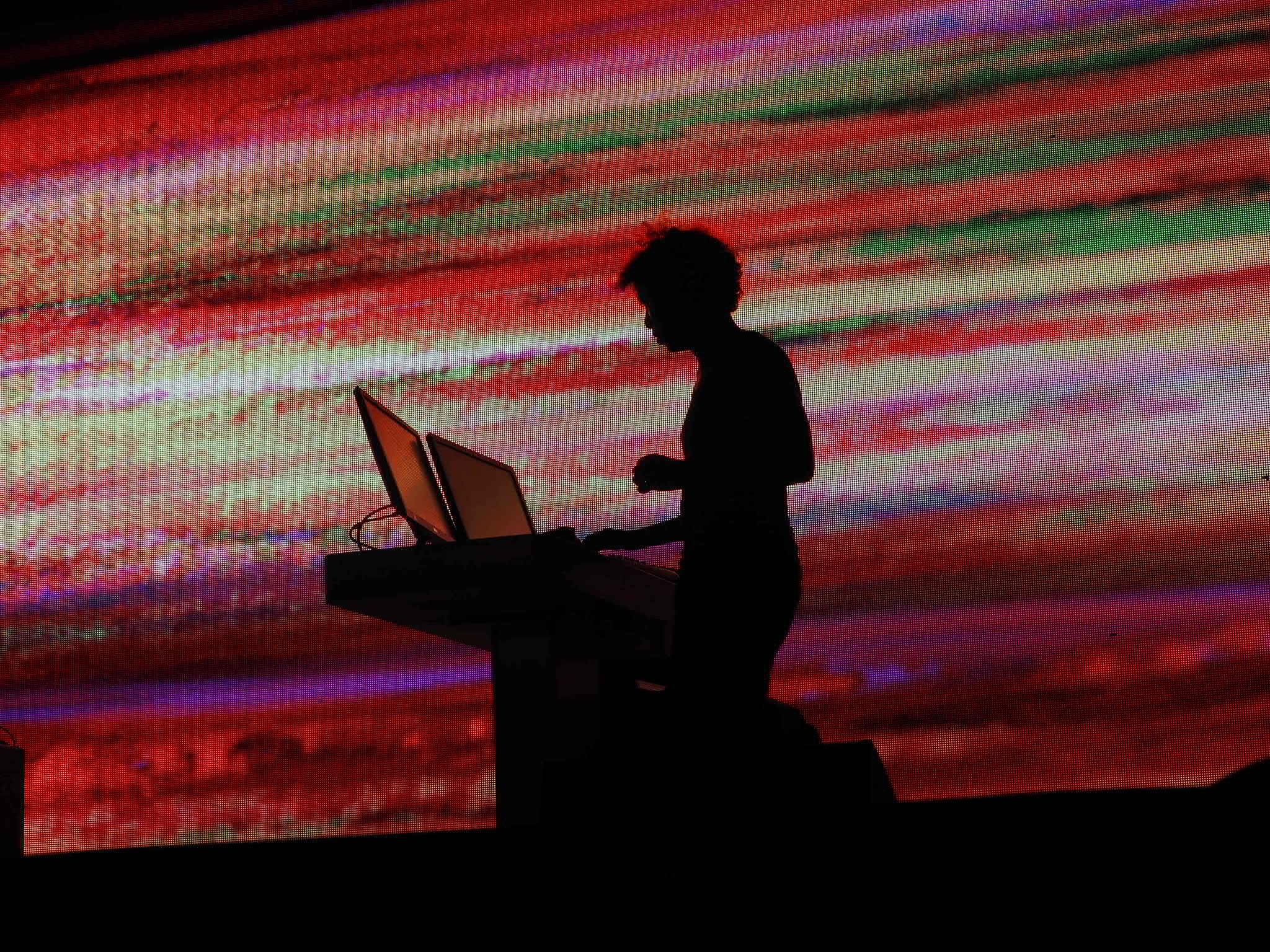
Yorke is a god of technology. He uses his musical interests to further the form, and his fans indulge this pretense. For the first half of the performance, Yorke was absorbed in the process of making difficult music, clearly acting out on stage, spinning about, dancing ecstatically, playing his bass while co-conspirator Nigel Godrich made good on his musical ideas. There was no drummer, but somehow the pair made a rhythmic pulse that permeated the audience. We were transfixed, even if we didn’t know why.

No one would mistake the Yorke show for a Radiohead performance, though I Imagine that a few attendants may have been expecting as much. It was fluid and startling, anti-pop that made good on the prospect that pop would survive.
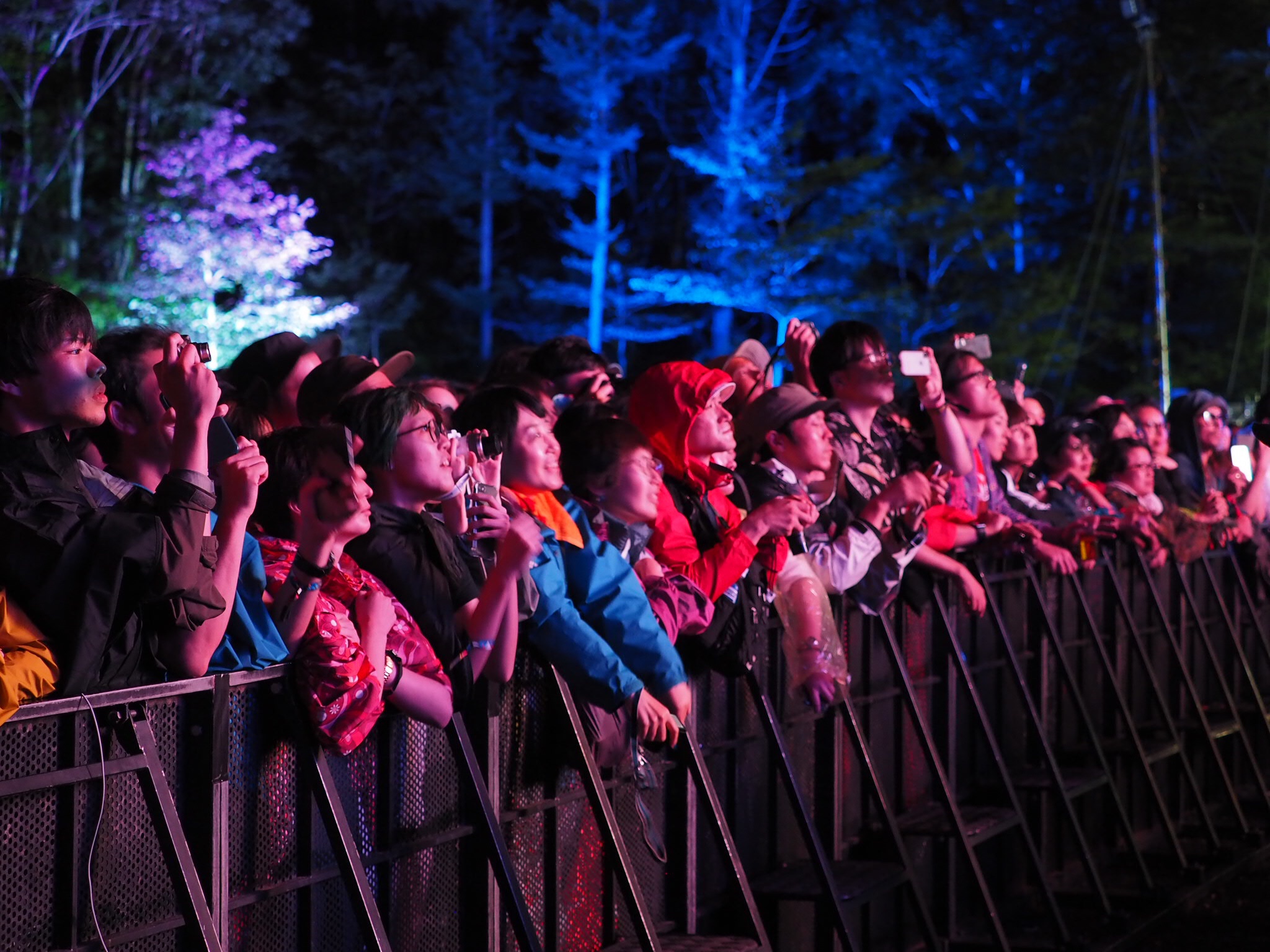
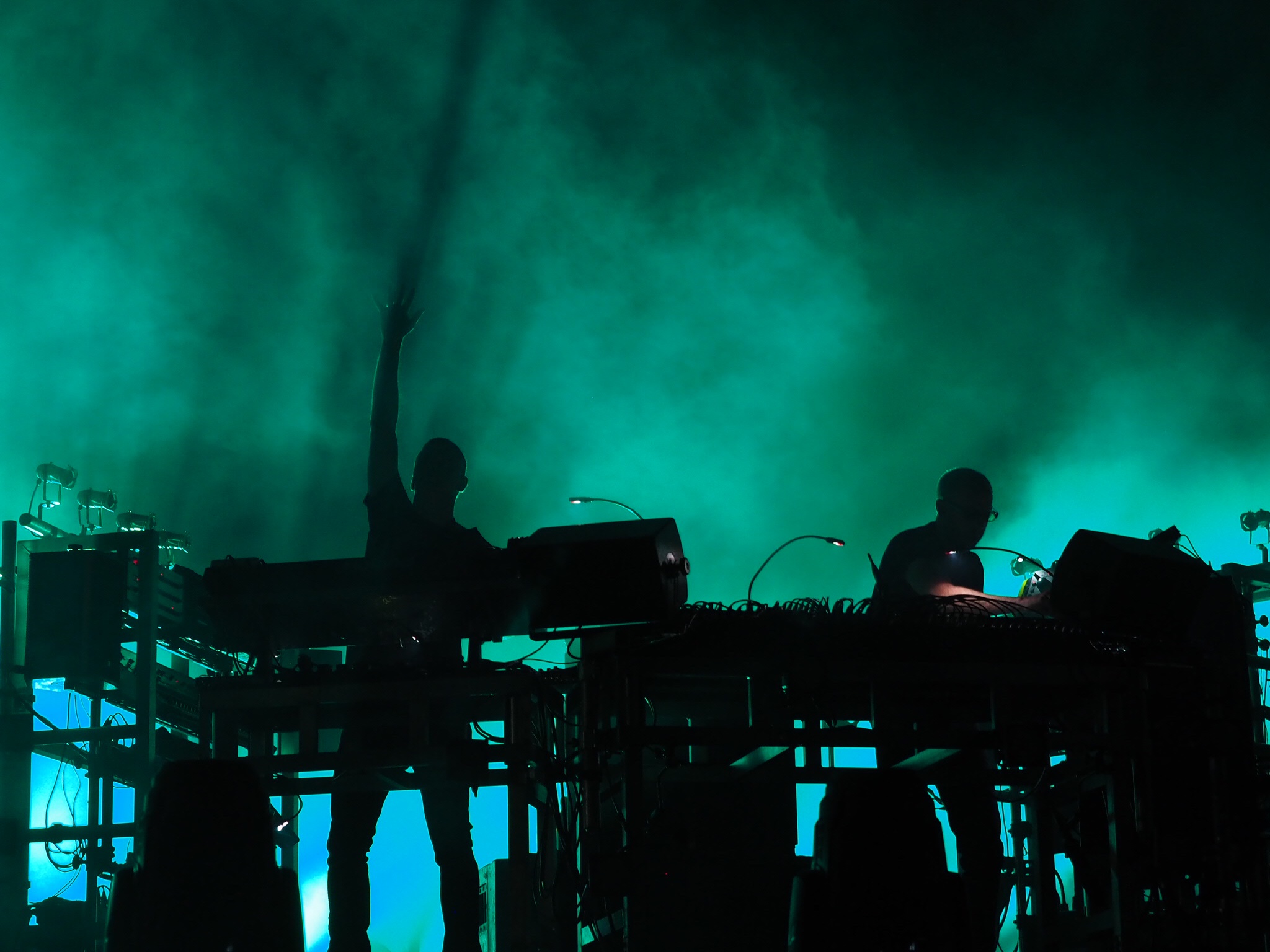
While I was walking to the Chemical Brothers set at the Green Stage, a lot of people passed me, apparently upset that they might miss the opening notes. Some were running, but an equal number were skipping, obviously delighted at the prospect of seeing their idols.
Though I have not positive evidence, I would surmise that the Chemical Brothers have headlined the Green Stage more than any other artist, and while it would seem that over-exposure would diminish their chances, in Japan, and specifically at Fuji Rock, the exposure has only intensified their popularity, and it’s easy to see why.

Their specific style of dance music is custom built for huge fields, expansive and large-bodied, and the crowd was pumping and jumping for most of their two hour set. It’s odd. Fridays are often the odd man out at Fuji, but today was packed.

Some said it was Thom Yorke, who followed the Chemicals at the White Stage, but they weren’t that many people when Yorke’s set started. The Chemicals were the draw, and for the most obvious of reasons: They met people’s expectations in the past, and were sure to do so this time as well.